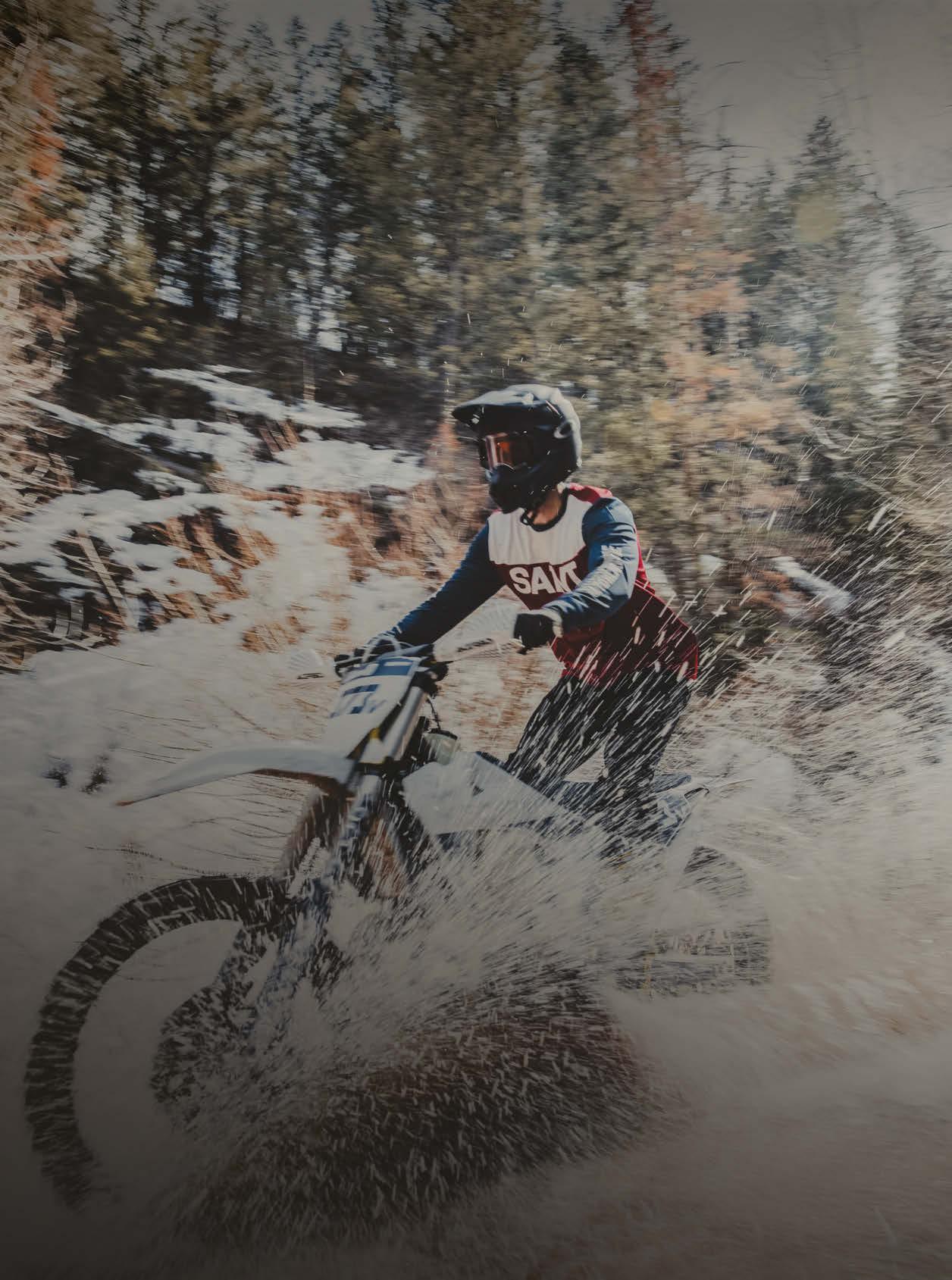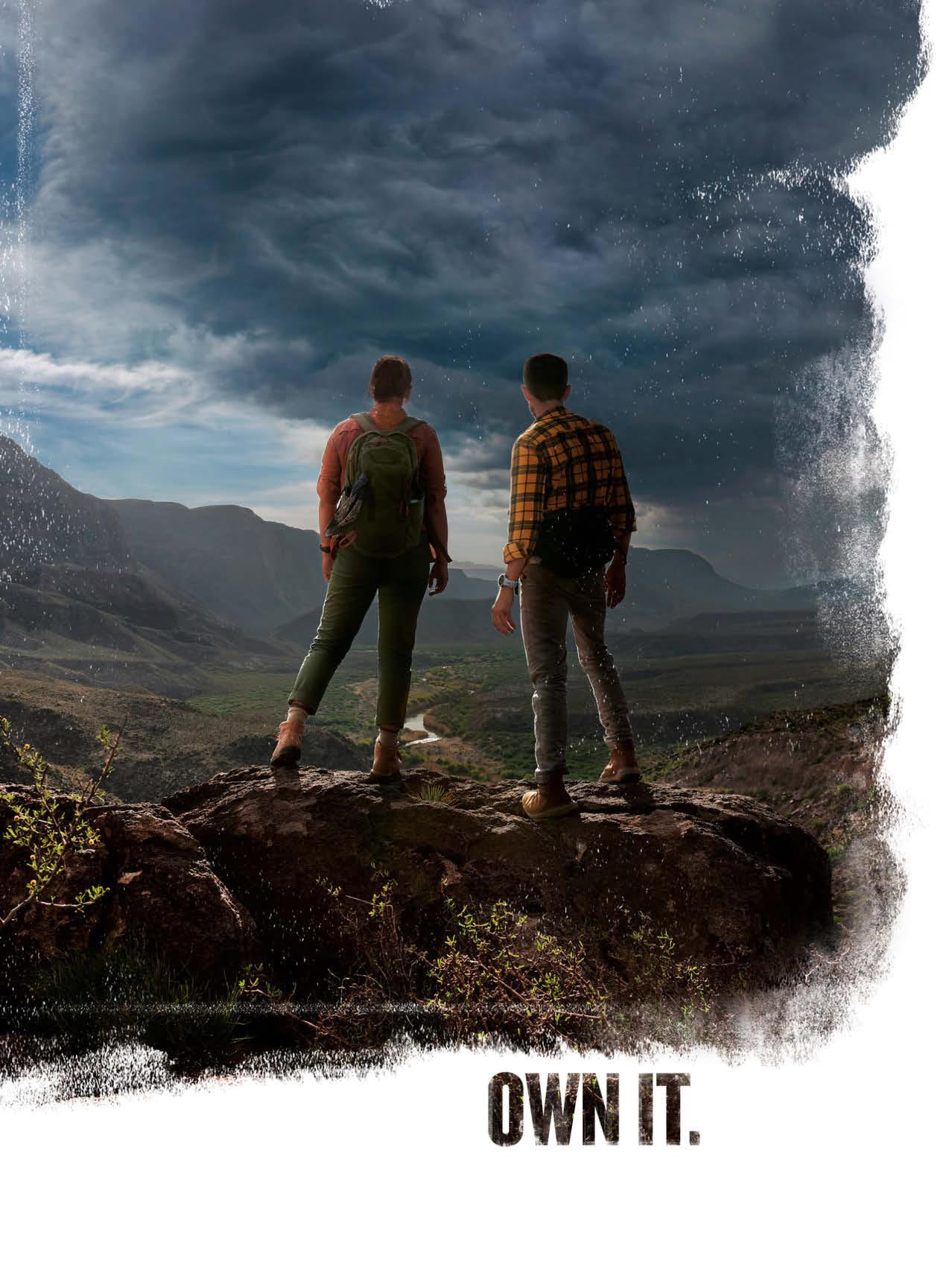PRIYA RAGU

The self-starting singer on the sound that‘s making her name









The self-starting singer on the sound that‘s making her name







WOLFGANG ZAC

The photographer, who lives between Berlin and LA, got right in the line of fire to shoot football star Trinity Rodman striking the ball for this issue. He was lucky to escape with only a shattered lens filter and a bruise under his eye. Zac has shot fashion and lifestyle for brands including Adidas and Vanity Fair Page 52
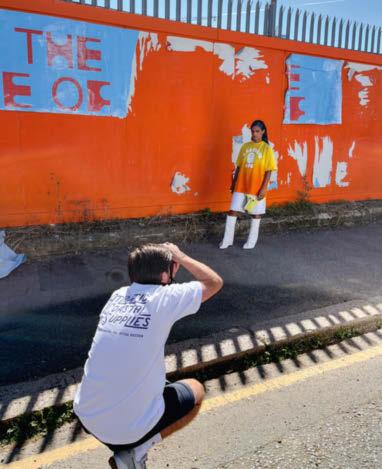
DANIEL BROWN
The San Francisco-based senior editor for The Athletic found his first dive into esports – detailing last year’s League of Legends World Championship – to be familiar ground. Especially its protagonists, Deft and Faker. “Single-minded focus seems a hallmark of all GOATs. Being the best means wasting neither time nor words.” Page 40


No 10-year plan? No problem. This month’s issue is flled with people who bypassed traditional milestones on the way to serious success. Having suppressed her inner pop star for years in favour of a ‘proper’ job, our cover star, Tamil-Swiss singer Priya Ragu, has found fame after 30. She tells us how she fnally made her voice heard. US football star Trinity Rodman has always been into goals of a different kind. She’s used her fancy footwork to forge a unique path, becoming the youngest-ever player drafted into the National Women’s Soccer League, and representing her country at a FIFA World Cup in only her third season as a pro. And we head to the Super Bowl of gaming, the League of Legends World Championship, where player Deft – his gaming career epitomised by very public failure – turned it all around in an epic team battle with a fairy-tale ending that had thousands of die-hard fans out of their seats. Enjoy the issue.
The award-winning photographer always aims to bring energy and authenticity to his work. And when he met Priya Ragu in north London for our cover story, he wasn’t disappointed. “Priya was great fun. She’d give anything a go, so we leaned into this positivity to create beautiful images full of spirit.” Page 30
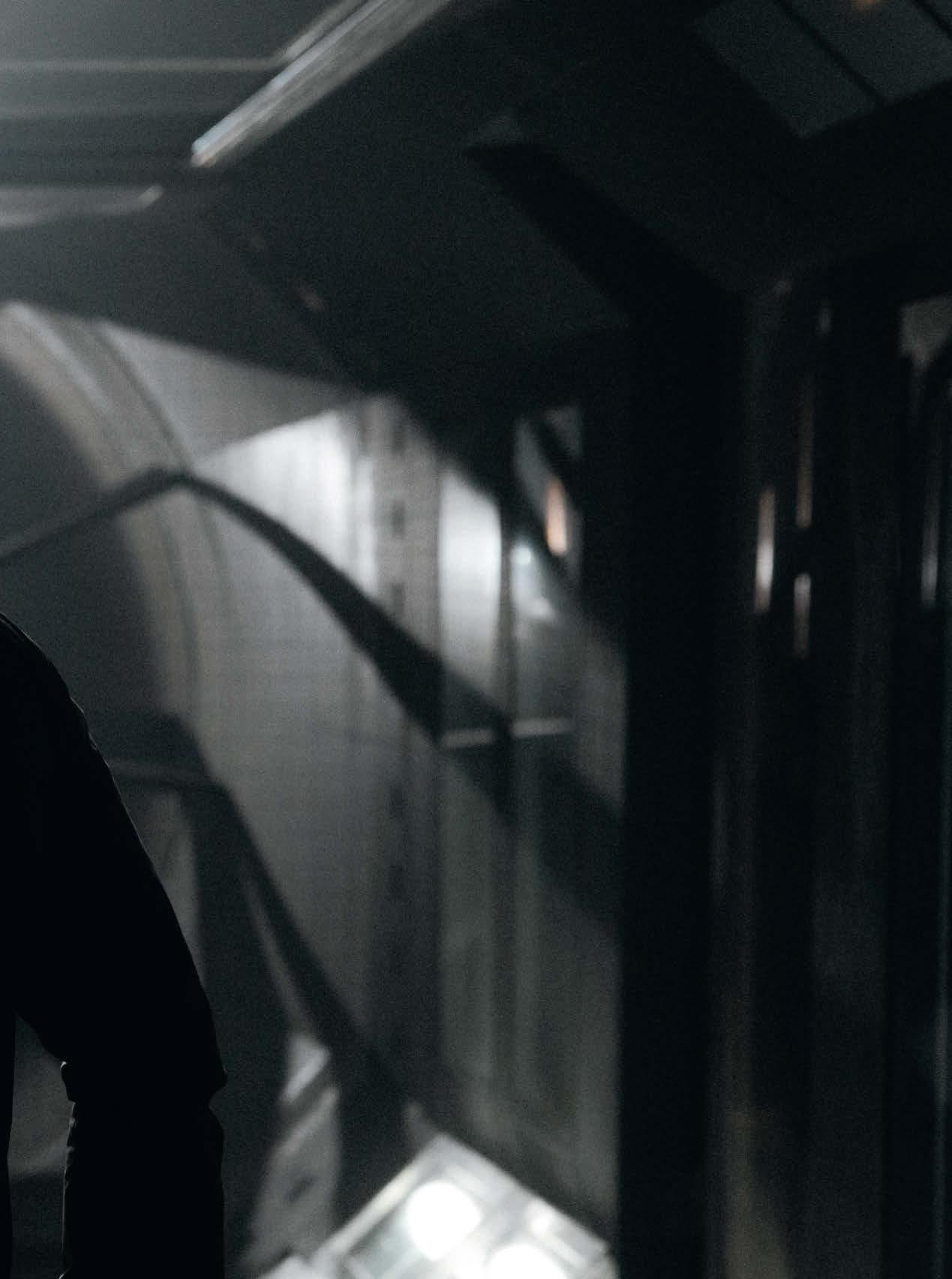



GALLERY 8
15
URBAN REEF 22
HEROES
DWAYNE FIELDS 24
Growing up, this adventurer’s goals were poles apart from those of his peers – here’s how he reached them
CARLA MOLINARO 26
The record-breaking ultrarunner on motivation, mental barriers and being “too old for Team GB”
JELLY ROLL 28
This Tennessean’s tale of redemption – washed-up jailbird to chart-topping singer – reads like a flm script
MUSIC
PRIYA RAGU 30
Struggling to reconcile her Tamil upbringing with the R&B and hip hop she loved in secret, the singer quit music for a desk job. It was only when she channelled both into her songs that everything clicked
GAMING
LEAGUE OF LEGENDS 40
Inside the gaming championship livestreamed to millions worldwide, where competitors bag seven-fgure sums and rivalry cuts deep. It may be known as LoL, but this is no joke

FOOTBALL TRINITY RODMAN 52
The breakout star of the USWNT who shook off the burden of her sporting pedigree and let her supernatural ball skills and ferce work ethic – on and off the pitch – do the talking

CULTURE BREAKING 60
How to win Red Bull BC One: fve world-beating breakers share their expert thoughts. Plus, the scores on the foors – an insight into the criteria behind the judges’ decisions

Like many of the best skateboarding spots, Texas Beach Skate Park (pictured) is a DIY project. A former basketball court, the space has been redeveloped by local skaters and volunteers in Virginia’s state capital. In his film Greetings From Richmond, director Jonathan Mehring immortalises the city’s “rough and crusty” skate spots and those who ride them. Here, Josh Viles performs a ‘Madonna’, a move invented by a blonde cultural icon and screen star… that’s right, Tony Hawk. Watch the entire two series of Greetings From films at redbull.com
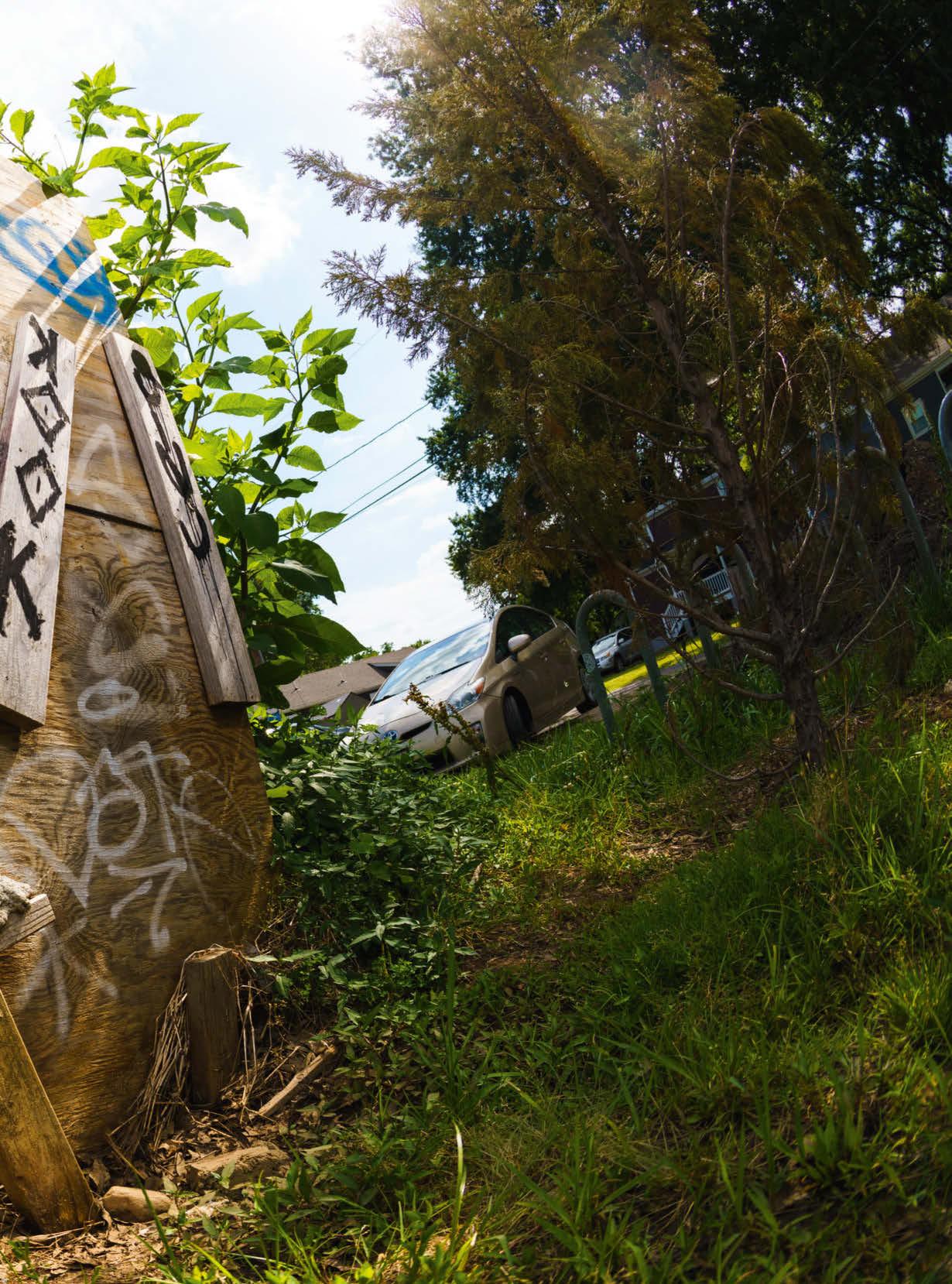
For Jaan Roose, things are always looking up. And by ‘things’, we mean the folk below. Here we see the Estonian breaking the record for the longest single-building slackline crossing – 150m, between the twin Katara Towers, at a height of 185m – this June. “The weight of the LED lights [in the 2.5cm-wide line] introduced a different dynamic to its behaviour under my weight,” he says. “It felt like skateboarding on a tree trunk rather than a lightweight board.” Nice view, though? redbullcontentpool.com

Takachiho, Japan
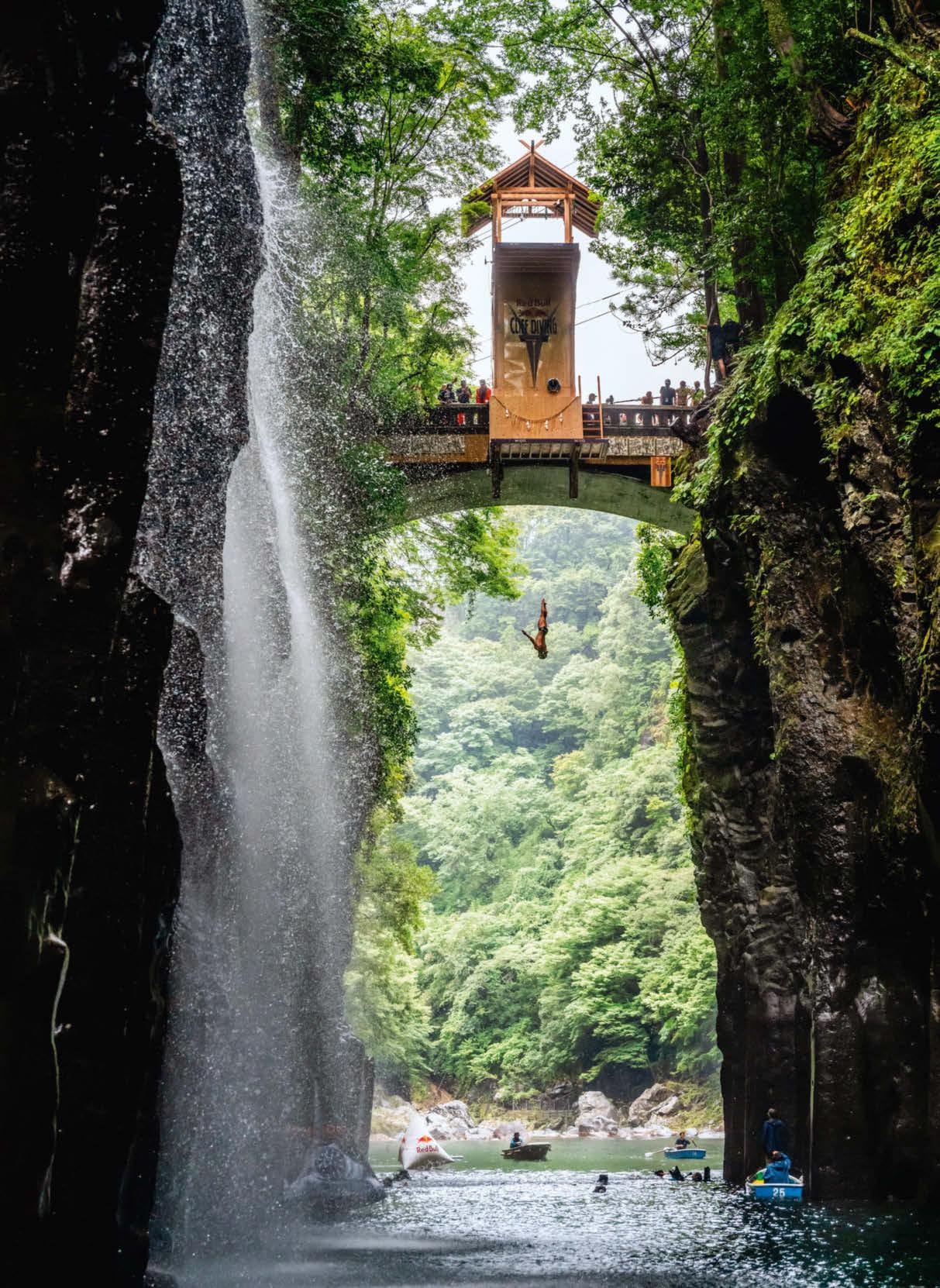
There’s nothing like a spot of sightseeing when you’re abroad. It’s no different for a professional cliff diver – though the sight is usually an expanse of water hurtling towards you at immense speed. During the Red Bull Cliff Diving World Series this August, Australian ace Rhiannan Iffland (pictured) stretched her winning run to 11 with a whistle-stop tour from a 21m platform above Japan’s Takachiho Gorge and into the river Gokase below. Japanese mythology tells of how the sun goddess Amaterasu Omikami once hid in a cave in the river’s banks following a tiff with her brother. With skills like this on show, even a deity wouldn’t be able to resist a peek. redbullcontentpool.com
One year. That’s how long there is to go before the 37th America’s Cup kicks off on October 12, 2024. But competition is already heating up. Here, two Alinghi Red Bull Racing AC40 boats train ahead of the first preliminary regatta, which took place in nearby Vilanova i la Geltrú in September. In November, the boats head to Jeddah, Saudi Arabia, for the second pre-regatta, followed by the final one next year – raced in the main event’s larger AC75 boats on the waters off Barcelona where the actual America’s Cup will take place.
Find out more about Alinghi Red Bull Racing in the America’s Cup on page 82


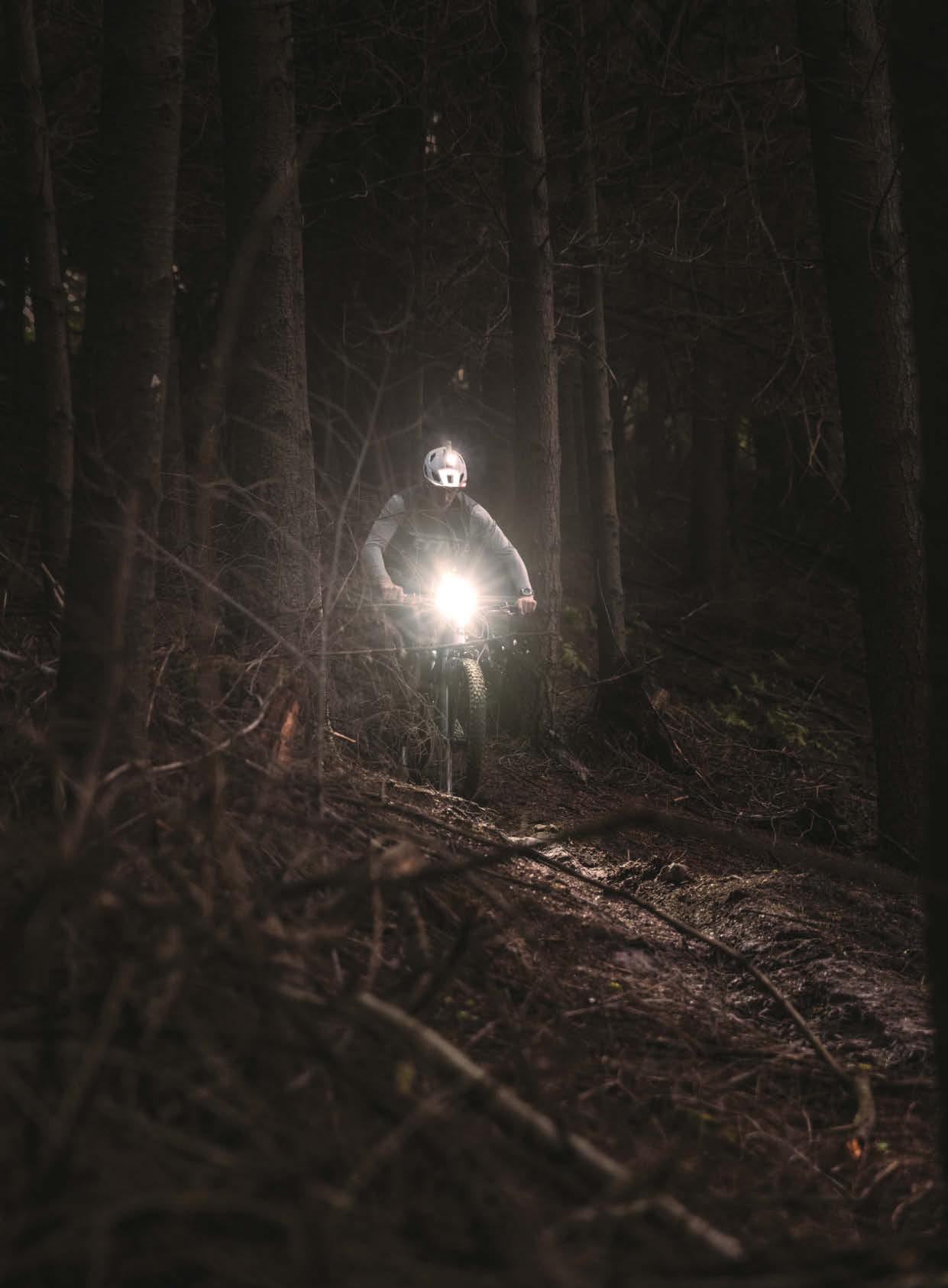


the day ends, the fun begins.
The face of Fall Out Boy selects four tracks that helped him bring pop-punk to the masses
Formed in Wilmette, Illinois, pop-punk four-piece Fall Out Boy provided the soundtrack for an emo generation in the noughties, releasing albums such as Infinity on High and singles including Thnks fr th Mmrs (both 2007), and touring stadiums worldwide. Bass player and lyricist Pete Wentz (pictured second from right) has been the face of the band since their inception in 2001. In subsequent years, he has branched off into various side projects – opening a dive bar, launching a fashion label –alongside his duties with Fall Out Boy, who released their eighth studio album, So Much (for) Stardust, this March. Here Wentz, now 44, selects four songs that played a pivotal role in shaping the band’s distinctive sound. falloutboy.com

Guns N’ Roses

Live and Let Die (1991)
“Guns N’ Roses were a band that were really impactful for me. Before, I’d listen to whatever my parents were playing, and this was the first band I picked for myself. This was the era when they put out Use Your Illusion [two double albums, released separately]. Live and Let Die is a great song, and it’s also a cover, so I’m getting Paul McCartney in there as well.”
Gorilla Biscuits

Start Today (1989)
“Watching [New York hardcore punk band] Gorilla Biscuits play was the first time I realised that [anyone] could be on stage – because the stage was only about three inches off the ground. [Laughs.] Literally anyone could get on there. But Gorilla Biscuits were an awesome band, and a huge musical influence on me. This is one of their best songs.”
Green Day Basket Case (1994)

“There’s a direct line through Green Day [to us]; we wouldn’t have been able to route ourselves without a band like that. I remember seeing the video for Basket Case, where Tré [Cool, the band’s drummer] is in the wheelchair, and I just thought it was insane. It was insane to me that this song was on MTV, and that a band like this was what they were.”
Jay-Z

99 Problems (2004)
“Jay is someone I really look up to. He was the president of our record label for a while when we were signed to Island/Def Jam. He’s like a poet who has swagger, and he created a whole culture. He somehow found a way to stitch the Beastie Boys and old Blueprint-era Jay-Z together in one song. That’s why I love it.”
Meet the artist who weaves together Welsh crafting and Afro hair styling techniques to tell stories of her dual heritage

When Anya Paintsil was six years old, her grandmother noticed she had a passion for art – and a surplus of energy. Seeing how her granddaughter spattered paints around their North Wales home and filled pages with doodles, she suggested they sit down together and try a slower and more thoughtful form of artwork: textiles. She taught the young girl traditional techniques she’d learnt during her own childhood, such as punch needle and latch hooking, and guided her through hours of crafting rugs and textile pieces.
What she might not have predicted during those lessons was that they’d serve as the foundation for her young granddaughter’s future calling. Now a 29-year-old award-
winning artist, Paintsil creates profound and playful textile art inspired by those days with her grandmother and exhibited in galleries across the UK. Having grown up near the Monmouthshire town of Abergavenny, in a household that spoke Welsh but was also
heavily influenced by the culture of her Ghanaian father, Paintsil channels both elements into her work. “Creation emanates from the person you are, and this is simply who I happen to be,” she explains. “If I was totally Welsh or totally Ghanaian, my work would be different. Examining points of convergence and similarities, particularly between Afro hair styling and my traditional art practice, feels intuitive to me.”
In her teens, as she began to style her own hair, Paintsil was struck by the similarities between Afro hair techniques and traditional textile practices. She began to incorporate real and synthetic hair in her work – often her own hair, as well as her old extensions – to explore and challenge the disparity between how the two skills are appreciated.

“Afro hair styling, which includes braiding and twisting, represents highly skilled and culturally significant elements of heritage while at the same time possessing beauty,” she says. “But within a hairdressing context these skills are often underappreciated. Ensuring that hair serves a purpose beyond decoration was important to me in the work; Afro hair styling can reveal a great deal about an individual.”
Paintsil hopes that her work will provoke questions about what type of art is considered worthy of a gallery space. “I think there are a lot of negative associations around textiles and other female or workingclass crafts, just like there are about Afro styling,” she says. “There’s so much that’s valued unequally in art. It’s not just textiles; it’s African art, it’s portraits of Black people, it’s art made by women, it’s working-class artists, it’s art made by gay people… All other artists have to kind of elevate themselves in a way that the work of the standard genius Western artist doesn’t.”
Instagram: @anyapaintsil

Developed in a unique collaboration between CUBE and BMW, the Trike Hybrid‘s sophisticated tilt mechanism is the key to keeping your cargo secure whilst maintaining the natural feel of a conventional bike. Bosch electric assist helps make light work of any route, whilst the short wheelbase and easy handling means this is a cargo bike that can be easily used by almost anyone.

We all have our favourite food scene from the movies. From the $5 shake in Pulp Fiction to the boiled lobsters in Annie Hall and the chocolate fudge cake in Matilda, food can be as powerful and sensory on screen as it is on our plate. Now, indie film company A24 has chosen 54 of the most iconic food scenes from the big screen and recreated the recipes in the pages of a cookbook, titled Scrounging
Photographed by Brooklyn creative duo Wade Jeffree and Leta Sobierajski, with an introduction from celebrity chef Matty Matheson, Scrounging investigates unsettling film-food moments and offers recipes for such memorable meals as Buddy’s breakfast spaghetti in Elf, the Thanksgiving microwave meal in Lady Bird, and Kevin’s 12scoop sundae in Home Alone
“Food is a tool in film, the same as lighting, costumes or anything else,” Matheson says in his introduction to the book. “When it comes to food, there’s always another side to the story. Whether it’s the focal point of the scene, the butt of a joke, a symbol, or clues for a character’s story, food in film is about more than just calorific intake.”
When styling and framing the book’s photos, Jeffree and Sobierajski wanted to create an unsettling feeling of chaos. “We based the art direction on the idyllic photos by [acclaimed photographers] Martin Parr, William Eggleston and Stephen Shore for tonal cues,” says Sobierajski. “[The team] wasn’t looking to recreate the films; they wanted us to set the scene for each shot... not to overdramatise, but to make the photography feel directed but perhaps shot by someone who rarely uses a camera.”
The food and props themselves were carefully curated. “One of our favourites was for the recipe of cereal with water [from the 1995 film
This unsettling cookbook from A24 is filled with meals from the movies that you will not want to recreate in your own kitchen
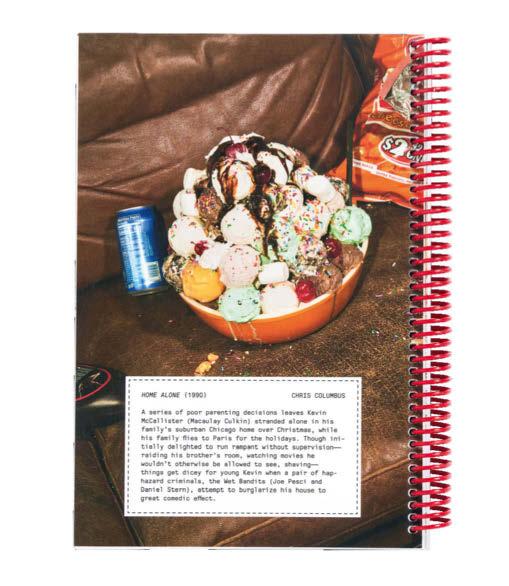

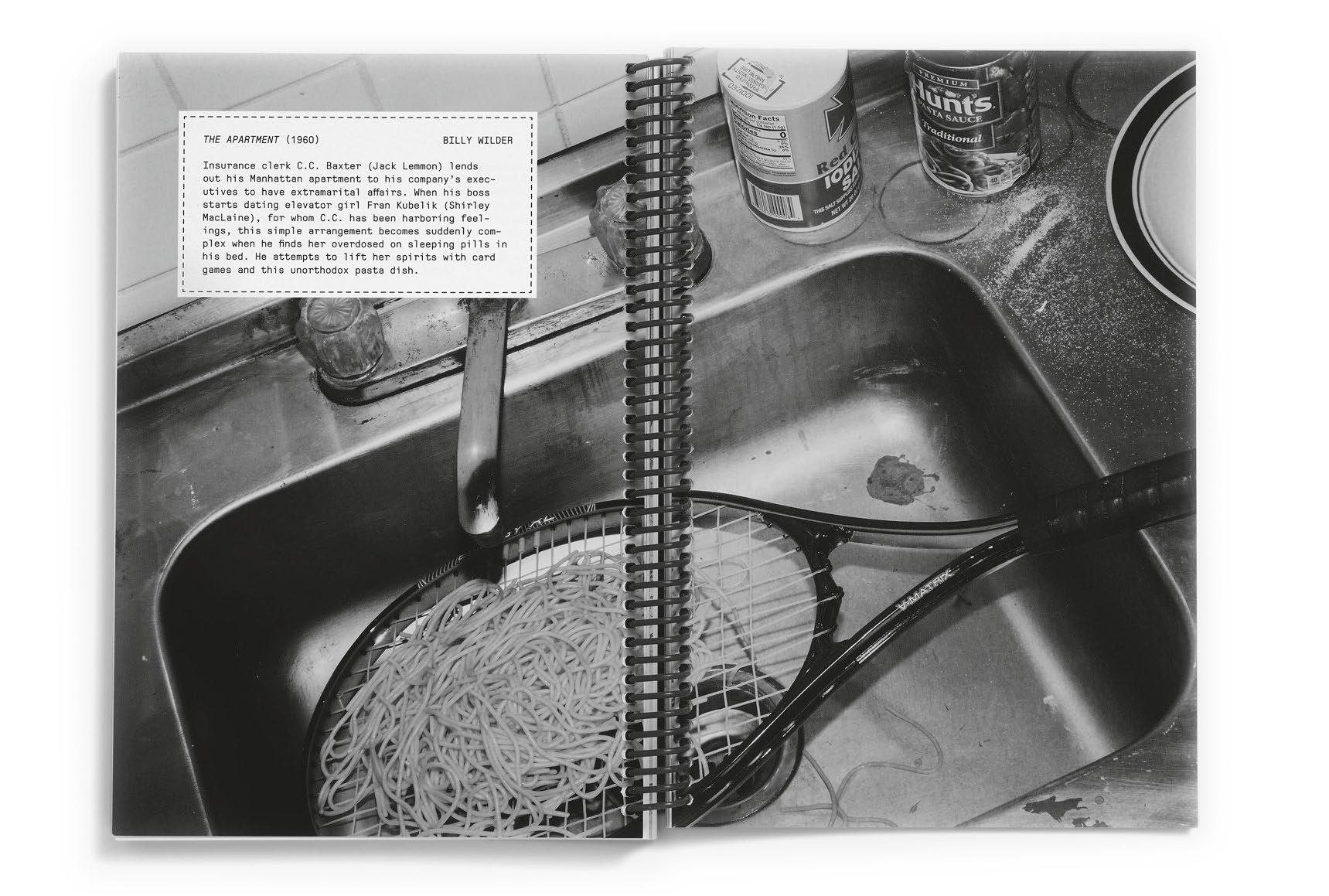
Friday]. We envisioned that this person would have just come from the gym and wouldn’t have had time to shop for groceries, so they would have used their workout water bottle to hydrate their cereal with a few pumps of water... gross.”
With a few notable exceptions that readers might be tempted to recreate – the Midnight Margaritas from Practical Magic (1998) look as good on the page as they do in the film where Sandra Bullock dances around a kitchen with one – Scrounging is less about aspirational meals and more about taking a gruesome look at some of cinema’s best-loved food-related moments.
“Eating isn’t always glamorous,” says Matheson. “Sometimes it’s thrifty, idiosyncratic, messy or weird – sometimes a little too weird. There’s often an underbelly or a slightly deranged element to eating, especially in the recipes here.”
shop.a24flms.com





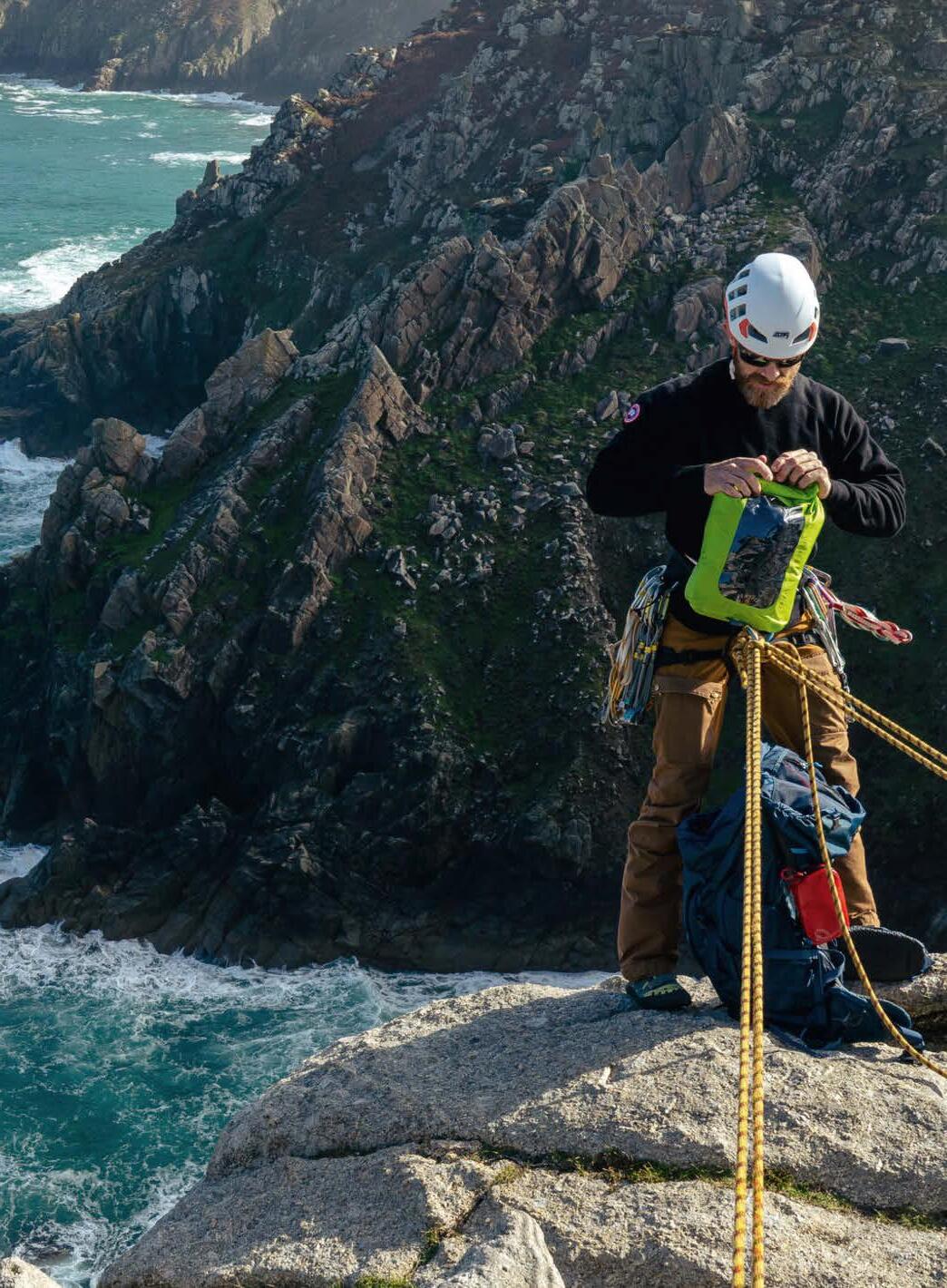
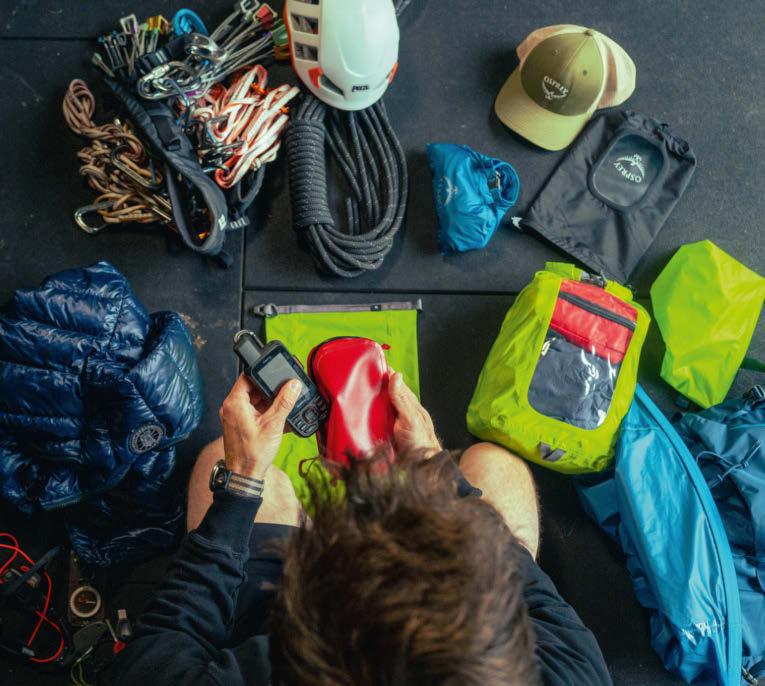

This skateboarder turned woodworker rescues old boards and transforms them into art, to capture the secret stories of their former riders
As a child, nothing made Daniel Barousse happier than rolling down the streets and grinding the curbs of his hometown –Lafayette, California – on his skateboard, losing hours and days in a happy haze.

In adulthood, Barousse built a career around his love of skating, securing a position in sales for some of the world’s biggest skate brands. He soon realised, however, that his job was missing something: that feeling of joy. So he quit and bought a van, with the aim of teaching himself woodworking and customising the vehicle’s interior for a life on the road.
Though the project was new, it gave him something back he thought he’d lost. As Barousse fitted out his van, he rediscovered though woodwork the same feeling that skating had given him as a child.
“It really is a romantic little story for me,” says Barousse, 34. “The van was my first woodworking project, and I fell in love. It was so challenging. It removed me from life and placed me firmly in the moment. I was in a true flow state, and I lost track of time. I thought, ‘Man, how can I combine this with skateboarding and make it my life?’”
Barousse turned his gaze to skateboards themselves. Looking around at the skate scene with a carpenter’s eyes, he noticed how much perfectly
from top) Barousse at Red Bull Terminal Takeover this April; his coffee table was made from more than 30 used skateboards; this sculpture of Snoopy was “a fun challenge”, Barousse says


good wood was being sent to landfill as skaters traded in their old decks for new ones at the local skate shop. So he began saving them and repurposing them into pieces of art and furniture.
“I reached out to all my friends who own skate shops and asked them to hold any old skateboards for me instead of throwing them away in the dump,’ says Barousse, “then I went around and collected them all in my van. From there, I took off the grip tape and
stripped all the stickers and residue. Gluing together stacks of 15 boards at a time, I created logs that I could use to make pieces through my usual process.”
The first piece Barousse created – a small bowl – sold instantly. From there, he started making dinnerware, furniture and jewellery.
“When I finally looked around, I realised that I’d done it – I’d made myself a life grounded in joy,” he says. “Every time I finish a piece, I sit and look at it for a second and just think, ‘How many kickflips have been made with this table? How many kids were dealing with something stressful at home or school but then picked up their skateboard, went outside and channelled that negativity into something positive, like I used to? How many of those beautiful moments exist in this piece of art?’”
barousseworks.com
our cities and teach us to live
Any city neglected by humans will eventually return to nature. Abandoned architecture becomes a canvas for the resurgence of plant life – vines weave through walls, trees breach windows, wildflowers sprout in pavement cracks – and rainwater pools form new ecosystems.

Observing the spontaneous rewilding of urban spaces around the world, Pierre Oskam began to question the absence of natural life in our working cities and wonder if all spaces could foster the same flourishing of nature. “I thought, ‘How can we give space to spontaneous ecologies to develop?’” says the Dutch designer and ecological philosopher. “In an intentional way, but without trying to control the natural world, just giving it more room to thrive alongside our day-to-day lives.”
Oskam took the idea to his friend, computational designer Max Latour, and in March last year the pair co-founded Urban Reef, a company that designs artificial habitats to encourage the growth and diversity of multiple species in city spaces.

Computational design and 3D printing is used to make these ‘reef’ habitats as receptive as possible to surrounding fauna and flora. “We delved into highly complex structures, utilising algorithms based on natural growth to encourage the growth of ecological life,” Oskam explains. “For example, the formation of salt crystals inspired behaviours within the computer that drove geometries to grow. The resulting shapes are so intricate that humans can’t replicate them manually.”
The reefs – created using man-made materials such as ceramic, or natural elements like mycelium – have capillaries to absorb rainwater, mitigate urban heat and provide a variety of microclimates and nutrients, perfect for most plants and animals to make their home. The first prototype reefs are currently undergoing testing in Rotterdam, and the company envisions a future for them in cities across the globe.

“Our ultimate goal is to integrate these reefs not only as sculptures in gardens but also into the urban planning and morphology of every city, enhancing air quality and microclimates,” Oskam says.
“We hope to challenge the conventional view of cities as lifeless environments and cultivate a stronger connection between humans and the myriad life forms that inhabit urban spaces. Our aim is to awaken a sense of environmental stewardship, nurturing a more harmonious coexistence with the natural world. Together, we can design cities that resonate with nature and deepen the connection between all of us and the environment.”
urbanreef.nl
This Rotterdam-based company wants to bring the natural world back into
with the animals
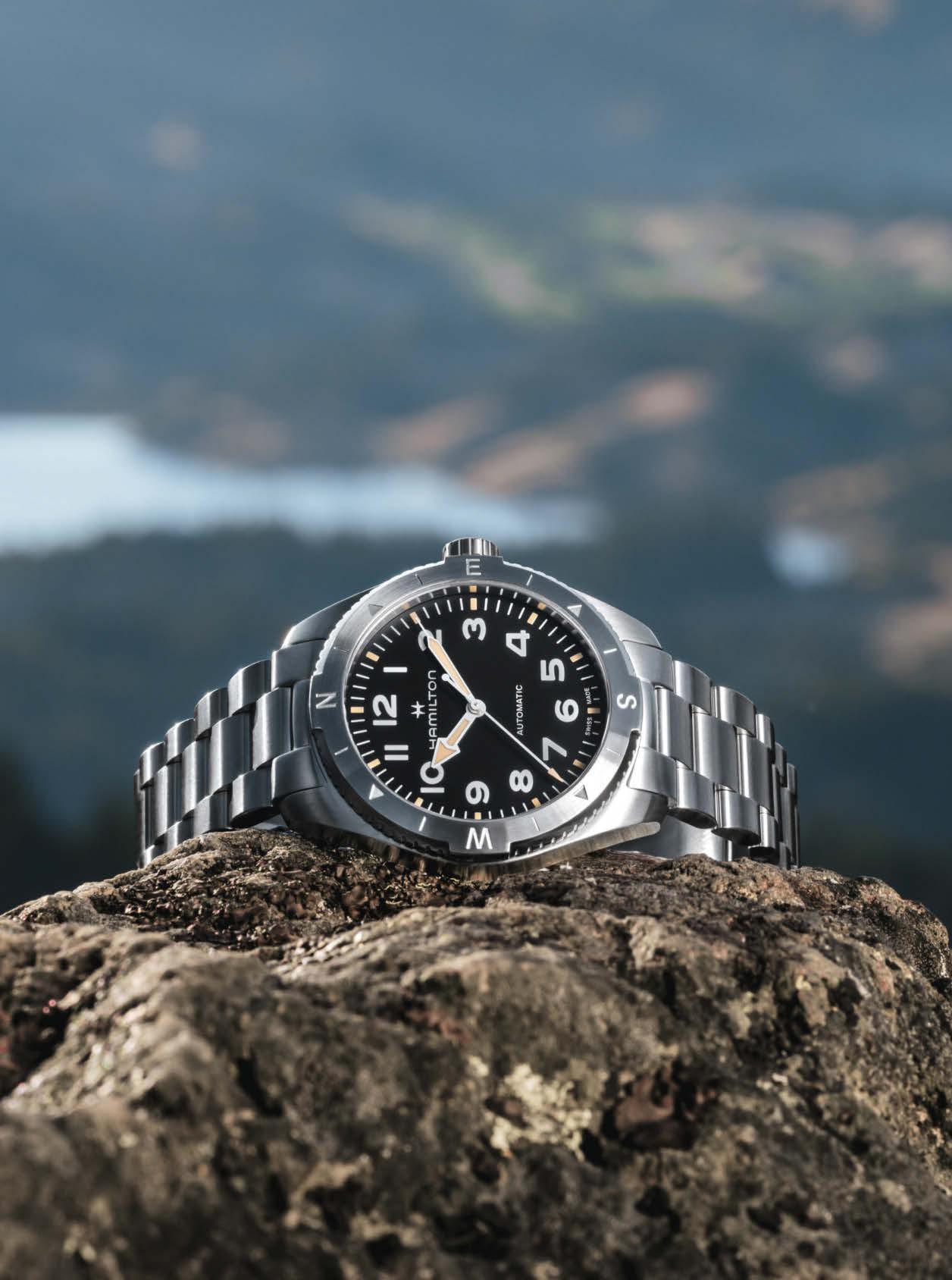
Jamaican-born, London-raised adventurer DWAYNE FIELDS escaped the estates of Hackney to embark on expeditions to both poles. His message: if I can do it, anyone can
WORDS CHARLIE ALLENBYClick. Dwayne Fields was staring down the barrel of a gun, but he hadn’t heard a bang or felt a bullet rip through his body. After confronting a gang from a rival north-east London estate who’d stolen his moped, the situation had become heated, putting Fields, then 21, in the firing line. Click. “I’ve never heard of bullets misfiring more than once,” says Fields, now 40. “On the 10-minute walk home, I stopped three or four times and lifted my shirt. I could feel tension in certain parts of my chest, but it was all in my head.”
The incident was a culmination of an inner-city childhood that had become a feat of endurance. Since moving from Jamaica at the age of six to live with his mum, Fields had suppressed his love of nature and exploration to blend in with his peers. He was regularly robbed by students from other schools – “I learnt very early on to put my money in my sock” – and was stabbed in his late teens merely for running from confrontation. But the attempted shooting marked a turning point: “That’s when I revisited the person I was as a kid.”
In 2010, Fields became the first Black Briton to trek to the North Pole, which led to further adventures. Now a fullyfledged explorer, he has traversed central America’s jungles, circumnavigated Jamaica and, most recently, recreated the expeditions of Shackleton and Scott in Antarctica. But rather than planting flags, his goal is to sow seeds, inspiring young people of all backgrounds to follow a different life path via nature.
the red bulletin: When did you first fall in love with nature?
dwayne fields: I grew up in rural Jamaica with my great-grandma, and
I loved climbing trees. I’d always have a different animal with me: a bird in my pocket and a lizard in my hand.
Relocating to London must have been a shock to the system…
I felt isolated. My accent was different [from everyone else’s]. Other kids didn’t like messing with bugs. And my mum, who I’d met maybe two or three times up until this point, didn’t like nature. My brain was saying, “Don’t you want to go and explore?” but I just sat on benches in the estate, hour after hour.
What broke the habit?
[After being shot at] I got texts planting the seed of revenge. If I did that, I’d be that same kid going left when I wanted to go right. I thought, “You like the outdoors, but you need to do it on a mature level – something that’ll inspire others.” A few months later, a friend of mine, Etem Celebi, was shot and killed metres from where the guy pulled the gun on me. I thought, “You need to do something.”
I saw Ben Fogle and James Cracknell on TV [looking for a third team member for] their South Pole adventure. I applied six weeks too late – selections had already started – but then I got a message asking if I’d consider going to the North Pole.
Did you ever doubt yourself?
Every single day. I was laughed at while hauling tyres in Hackney Marshes to train for pulling a sled, so I decided to do it in Clissold Park [in Stoke Newington] late at night because there was less chance of being ridiculed. In the end I used some of my student loan, plus another loan and my wages from a part-time job, to raise the £23,000 needed. When fundraising, people would say, “Why don’t you just walk around Hackney?” or, “Black people don’t do that,” so I stopped asking. It got
hard explaining that sometimes you need to be an example. If you want to tell the kind of kids I’d been hanging around with that “there’s a better way”, [you need] something to peg it to.
How was that first expedition?
There were days when it was mentally tough and felt physically impossible. But other days I was so much in my element and it felt like I was back on my path.
And in January this year you went to Antarctica to relive the heroic age of polar exploration, using period kit… [That was] one of the most epic expeditions I’ve been on. I was terrified to give up [mod cons] to go into the unknown, but the kit was actually really good. There were days when it was minus 40 and you’d wish for a down jacket, but we put on our boiled wool outers and made it through. My biggest complaint was the reindeer sleeping bags – we’d wake up covered in hairs and be plucking them out from every crevice.
What’s next?
My goal is to inspire people: “That guy looks and sounds like me. If he could do it, I can do it.” I also want to grow the WeTwo Foundation [a charity co-founded by Fields that takes underprivileged young people on expeditions around the world]. Many of these young people have never left the city. The world would be a much more sustainable place if we could get more people to fall in love with the natural world. The marvel’s out there. Watch Endurance: Race to the Pole on Channel 5 and My5; Dwayne Fields will be speaking at the Kendal Mountain Festival on November 18; dwayne-fields.com
Frozen in time: Dwayne Fields channels Shackleton – gear and all – on his Antarctica trip
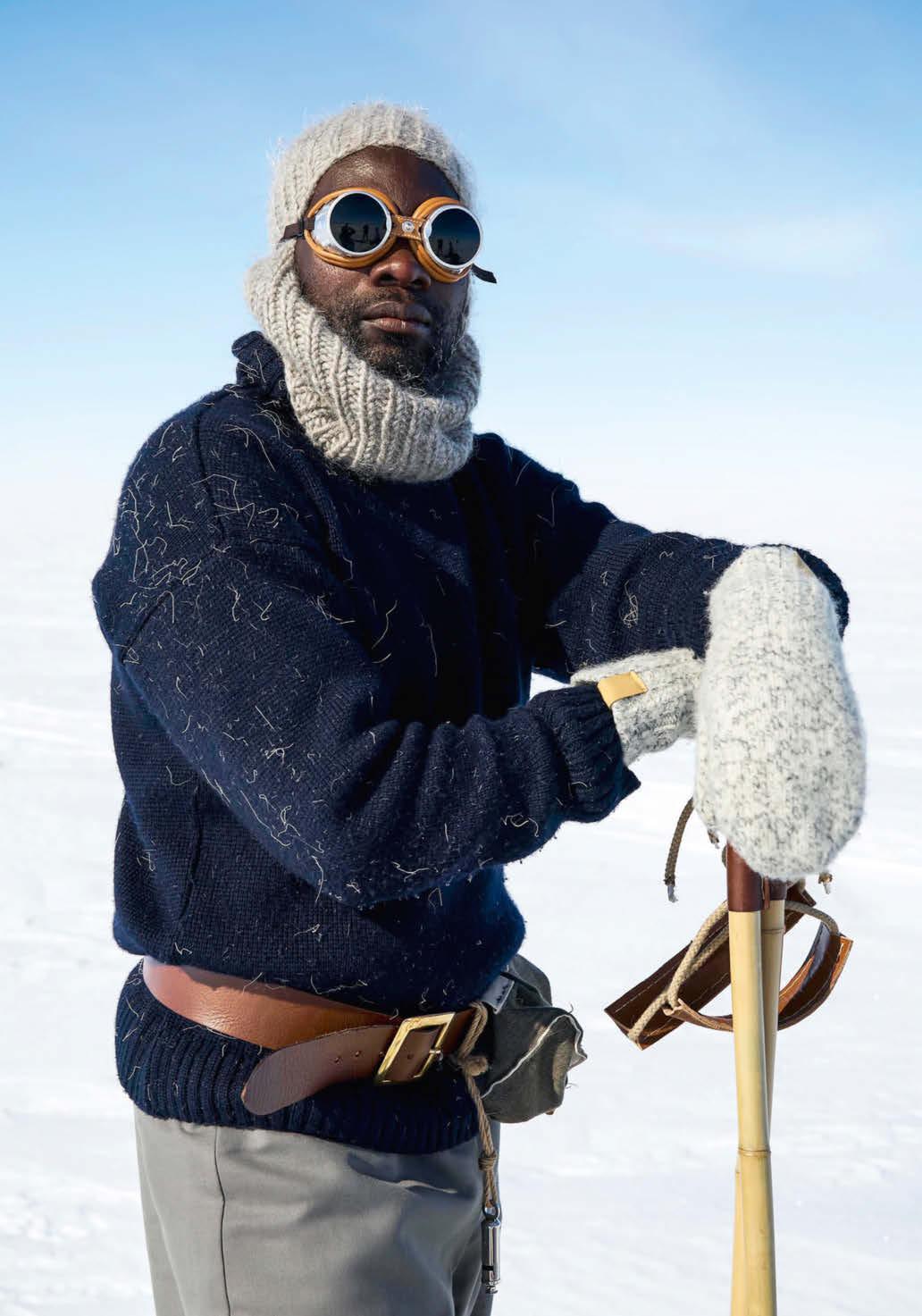
“People would say to me, ‘Why don’t you just walk around Hackney?’”
British ultrarunner CARLA MOLINARO only started taking her sport seriously two years ago. Now she’s a world-class talent and an inspiration to other athletes
WORDS RICHARD EDWARDS PHOTOGRAPHY FAHWAAZ CORNELIUSCarla Molinaro is redefining endurance running. But that doesn’t mean she can’t still enjoy a slice of cake. Having grown up in pubs in and around the area of the M25 – a peripatetic early life in which she attended 13 different schools – it’s logical that she arranges to meet The Red Bulletin at her parents’ establishment in Chalfont St Giles, Buckinghamshire. It’s Molinaro’s first time back in the UK since moving to Cape Town in December 2020. There’s no carrot cake, so she must make do with rocky road – apt given the terrain she now trains on in South Africa.
In November, the 39-year-old will travel to Hyderabad in southern India to compete in the IAU 50km World Championships. She’ll line up as one of the most talked-about ultrarunners on the planet, having already come third this year in both the Comrades Marathon – a 90km race in KwaZulu-Natal – and the 56km Two Oceans Marathon in Cape Town. Not bad for someone who claims to have been no more than a decent club runner for the majority of her life.
Molinaro is also a world record holder, having run the length of Great Britain – the small matter of 1,327km –in 12 days, 30 minutes and 14 seconds in 2020, and the proud owner of a Team GB vest, having represented her country at the 100km World Championships in 2018. Not only an athlete but a coach and adventurer, she’s a role model for runners across the globe.
We caught up with Molinaro to find out what drives her, and how she feels her own experiences on the road can help inspire others…
the red bulletin: Ultrarunning isn’t everyone’s idea of fun – how do you keep going, not just in competition but also in training? carla molinaro: I think everyone has mental barriers in their head. It’s about knowing that suffering is OK sometimes. There are times in a race when you have to just suck it up and have a word with yourself. A lot of the events I do are as much a mental challenge as a physical one. It’s about accepting that it’ll be painful and you just have to learn to deal with it. Ultrarunning always throws things at you – you never know what you’re going to get. It’s about solving that puzzle. That’s what I love about it. No race or run is the same. I love pushing myself and seeing what I’m capable of.
Is it harder being in trouble in a race when the event is broadcast to millions of people?
I can’t tell you how obsessed South Africans are with Comrades [Marathon]. You have over a million people watching along the route. There’s a hill called Cowies Hill, and you run up there with loads of TV cameras in your face. Everyone is watching you, and this year I felt like someone had harpooned me. I knew I looked like I was in a shit state, so I just kept telling myself to get a grip.
Did you always plan to be a pro athlete? For ages I didn’t take it seriously. I was always just a fairly good club runner; I didn’t think about the nutrition, the plan, the strategy. Then two years ago I began working with a new coach and something changed. I thought, “I’m going to throw everything at this.” I don’t have any special ability. I was told I was too old to wear a [Team] GB vest, but I got one at 34. I got my first professional contract in 2018, and having given up my job in the
Army [as an officer in the Royal Logistics Corps] I decided to make my work focus on what I love. I started a coaching business, then in 2020 I set up SCY for Runners [an online community offering sessions in strength conditioning and yoga]. I don’t think I’d ever stop working so I could run [full-time], mainly because I’d be bored. I need to use my brain!
Does running help you to get through the tough times?
Absolutely. I coped with the pandemic, for example, by deciding to run the length of the UK. That was my lockdown project. I was super-fit at that point and literally had nothing else to do. I had to get a repatriation flight back to the UK from Cape Town. In the end, it opened up a whole new world of opportunities for me. I was in this really weird little bubble. We would pretty much be the only people staying in hotels from Land’s End to John O’Groats. It was an amazing way to see the country, which is insanely beautiful. It also gave me an appreciation of just how hilly Cornwall is! It was all on road, but there was hardly any traffic. I’m not sure you could do that route now.
What advice would you give people taking up running for the first time?
I get a lot of people coming to me and saying, “I hate running, but can you write a running programme for me?” I just ask why they want to do something they hate when there are so many sports out there that they could try! First and foremost, people should take up something they actually want to do. If you want to run, choose a race, because having something to work towards is a really great motivational tool.
carlamolinaro.com
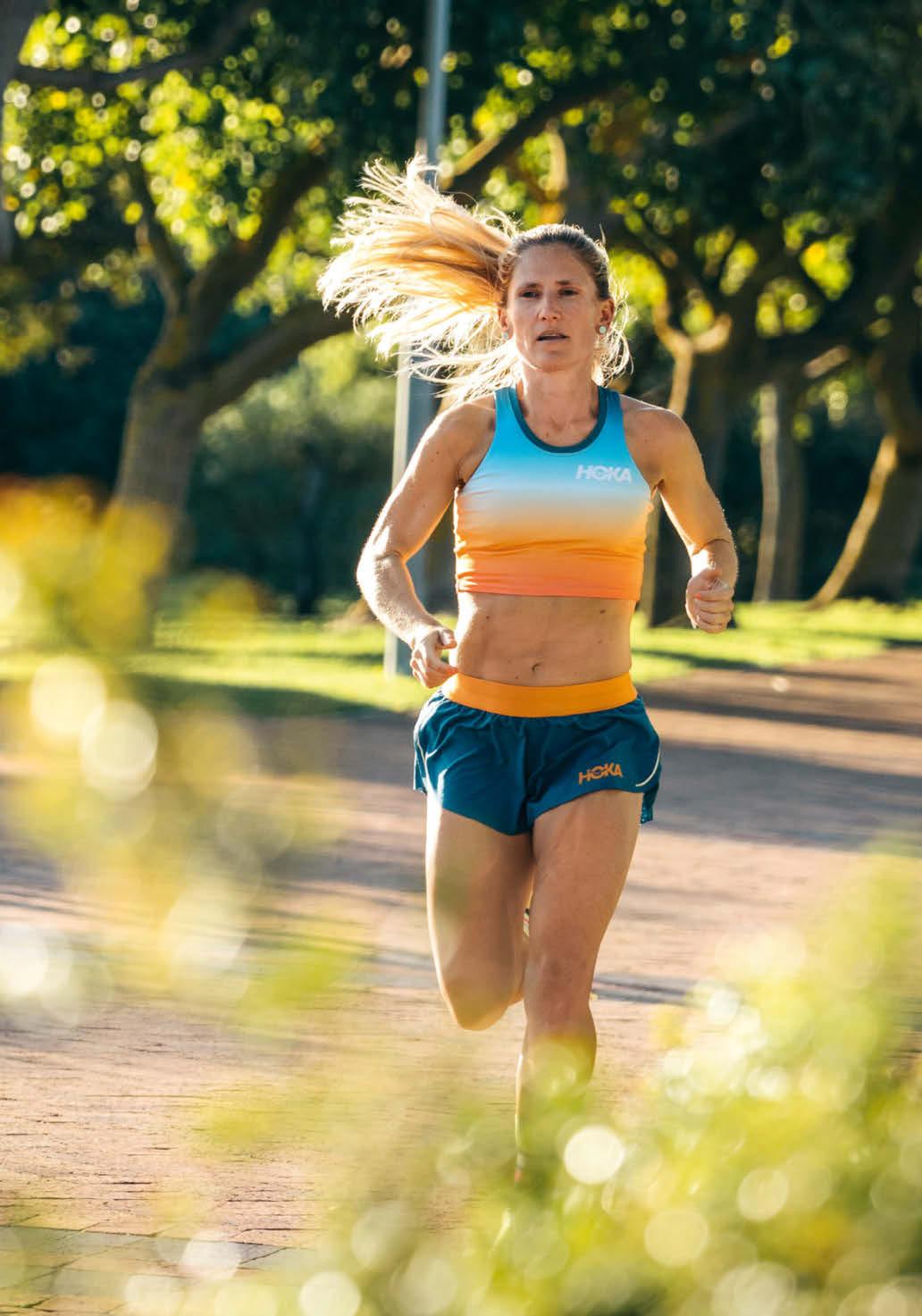
“Ultrarunning always throws things at you… It’s about solving that puzzle”
Carla Molinaro, the endurance athlete who proves you can have your cake and eat it
As Tennessee rapper turned singer Jason DeFord, aka JELLY ROLL , walked away from a life of crime and addiction, his music changed, too. And it’s earned the 38-year-old a place at the top of the US charts
WORDS LOU BOYD PHOTOGRAPHY ASHLEY OSBORNThe rise of Jason DeFord is proof that it’s never too late to change. The rapper turned singer, better known as Jelly Roll, had a troubled early life growing up in Antioch, a suburb of Nashville, Tennessee. An addict and drug dealer, DeFord spent much of his teens and early twenties in and out of detention centres and prison.
But then, in 2008, during what would be his final stint behind bars, he learnt that he was set to become a father. Prompted to change the direction of his life, DeFord poured his energy into the rap music he’d started making in his late teens, inspired by local hip-hop heroes such as Three 6 Mafia and 8Ball & MFG. A string of well-received mixtapes and studio albums followed, including Sobriety Sucks (2016) and Addiction Kills (2017).
DeFord’s big break only came in the last three years, however, thanks to the release of his 2020 single Save Me, which saw him transformed from a rapper to a singer. “That’s when the phone started ringing and labels began to get interested,” he recalls. This kickstarted a rebirth for the 38-year-old artist, who’s now totally drug-free. As the man changed, so did his music: in 2021, DeFord released a rock album, Ballads of the Broken, followed this year by a country album, Whitsitt Chapel, which earned him his first-ever number one on Billboard’s album charts.
Here, DeFord opens up about overcoming his demons, and how you’re never too old to turn your life around…
the red bulletin: Given your past, could you have ever imagined that one day you’d enjoy this success?
deford: There’s no way I could ever have dreamt this big. There have been so many times in my life that I thought
I had hit the peak of my story; where I thought it wasn’t going to work out and I’d have to live with the hopelessness associated with that feeling. Thankfully, that didn’t end up being the case.
What was rock bottom for you?
When I was incarcerated that last time. It wasn’t just being there – I’ve been incarcerated a lot – it was being there while having a kid. It was the feeling of failure. It’s one thing that I spent my whole life feeling like I failed myself, but in that moment I realised that I was failing another human.
An integral part of your success was the switch of genres from rap to country. Was there a correlation between that change and you overcoming your personal demons?
The man changed and he just dragged the music with him. The music is always meeting the man wherever he is in life. That’s what I always tell people. They’re like, “Your music changed,” and I tell them, “No, I changed.” There’s a lot of things that changed as a result of me changing. My anger’s changed, my temper’s changed, my love for people has changed, my patience has changed. My understanding, my empathy, my sympathy – these are all the big changes. The change in my music is almost like a side note.
You alluded to these changes in a recent tweet where you wrote, “If you’re judging me based on who I was five years ago, you’re really off-base.” Can you elaborate on what you meant? Five years ago, I would drink myself to sleep every night. Six years ago, I was doing cocaine every night and Xanax every day, and I’d sip codeine. I was trying to kill myself – can’t believe
I lived through it. Whereas now I feel great. I’m drinking two gallons of water a day, I’m losing weight, and I’m eating like a rabbit. I’m a very different person than I was five years ago.
Would you say that music played a part in saving your life?
Music saved my life before I’d even written one song, just from listening to it. I would be in these super-dark places, and music would be the thing that brought me out of them. Then it changed my life when I found out how therapeutic songwriting was, and it changed my life again when it became my career. I still can’t wrap my head around it. It’s insane – it broke generational curses.
What would you say to anyone who might be struggling with their own demons and are stuck in some of those same dark places you were once in? Where you are today is just a blip on the radar of what your life can be. When I spent my 16th birthday in a juvenile detention centre, I remember thinking, “I was supposed to get a car today.” I felt entitled because most kids get a car when they turn 16. That moment felt so heavy to me, so permanent; I even thought about suicide. But in the grand scheme of things, it ended up being a fly on a bull’s ass. It was nothing. People can really change, and I think you can do it at any moment; you’re never too late or too old. I really believe that who you were isn’t who you are.
Jelly Roll’s latest album, Whitsitt Chapel, is out now on BMG/Stoney Creek Records; jellyroll615.com
Jelly Roll: from inveterate addict and jailbird to drug-free, bestselling music star

“People say, ‘Your music changed,’ and I tell them, ‘No, I changed’”
Not all pop stars‘ stories are of overnight success. For PRIYA RAGU, the journey to musical stardom has been a 30-yearlong road of self-discovery
Words LOU BOYD Photography ELLIOTT WILCOX


In the music video for her single Adalam Va!, released in October last year, Priya Ragupathylingam – better known by her stage name Priya Ragu – dances around a grand manor house with a group of actors. They seamlessly transition between choreographed dance and martial arts to narrate a tale of revenge. It’s a stylised film reminiscent of both modern Tarantino and classic Tamil cinema (nicknamed Kollywood). Ragu effortlessly dances between these two cultural references in an oversized shirt and sunglasses. The protagonist of her own story.
Beyond this track, the video is apt in that it depicts the influences that have shaped the 37-year-old singer and songwriter, along with the tensions those influences bring. As a daughter of Tamil parents, Ragu, like many young South Asian women, felt the pressure to conform to the expectations of her family: securing a good job, leading a stable life, and finding a suitable marriage match. An international music career as an R&B and pop artist was never meant to be on the cards.
On this hot September morning in London, however, as Ragu prepares for her cover shoot for The Red Bulletin, it’s clear to everyone in attendance that a pop star is exactly what Ragu is meant to be. Chatting with her stylist and make-up team, she’s warm and enigmatic, with an ability to be both the softest spoken and the most engaging person in the room. “Who’s your favourite artist?” she asks the team as her make-up artist, Daniela Alves, finishes her eyes. “Music, or any kind of art?” Alves replies. “Anything. I just like to find out what people are
into,” Ragu says, smiling. Then the shoot starts and she confidently strides out of make-up and into the street, posing against the bright orange backdrop, a natural performer.
Ragu’s songs are a joyous blend of the music that has moulded her, fusing R&B, garage, disco, pop and hip hop with the warm rhythms of the tabla – a traditional classical Indian drum set – South Asian instrumentation, and melodies and lyrics from Tamil songs. Written in collaboration with her brother, producer and musical partner Japhna Gold, Ragu’s music is exciting and affecting in the way that only truly new and singular art can be, and a unique sonic expression that only these siblings could have created. For this reason, they’ve called the genre ‘Raguwavy’, drawing inspiration from their family name.
This distinctive sound garnered immediate attention for Ragu. With the release of the song Good Love 2.0 in 2020, she swiftly transformed from an unknown independent artist into an up-and-coming star. Numerous record labels reached out to her, and the track received substantial support from Radio 1. She went on to be named on the BBC’s
Sound of 2022 longlist, perform on Later… with Jools Holland, feature on Jungle’s 2021 album Loving in Stereo, and earn acclaim and nominations from Amazon Music, Apple Music, Deezer, MTV, Spotify and Vevo, among others. “It felt like a miracle,” says Ragu. “[Good Love 2.0] reached all the right people in the world.”
Her long-awaited album, released in October, is both an infectiously positive party record and a statement from Ragu about her journey to self-discovery and purpose. Titled Santhosam, the Tamil word for happiness, the record narrates Ragu’s own story over the past 20 years – her quest to discover her true identity as she struggled to reconcile being a respectful South Asian daughter with the knowledge that she harboured an
Getting noticed: Ragu’s 2020 breakthrough hit Good Love 2.0 put her on the radar of record labels and radio stations and attracted crtitical acclaim

ambitious musical powerhouse within. This tension is evident from the start. The album opens with Ammama’s Note, an 18-second message from Ragu’s grandmother, recorded and sent after a family wedding in Toronto in 2020.

“Hey, did you forget about me? Didn’t you call?” Ragu’s grandmother asks her in Tamil. “Do you remember what I said about the marriage proposal?” At this point, another person grabs the phone and interrupts. “That was my cousin,” Ragu says, laughing. “She knows I’m allergic to those words: marriage proposal. I thought the voice message would be such a funny way to start the album. It’s very authentic. It’s a topic that haunted me for years, so it was only right to address it at the top of this record, which is all about me finding my happiness and breaking free from all those societal expectations.” The phone line goes dead, and the album bursts into its first track...
To understand all the parts that make up Ragu and her music, you must go back to the start. The daughter of a pharmacist and an accountant, Ragu grew up in the small and picturesque city of St Gallen, Switzerland, after her family moved there from Sri Lanka in the 1980s to escape the civil war. The contrast between their home life and the Swiss town was extreme, and Ragu found herself in the midst of a culture clash. “It was very difficult to balance the two cultures as a child,” says Ragu. “I often felt like I had to hide my heritage.”
Growing up in a traditional Tamil household, Ragu’s initial musical influences were limited. She and her brother were mostly barred from listening to Western music or watching MTV in the house. Instead, they listened to South Asian musicians and composers such as Ilaiyaraaja and AR Rahman. “Our parents wanted us to know where we come from,” says Ragu. “We listened to Tamil music, and we spoke the language.”
Their music was restricted in genre but was an integral element of family life. Ragu’s father would hold jam sessions, inviting local musicians and friends to the house every weekend to play classical Tamil music. As a child, Ragu would sit and watch: “Every week, all these personalities would come over. I was too small to participate, but I was observing everything.” Her brother began playing the keyboard during these sessions, accompanying their father as he
played the tabla. At the age of 10, Ragu joined in, singing with the group. “We were the first Tamil band in town,” she says. “Nothing serious... we’d just play at local cultural events and weddings.”
To the outside observer, solely Tamil music filled Ragu’s childhood home; however, there was another, clandestine layer of musical education happening within its walls. Away from their parents’
vigilant gaze, Ragu and her brother began to secretly swap and share music, presenting each other with acts like The Roots, Mos Def and Fugees, and finding their own references and style. “Black music was a big part of us growing up,” she says. The moment everything changed, however, was when Ragu discovered Lauryn Hill. “I saw [1993 movie] Sister Act 2, and I resonated with the story where Lauryn Hill wasn’t allowed to sing and attend the choir groups. I was like, ‘Oh, my God, this is like my story. Her voice resonated with me so deeply. Before that moment, I didn’t know that music could be so powerful, but she moved something within me.”
A passion for singing had been ignited within Ragu. When her parents refused
“ALL THROUGH MY TWENTIES, MUSIC WAS THERE. BUT I IGNORED IT”

“THEN I HIT 30 AND I INSTANTLY REALISED, ‘OH GOD, I HAVE THIS TALENT AND I’M JUST WASTING IT’”Priya Ragu
to pay for vocal lessons, disapproving of the soul and R&B music their daughter was emulating, she spent years teaching herself the songs of Lauryn Hill, Alicia Keys and others in her bedroom. Then one day, aged 16, she decided to finally sing for someone else and turned to her brother. “That was the first moment that I felt confident about my skill, and I felt like I had to show it to somebody,” she remembers. “At that time, Japhna had a rap crew, and I sang in front of them. They all liked it and said, ‘You should come perform with us this weekend.’ I couldn’t believe it. I went home and wrote it in my diary.”
The event would prove to be significant, but not in the way Ragu had hoped. Unknowingly, she left her diary open in her bedroom, and her father found the entry she’d written about the show. Not viewing the style of music or performing on stage to be suitable for his young daughter, he forbade her from attending. “On the
day of the event, I got ready, put on an outfit, learned the song, and I was so nervous,” Ragu recalls. “I was ready to go out, and he was like, ‘Where are you going?’ I lied and said I was going to a friend’s birthday party, but he told me, ‘I saw your diary entry – it’s not happening.’ I went back to my room and I hated the world. It was awful. I can laugh about it today, but that day… it was devastating. I told myself, ‘From now on, I’m not going to share anything with my parents about my music until I reach a certain level.’”
That night marked the end of her musical aspirations for many years. Ragu
graduated from school, got a safe and steady career as an accountant for an airline and moved to Zurich, working up to the position of buyer of airplane parts for Swiss Airlines. Life was on track, and she was living the stable life that her parents had always dreamt of for their daughter, but her own dream of being a musician never went away.
“All the way through my twenties, music was there – it was knocking on my door all the time,” she says. “But I ignored it. I thought, ‘No. I’m keeping my safe job, my safe income. I don’t want to be a struggling artist.’ I didn’t see any future for myself as a singer in Switzerland, and for years I suppressed that voice. I just thought that I could ignore it, that I could just keep singing and do music as a hobby. During that time, I didn’t even write songs.”
But then a milestone birthday came around and everything changed: “I hit 30 and instantly I realised, ‘Oh God, I have this talent and I’m just wasting it.’ Suddenly it was so clear to me that I had to try, that I couldn’t not try to do music. I realised that I couldn’t go another 30 years and get to 60 knowing that I never gave it a shot.”
Embarking on a music career in her thirties, Ragu started writing songs and turned to multiple collaborators and producers, even putting her stable job on hold to move to New York for a few months when an opportunity to record with the US rapper Oddisee came her way. But none of these partnerships gave her the inspiration and sound she was looking for. Lonely and despondent in New York, she turned once again to her very first music collaborator: elder brother Gold. The pair began Skyping most nights for company, Ragu from her rented room in the US and Gold back home in Switzerland, and something magical began to happen.
The siblings started playing around with beats and song hooks and found themselves in the kind of creative partnership they’d both always dreamt of. “We’d always had a good relationship, but with music it kind of brought us back to our roots and it made us connect more with who we really are,” says Ragu. “It’s a spiritual thing as well. He experienced the same life as me, he grew up in the same household, he was in the same city, same language, same cultural clash. It was so much easier to write these songs

“I HAD TO BREAK FREE FROM EXPECTATIONS TO BECOME WHO I AM”

“IT WAS DIFFICULT BALANCING THE TWO CULTURES AS A CHILD. I FELT LIKE I HAD TO HIDE MY HERITAGE”
Reaching goals: Ragu says she has only two ambitions yet to fulfill – recording a Tiny Desk Concert for NPR and meeting Indian music giant AR Rahman
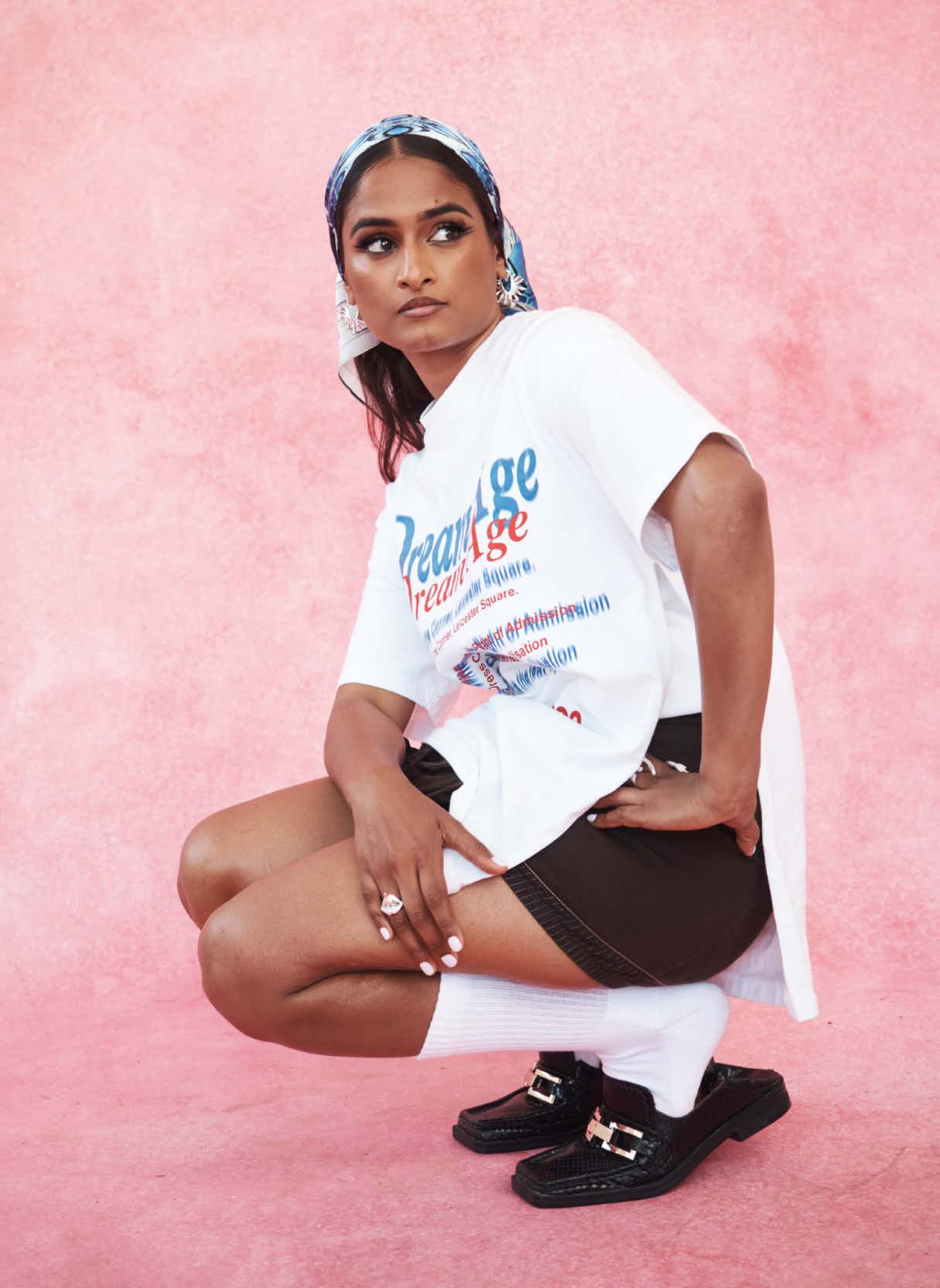
together, because we’ve been through the same thing; we had a shorthand and a connection that can’t be replicated.” Ragu returned to Switzerland, and Gold became her official producer.
Ragu remembers when they were working in the studio together one day and Gold suggested turning the beat of the song on its head and adding some rhythms and instrumentation from their childhood jam sessions into the mix. “I was hesitant, and at the beginning there was a clash between us because he had his vision and I had mine,” she says. “I wanted to do straight jazz, soul and R&B music.” Gold convinced Ragu to give his idea a shot. “I just surrendered myself and said, ‘OK, let’s try it out.’ He came up with a beat and then some Tamil words. It felt so right, it came so effortlessly. I instantly knew that this was it, this was what we sounded like. From that moment, we just went for it.”
Raguwavy was born, and from there the songs came thick and fast. Ragu recorded Good Love 1.0 and Good Love 2.0, the latter written about how her parents found a love match instead of an arranged marriage; Chicken Lemon Rice, a celebration of unity and diversity; and damnshestamil, a 10-track mixtape of all the siblings’ joint life experiences together so far. The songs started gaining attention, and press outlets began to request interviews with Ragu. It was time. She quit her job at Swiss Airlines and told her parents that she was pursuing music, showing them the tracks that she and Gold had worked on. “It wasn’t an easy thing to share, and they didn’t completely accept it,” says Ragu. “But they did like some of the songs.”
Now signed to major record label Warner Music, Ragu’s first full album, Santhosam, is a dynamic collection of music that takes her Raguwavy sound and launches it to new heights, with tracks encompassing everything from the feeling of wanting to take a holiday and needing to dance, to explicitly political songs about Black
Lives Matter and polemical tracks about individual liberation. The opening song on the album, School Me Like That, is a declaration of her experience, and a direct message to her parents. “Papa said don’t do me like that/Keep your education in check/Keep your reputation in check,” she sings. “Mama said don’t do me like that/Girls can’t be so choosy like that.”
As the chorus of the track comes in, Ragu’s message to her family continues. “How can I stay awake for somebody else’s dreaming?” she says, “There’s so much life in me that I should believe in/ I took a leap of faith just to face the feeling/Just look at me now, I’m good/ Wake up to things I really want to do/ We are done being chained, I was born to break them for good.”
It’s a powerful opening song that talks directly to the people she worries most about disappointing. “I had to break free from all these expectations to be who I am today,” Ragu explains, “That’s why I felt like [School Me Like That] was a good song to begin the record with. I’m proud that I took this step, and in that song I’m singing, “Look at me now, I’m good. Papa, I’m good. Father, I’m good. You don’t have to worry about me any more.”
Now the album is out and a European and US headline tour is planned for next year, is there anything else that Ragu still aspires to accomplish? “I actually made a vision board two years ago and wrote all the things I wanted to achieve on it,” she says. “Over the last two years, all those things have slowly started to happen. I wrote ‘Make a Colors [a London-based YouTube channel] video’ on it and it happened, I wrote ‘Be featured in Vogue,’ then British Vogue and Vogue India featured me. I wrote that I wanted to meet [Sri Lankan rapper] MIA and that happened! I wrote that I wanted to perform at the Montreux Jazz Festival, and that was one of my first gigs.” She thinks. “Now there are only two things on there that I haven’t done: record a Tiny Desk Concert and meet [Indian
composer] A R Rahman. Isn’t that crazy? How lucky am I?”
In a larger sense, however, Ragu’s decades-long search for achievement is over. “I’ve found my own happiness,” she says. “I wake up in the morning and do the things that I really want to do. I’m so glad that I took that leap of faith and believed in myself. If I fail tomorrow, I’ll know that I’ve created this great body of work. I’m happy with that. I feel like I’ve fulfilled my purpose in life already.”
And what of the rest of the Ragupathylingam family today?
How do Ragu’s parents feel about her music career now that she’s shared it with them and she is out here, with her brother at her side, doing so successfully? “I feel like since I started doing music, we’ve started connecting on a different level,” she says. “Music has opened mine and my brother’s relationship with our parents… there are no boundaries any more. It’s been a very healing process for all of us.”
Her parents have even joined Ragu and Gold in the creation of the album, with their father credited as a lyricist on some tracks, and the album title was inspired by a Tamil chant by their mother that featured on the final track of damnshestamil. “My dad has such a good ear! I would never have thought that he could understand my kind of music, but he really does. The kind of feedback that he gives me sometimes is very surprising. I’m like, ‘Whoa, yes! That’s really coming from you?’”
Recently, Ragu discovered that she and her dad are more alike than she could have ever imagined. “Sometimes he talks to himself,” she says. “And I caught him talking to himself in the kitchen, saying, ‘In my next life, I’ll be a singer.’ I didn’t know that was a path he’d ever wanted. He’d never spoken that out into existence before. This wish had always been deep within him.”
Ragu pauses and rethinks. “Actually, I think he did sing in Sri Lanka when he was young… I think he sang on stage at jam sessions,’ she continues. “I think he was known for it, but because of the struggle there he had to hide it, he was not able to freely sing,” She looks down in thought. “He was hiding his voice back then, and for a while there I was hiding my voice, too. Enough with that. No more hiding.”
priya-ragu.com
“MUSIC HAS OPENED MINE AND MY BROTHER’S RELATIONSHIP WITH OUR PARENTS… IT’S BEEN A VERY HEALING PROCESS”
Behold a tale of mighty champions locked in an epic struggle across dimensions. Of ancient rivalries between two heroes with a shared past but different destinies. This is no myth. This is the very real League of Legends World Championship
 Words DANIEL BROWN
Words DANIEL BROWN
 T1 vs DRX at the 2022 Worlds Final at Chase Center, San Francisco. Tickets sold out in less than five minutes COLIN YOUNG-WOLFF
T1 vs DRX at the 2022 Worlds Final at Chase Center, San Francisco. Tickets sold out in less than five minutes COLIN YOUNG-WOLFF
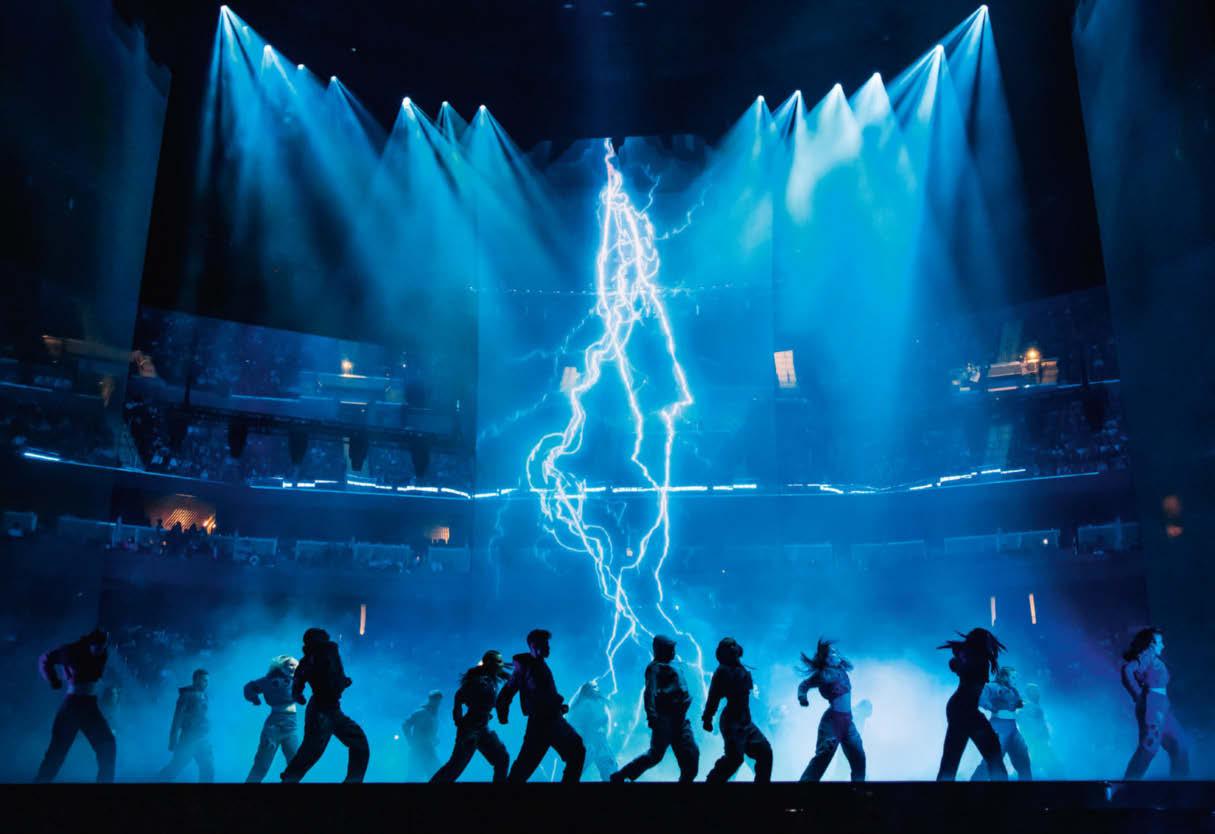
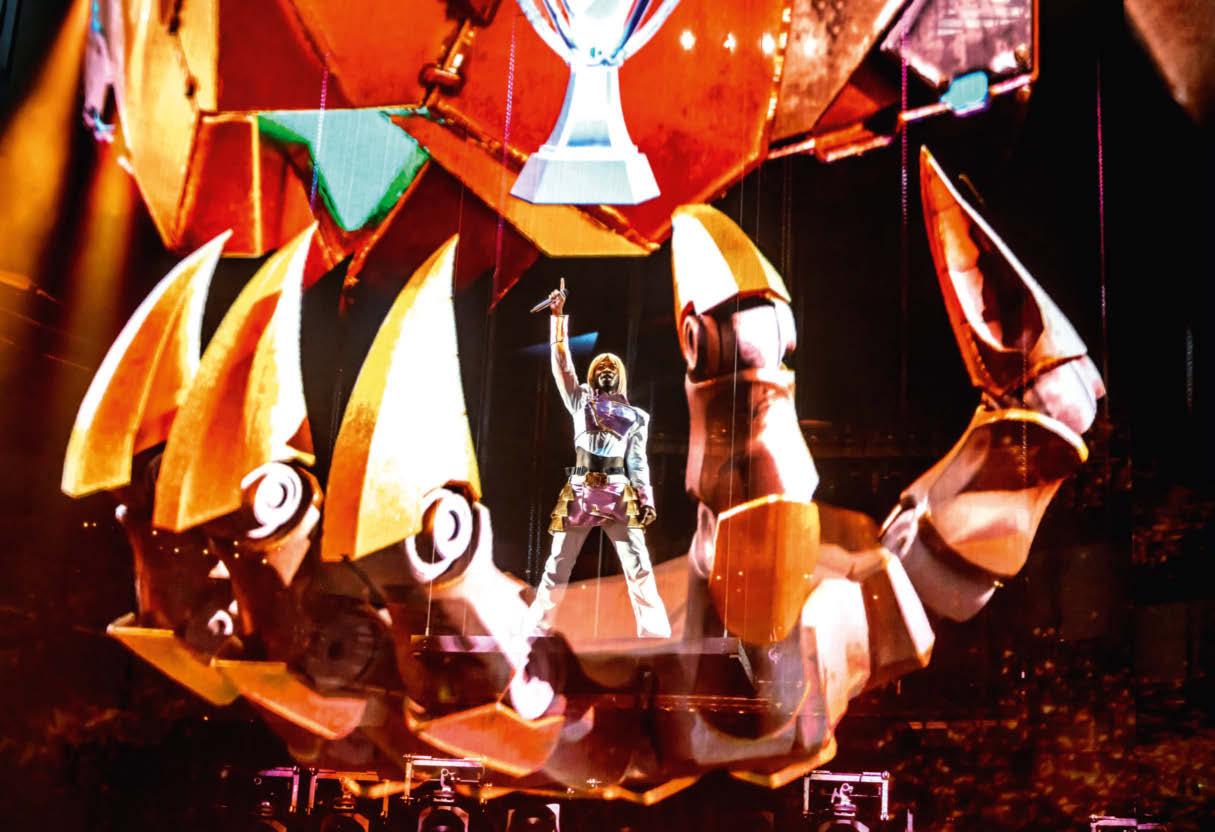 Fantastic beats: the 2022 Worlds Opening Ceremony.
Above: Lil Nas X performs inside a giant hologram
Fantastic beats: the 2022 Worlds Opening Ceremony.
Above: Lil Nas X performs inside a giant hologram
Having just belted out the last note of his League of Legends-inspired anthem Star Walkin’, Lil Nas X emerges backstage, resplendent in a strawberry blonde wig and shimmering metallic breastplate.
Even in an arena where many of the 14,548 fans arrived for the 2022 League of Legends World Championship Final in costume – a staple of this rollicking event – the rapper remains easy to spot as he strides purposefully through the corridors of San Francisco’s Chase Center.
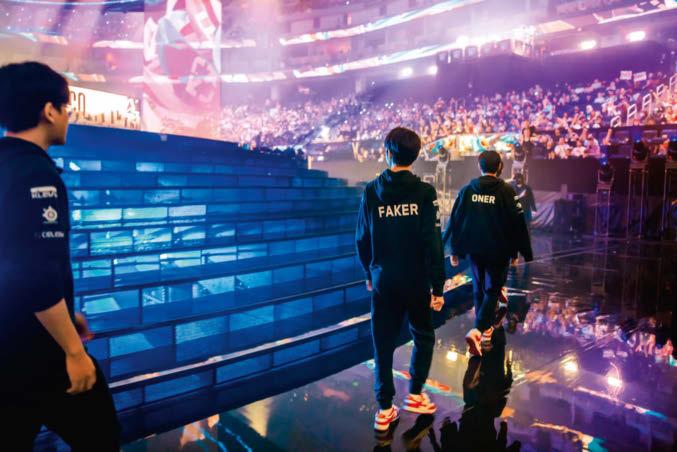
“Killed it!’’ one female passer-by tells him.
“Love your dress,’’ Nas replies, without stopping.
He moves briskly through the halls until he reaches a locker room, which on most autumn nights serves as a haven for NBA stars. Indeed, this scene, on November 5 last year, might have looked familiar to LeBron James or Stephen Curry, because Nas is still catching his breath in front of a row of lockers when someone puts a camera in his face and asks, “How does it feel to know that millions of people just watched you do that?”
“How does it feel?” Nas responds, smiling. “I think it’s sick. That’s a crazy number of people.” An astute post-game analysis, because crazy is the word for it, alright.
The League of Legends World Championship, better known as Worlds, is the pinnacle of competition video gaming, an annual culmination of a globe-spanning season of regional leagues that
selects 24 teams to compete in a five-week-long tournament to win the ultimate accolade in the biggest esports game on the planet: League of Legends, or LoL to its fans.
Here’s how a typical match unfolds. Two teams of five players fight across a magical battleground known as Summoner’s Rift and viewed as a vast, scrolling map. Each team starts at its base, or Nexus, at opposite ends of the playing field, with three pathways through the middle – a top, middle and bottom lane. Everything else is jungle. The team that destroys its rival’s Nexus wins the match. That’s the simple bit. Add more than 160 selectable characters – called champions – each with their own skills, strengths and weaknesses, and there are infinite permutations of how best to play them together. Imagine chess, but with all the pieces moving around in real time, fighting, building experience points (XP), collecting gold, and respawning when they die. Then throw in monsters, minions, turrets and other plot twists.
If chess is a game that’s easy to learn but takes a lifetime to master, LoL could take a lifetime to simply learn. It’s this Sun Tzu level of strategy that the fans love, endlessly debating tactics on community subreddits with millions of members.
The 2022 Worlds Opening Ceremony alone spoke to – nay, screamed to – the absurd rise of this now 14-year-old video game. Released by US developer Riot Games in 2009, LoL somehow rose from a staple of childhood basements to this: a two-time Grammy winner singing the tournament’s anthem (Lil Nas X was named ‘President of League of Legends’ two months earlier) inside a $1.6billion stadium amid a holographic representation of Runeterra – the realm the game is set in – while engulfed by giant virtual versions of LoL characters such as K’Sante and Azir (whose powers, alas, include neither singing nor dancing).
That three-minute, 57-second performance required a 2,000-strong production crew, while 80 semi-trucks of
Major league: T1 takes to the stage during the opening ceremony. The players – Faker (pictured centre) in particular – are massive celebrities in their home country of South Koreaequipment were loaded into Chase Center, compared with around 20 for a standard concert. Somewhere, a Super Bowl halftime show was seething with jealousy.
It was, to paraphrase Lil Nas X, bonkers. And it only got more so. “The story of last year’s World Championship makes no more sense than a fairy tale that says, ‘…and the princess and the prince lived happily ever after,’’’ says Jeon Yong-jun, aka Caster Jun, a Seoul-based esports icon known for his booming voice. “A story like this is unfolding in real time in front of me?”
That dramatic storyline goes something like this: DRX, a team best described as a long shot, barely edged into the global tournament and capped an unlikely run by slaying T1, the mightiest heroes in the history of League of Legends.
In the process, the staggeringly popular Faker, a three-time Worlds champion, widely considered the greatest LoL player of all time and often described as “the Michael Jordan of esports”, lost to a long-suffering player named Deft, who’s largely defined by stunning early-round defeats on or around his birthday, which occurs during Worlds every year. (“It used to be a day of sorrow,” says Deft – a sentiment that would make the world’s worst Hallmark card). His stress and suffering led to moments where he felt like retiring.
Those two main combatants, Faker (real name: Lee Sanghyeok) and Deft (Kim Hyuk-kyu), were so central to the Worlds Final narrative a year ago that when DRX forced a decisive fifth game in a best-of-five match, it had the air of a duel at dawn.
“Faker and Deft combined have played more than 2,000 games, and it’s going to come down to one!” a shoutcaster known as Caedrel bellowed at the top of his lungs during the broadcast. “The GOAT versus the alpaca!” his co-caster Kobe added, raising the stakes by a few decibels.
The backstory stretches even further. Faker and Deft were classmates, but hardly friends, at Mapo High School in South
Korea. Even then, Faker’s talent towered above his rival’s. “I was first on the [school’s LoL] ladder. My nickname was ‘Mapo High School’s Fiery Fist’,” Faker once recounted. “I was about 100 on the ladder,” is Deft’s recollection. At an icy pre-Worlds shoot, a photographer tried to get the two high-profile combatants to stand closer together. “Best friends,’’ he said playfully. “Nice and close.” Deft and Faker simply ignored that request, as well as each other, with Faker later saying, “We’ve spent too much time being each other’s rival. So we don’t have any kind of personal relationship.” Their reunions must be a laugh.
Still, there’s too much mutual respect for actual bad blood. “Their two personalities match so well in that they’re both purehearted,’’ says industry expert Tyler Erzberger. “Both are people you want to root for. There’s no villain in this story.”
So when DRX beat T1, somehow the corniest sports movie ever written looked plausible in comparison. This blockbuster even has a ready-made tagline for the poster. It comes not from the final but from a few weeks earlier as DRX looked close to elimination in the group stages. In an interview with Korean media after DRX fell 2-0 behind in a best-of-five series, Deft gave a quote that remains a viral rallying cry throughout Korea.
“The important thing,’’ he said, “is an unbreakable heart.’’
What are esports, anyway? That hoary old question is best summed up by public perception. There are still those who wonder whether playing video games for a living is something people really do. But where once there were sniggers, incredulity, outright mocking even, it’s easiest to let the money talk.
The biggest esports stars now attract seven-figure contracts and, even in the US, esports teams are popping up in high schools and colleges. Naz Aletaha, global head of League of Legends Esports, laughs when asked about the times she stared

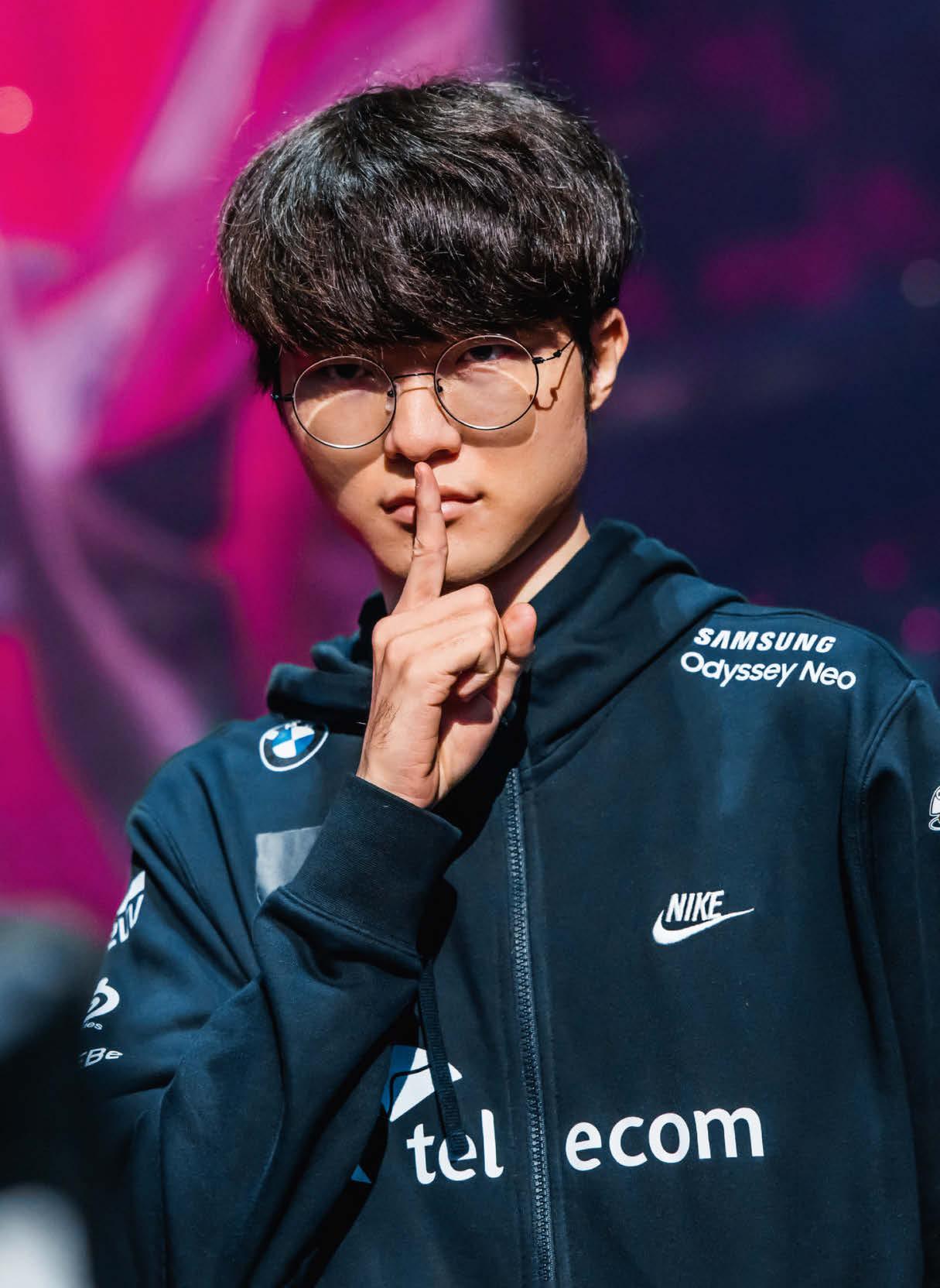
“My American fans call me ‘God’” Faker
Worlds apart: T1 (in black) had previously won three times; DRX (in white, and opposite) were rank outsiders




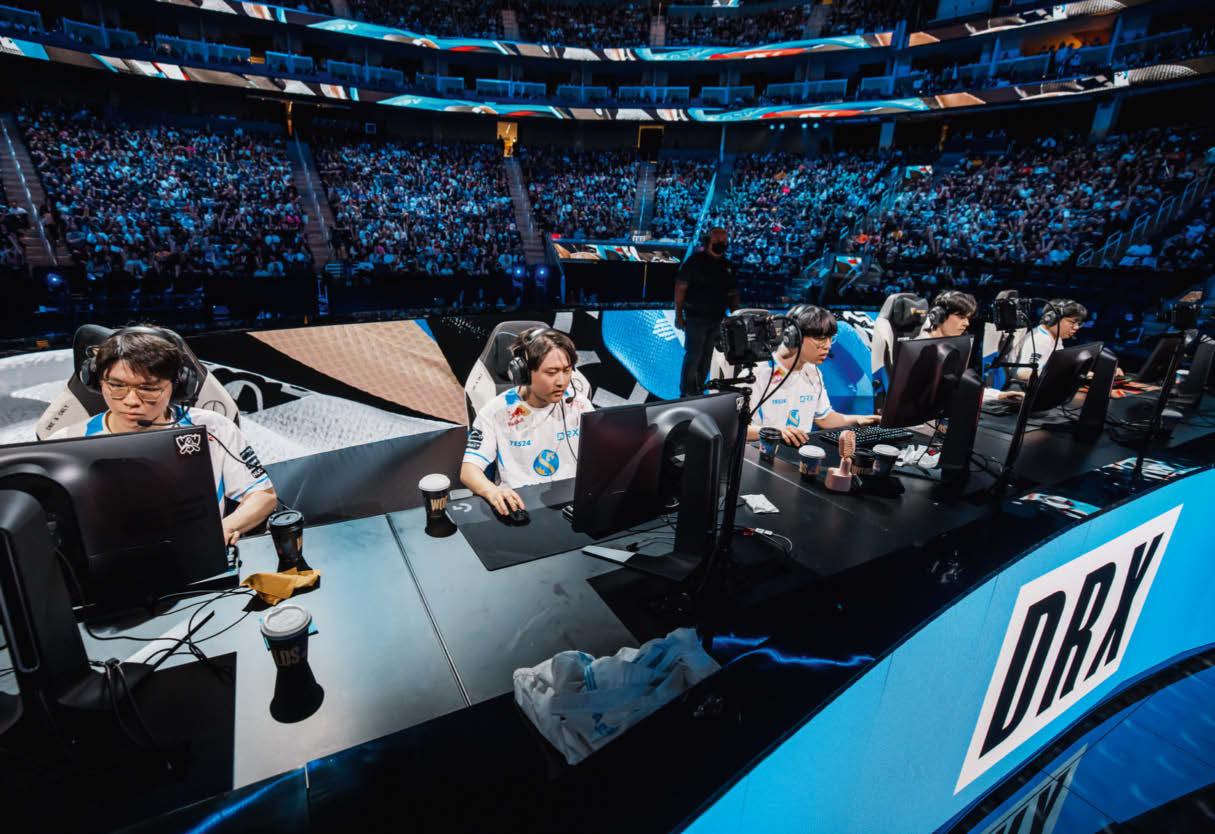
into blank faces and tried to persuade them that esports was a thing. “I spent those early years working to educate the market about how big esports was and would get,” she says. “Over the last five to 10 years, I’ve seen the temperature of those rooms go from sceptical to overwhelmingly enthusiastic. Back then, the usual question was, ‘Is it virtual football/basketball/etc?’”
And now? Worlds 2022 sold out in under five minutes – a Chase Center record. Online mentions of the Worlds Final spanned more than 240 countries, with near-equal interest across the globe. And the rise of streaming has only turbo-boosted growth. The English-speaking broadcast alone drew a record-breaking 1.6 million peak viewers, a 41-per-cent increase on Worlds 2021. In all, the finals accrued 121.7 million total hours watched.
When the 2023 Championship begins in South Korea this autumn, it’ll be riding that momentum. The competition will take place at the Gocheok Sky Dome in Seoul, the country’s largest indoor venue, with a capacity of about 17,000. Known as the birthplace of esports – where its homegrown stars can reach Taylor Swiftian levels of fame – South Korea might be the only place capable of delivering a worthy sequel.
As with many of its characters, Worlds has an unlikely origin story. The first championship took place in 2011 at a gaming conference in Sweden called DreamHack. Aletaha recalls Riot Games deciding to livestream it despite having little expertise in broadcasting or event production.
“Looking back at pictures from that Worlds Final, you can see why the community refers to the set as ‘Phreak’s basement’,” she says. This is a reference to David ‘Phreak’ Turley – a former LoL caster who conducted a broadcast for Season One of Worlds from a backroom, giving birth to a gaming community in-joke. “But despite the low production value, more than a million people tuned in. That’s when we knew – the fans, the community, they wanted esports.”
After that, the mission of Riot Games became that of granting esports the gravitas of traditional sports. In 2012,
it brought production in-house. “We dreamed of building an ecosystem where gamers could play League for a living,’’ Aletaha says. “Where pros could play to die-hard fans.”
Players suddenly had the viable career option of becoming pro gamers. No more growing up and getting a real job. One of the reasons LoL prodigies of the earlier years vanished by their early twenties is because the job didn’t pay like an actual job.
South Korea had got things rolling earlier by licensing professional esports players as far back as 2000. Competitions in StarCraft (a space-themed, real-time strategy game launched in 1998) and Warcraft III (a fantasy-based, massively multiplayer online role-playing game that came out four years later) were regularly televised by 24-hour game channels Ongamenet and MBCGame.
“Korea takes pride in being the home of esports,’’ says Aiden Lee, secretary-general of League of Legends Champions Korea (LCK). “Not only did Korea create a cultural phenomenon with StarCraft, but it has stood as the strongest country in terms of skills. In League of Legends, Korea has the best player pools and teams in the world, and they’re supported by passionate fans.”
Korea also dominates possession of the Summoner’s Cup – the trophy that goes to the Worlds champion and which embodies the competition’s cachet. Tiffany & Co was commissioned to refresh the cup’s look in 2022, and the new 69cm-tall, 25kg grail sparkles in sterling silver, fine silver, stainless steel, brass and wood. On its sides are five handles, one for each team member, etched with their role: top laner, mid laner, bot laner, jungler and support. Tiffany also left room for engravers to add the names of previous champions on the bottom. Of the 12 victors, seven are from South Korea. The next closest is China with three.

That many of the game’s most accomplished players come from South Korea only fuels interest. Lee compares the Faker vs Deft dynamic to the days when Lionel Messi played for Barcelona and Cristiano Ronaldo moved to Real Madrid, forming “the 21st-century version of El Clásico [a historic rivalry between the two Spanish football clubs] and attracting worldwide attention”.
Caster Jun got his first esports gig in 1999. At the time, it was a grassroots sport that took off with the spread of the internet and PC bangs (a Korean term for internet cafes). “I quit my job in June 2000 and started working as a game caster at a broadcast station,’’ he recalls.
He and esports took off at the same time. When Caster Jun was 30, his dream was to still be a caster at 40. When he turned 40, his goal was to be doing it at 50. Now that he’s 51, his goal no longer needs to be stated.
“The most rewarding part of being an esports person is that we grow together,’’ he ruminates. “Twenty years ago, esports finals were played with PCs on a ping pong table. Now, you get to cast in Sangam World Cup Stadium or Gocheok Sky Dome. Isn’t this a huge difference?”
Lee Sang-hyeok, a 27-year-old League of Legends mid laner who in a decade of play has maintained a statistically astonishing 66-per-cent win rate, has accrued many other names. On The Players’ Tribune, an online platform where athletes share first-person accounts, he once described it thus: “My American fans call me ‘God’. My Korean fans know me as ‘the Unkillable Demon King’. I prefer God. In game,
Above: DRX player Hong ‘Pyosik’ Chang-hyeon shows off his winner’s ring. The stone is a sapphire surrounded by white gold“No fourth seed has evermade
it intothe
finals, let alone won Worlds”
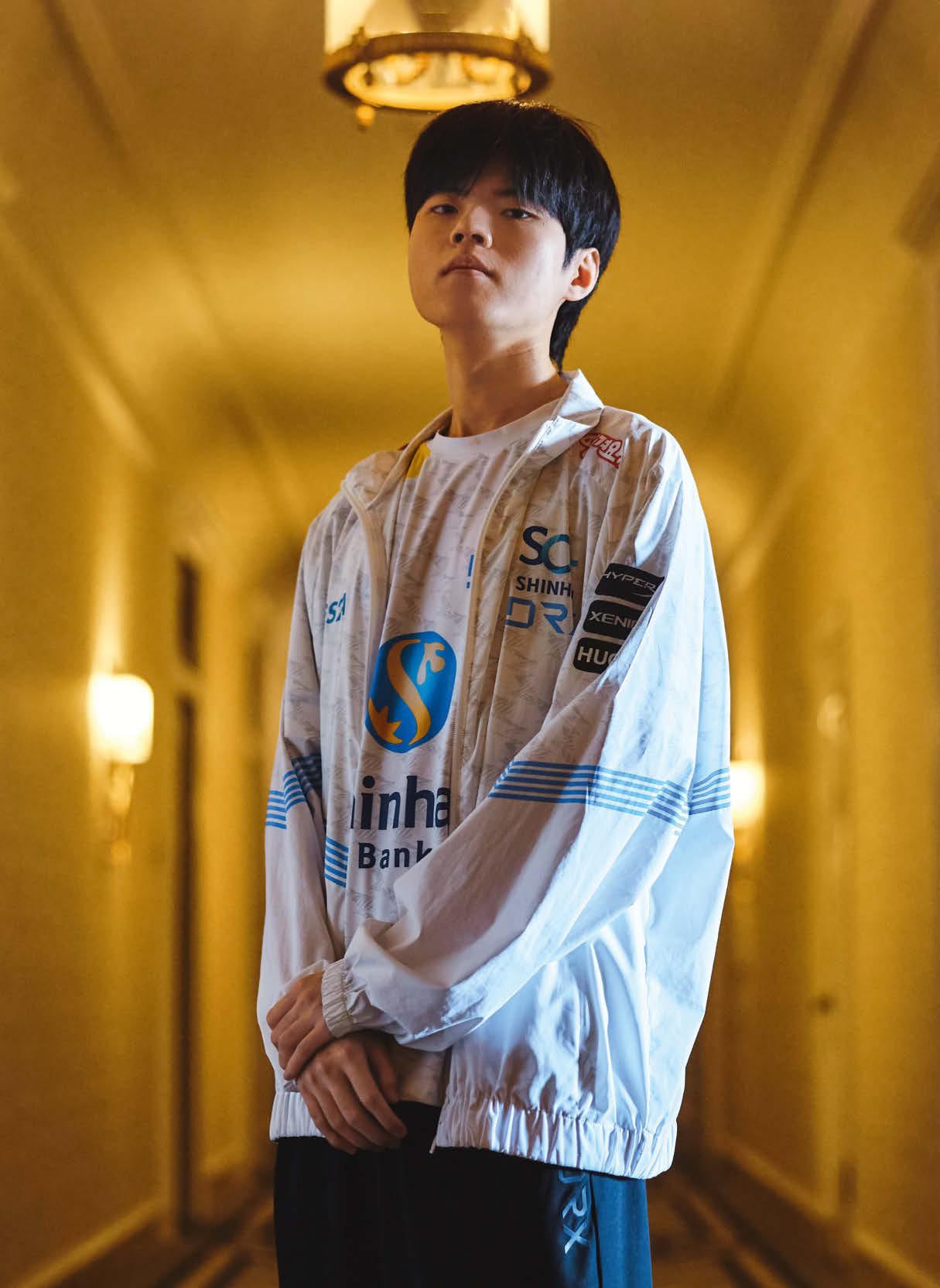
“The important thing is an unbreakable heart” Deft
I’m simply Faker. And I’m the best League of Legends player in the world.”
Until he wasn’t.
For Deft, accomplishing his dream of winning at Worlds meant that he could finally find some release. For much of his professional career, he ended each night by laying his head on a pillow and reviewing League of Legends. “I don’t think of League any more,” said the DRX star player a few weeks after his Worlds title. “I just take a good sleep.”
Deft was 26 at the time of his triumph, making him the oldest player to ever win Worlds (a distinction previously held by Korea’s Kang ‘Ambition’ Chan-yong, who was 25 when his team, Samsung Galaxy, won in 2017. He retired a year later). Deft could have railed against all his naysayers, but he didn’t. Perhaps because he was once one of those doubters himself.
“It’s paradoxical, but I’m aiming to win Worlds in order to quit this game,” he said before the final. “If I win, I’ll finally be able to quit without regret.”
That retirement plan had seemed remote. Before Worlds 2022, DRX looked unlikely to even make it into the LCK regional playoffs – a feeder series into the tournament. During an interview at the time, Deft said he thought DRX had a less than 30-per-cent chance of making it to Worlds. “Realistically, I thought we had less than 10 per cent,’’ he later admitted. “I just wanted to give some hope to our fans.”
 Legends in the making: DRX’s managers rush onto the stage to celebrate with their victorious players
Legends in the making: DRX’s managers rush onto the stage to celebrate with their victorious players
As the Chase Center crowd erupted to their feet, Deft tore off his headset
When DRX squeaked into the tournament, it was as one of the weakest contenders in the 24-team field. Expectations of them making it through the group stages was next to zero. In an astonishing press conference ahead of the final, someone asked T1 how their match would go against DRX. One by one, they answered without hesitation.
Oner: “I believe we will easily beat DRX 3-0.”
Keria: “I believe it will be 3-0, too.”
Gumayusi: “I bet 3-0.”
Faker: “I hope we win 3-0.”
In 1964, a young Cassius Clay taunted his rival, world heavyweight boxing champion Sonny Liston, by driving a bus to his house decked with the proclamation: “Sonny Liston will go in eight”. Clay won the bout in seven rounds. Yankees baseball star Babe Ruth, so the legend goes, ‘called his shot’ before hitting a home run in the 1932 World Series. T1 unleashed four such displays of audacity in 14 seconds.
But behind the scenes, Deft’s sad-sack, perpetual Charlie Brown disappointment had given way to tougher resolve. This was no easy transition. He’d never advanced beyond the semi-finals and his annual heartbreak once led him to describe his October 23 birthday tradition thus: “Usually, I just spend that day in my room after losing at Worlds.”
In 2022, it looked as if his balloons would pop again when, during the quarter finals at Madison Square Garden in New York – on precisely October 23 – his tactics imploded against EDG, his former team and the now-defending Worlds champs. With Deft mere moments from destroying the enemy Nexus, an inhibitor respawned in front of him. To anyone familiar with LoL, this is a tragedy of misfortune; to the uninitiated, it’s best described by one commentator who compared it to an NFL running back tripping on a bump of turf one yard short of the end zone. Or, as the shoutcaster exclaimed, “Oh no! The game was in your hands, Deft!”
In previous years, this is when Deft’s candles would blow out; when he would buckle up for a day of room service and silence. “I couldn’t believe it,’’ he wrote on The Players’ Tribune “I’ve never experienced anything like that in my entire career. To have it happen… at Worlds… in the quarter-finals… against that team? I asked myself, ‘Am I really not meant to win?’”
But this time, Deft didn’t stop to dwell on his predicament. Between that loss and the next game, he simply determined to play better. “I didn’t feel bad for myself,’’ he wrote. “In a way, that set me free. I felt empowered.”
Erzberger was one of the few people outside of DRX who saw Deft’s self-doubt morph into that unbreakable heart. “For most of the tournament, he was looking down on himself,” he recalls. “[He was] like, ‘I’m trying my best, but I don’t know if I can get there.’ But by the time he made the final, he’d lifted those expectations off his shoulders. In the end, magically, they won it all.”
In that victorious moment, as the Chase Center crowd erupted to their feet, DRX – impassively locked to their screens a split second before – all burst into tears. Deft tore off his headset and threw it away. “I usually never express my joy so dramatically,” he recalls. “But I was jumping around the stadium. My body moved before I could think. It just said, ‘Run really fast.’ So I ran.”
“No fourth seed has even made it to Finals, let alone won the World Championship,” declared shoutcaster Kobe, incredulously. “The group of friends that made the miracle run.”
At a press conference afterwards, a reporter asked Faker if he had anything to say to his old high-school colleague. “I want to tell him congratulations,” he replied, sincerely. “He is a player that truly deserves this trophy.”
Ayear later, Worlds 2023 – like a binge-worthy television show hoping to retain its freshness – could return with a complete cast reboot. Less than three weeks after the 2022 final, Deft, instead of retiring, signed with DWG KIA in a blockbuster announcement. In fact, every player from DRX departed except one – BeryL.
At first glance, it seems shocking, saddening even, that such a winning collective unravelled so quickly, like a band that breaks up after releasing one transcendent album. But DRX was never built to be a world-champion team. The minute the players achieved fame, others came to poach them, and there wasn’t the money or resources to hold onto them. It’s as if a smalltown football team won the Super Bowl. The economic realities only underscore just how amazing DRX taking home the trophy really was.
Faker remains with T1, but, sidelined with an injury for most of the summer, his team faltered. Without their talisman, they lost five games in a row, plummeting to fourth-worst in the league, almost certain to miss the LCK playoffs. Then, on August 2, LoL Esports declared that Faker was back in the starting line-up. The same day, T1 defeated opponents Kwangdong Freecs. The headline: “The Return of the King”.
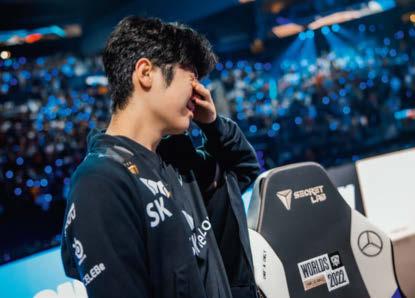
One thing is for sure: whoever rises up to deliver this year’s legend has some big headsets to fill.
“It’s a high bar, but we can’t wait to blow fans away with what we have in store for Worlds 2023,’’ says Aletaha of the tournament, which kicks off in Seoul before travelling to Busan then back to Seoul – two metropolitan areas that account for a third of South Korea’s population. “Bringing Worlds to the LCK’s house is a fitting next chapter.”
League of Legends is coming home.
Worlds 2023 begins on October 10, with the final on November 19. Watch it on Riot Games’ Twitch channel: twitch.tv/riotgames. Check out the documentary on last year’s Worlds Final, DRX The Rise, at redbull.com
At 21 years old, footballer TRINITY RODMAN has already achieved more in her sporting career than many do in a lifetime. And, after being part of a US national side knocked out of the World Cup this summer, she might just be a better player than ever
Words PETER FLAX Photography WOLFGANG ZAC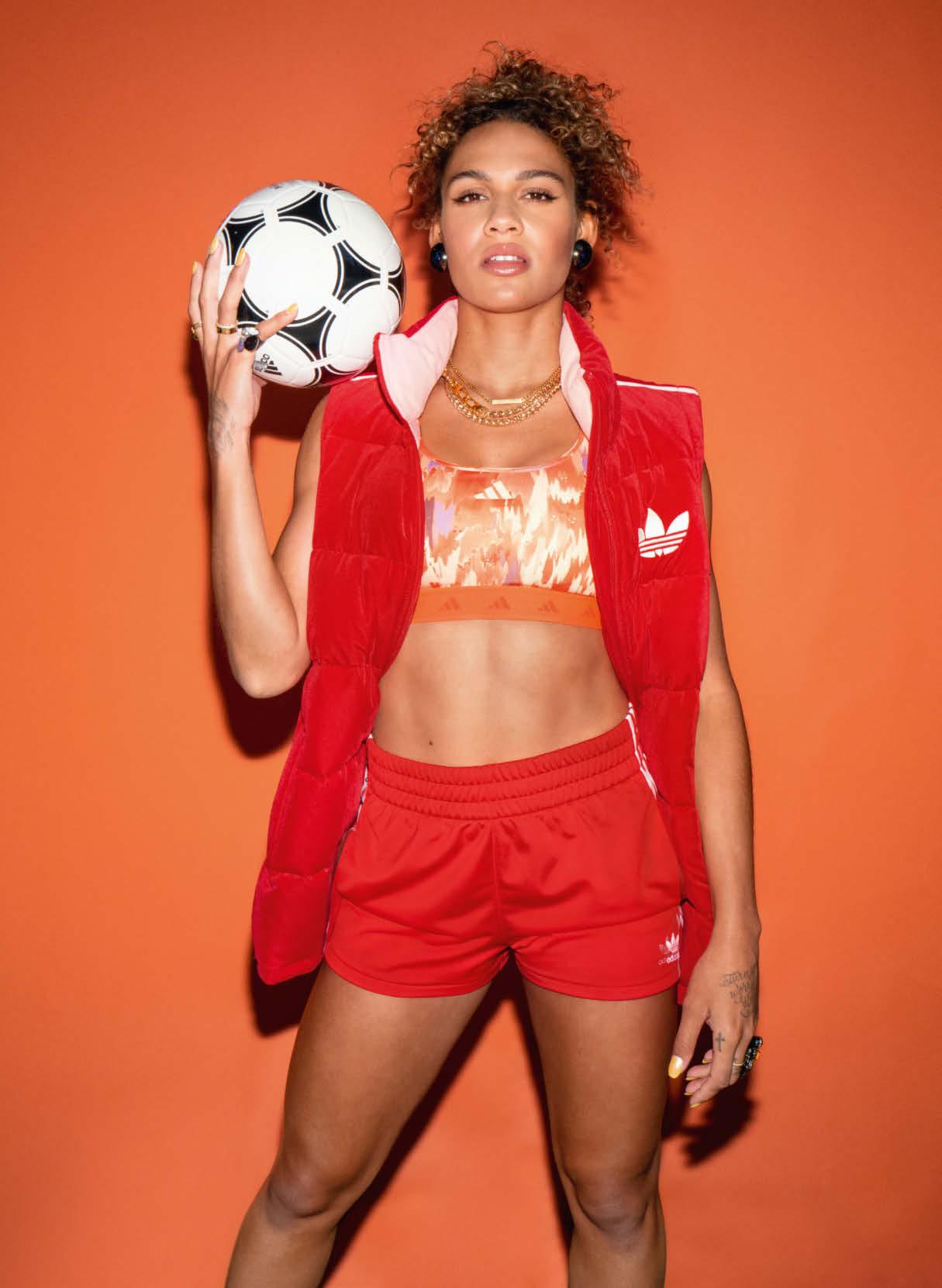 Free spirit: Trinity Rodman, photographed for The Red Bulletin in Springfield, Virginia, in April this year
Free spirit: Trinity Rodman, photographed for The Red Bulletin in Springfield, Virginia, in April this year
Star power: “I think she has the quality to be something that this planet hasn’t seen in women’s soccer,” says Rodman’s team coach Mark Parsons
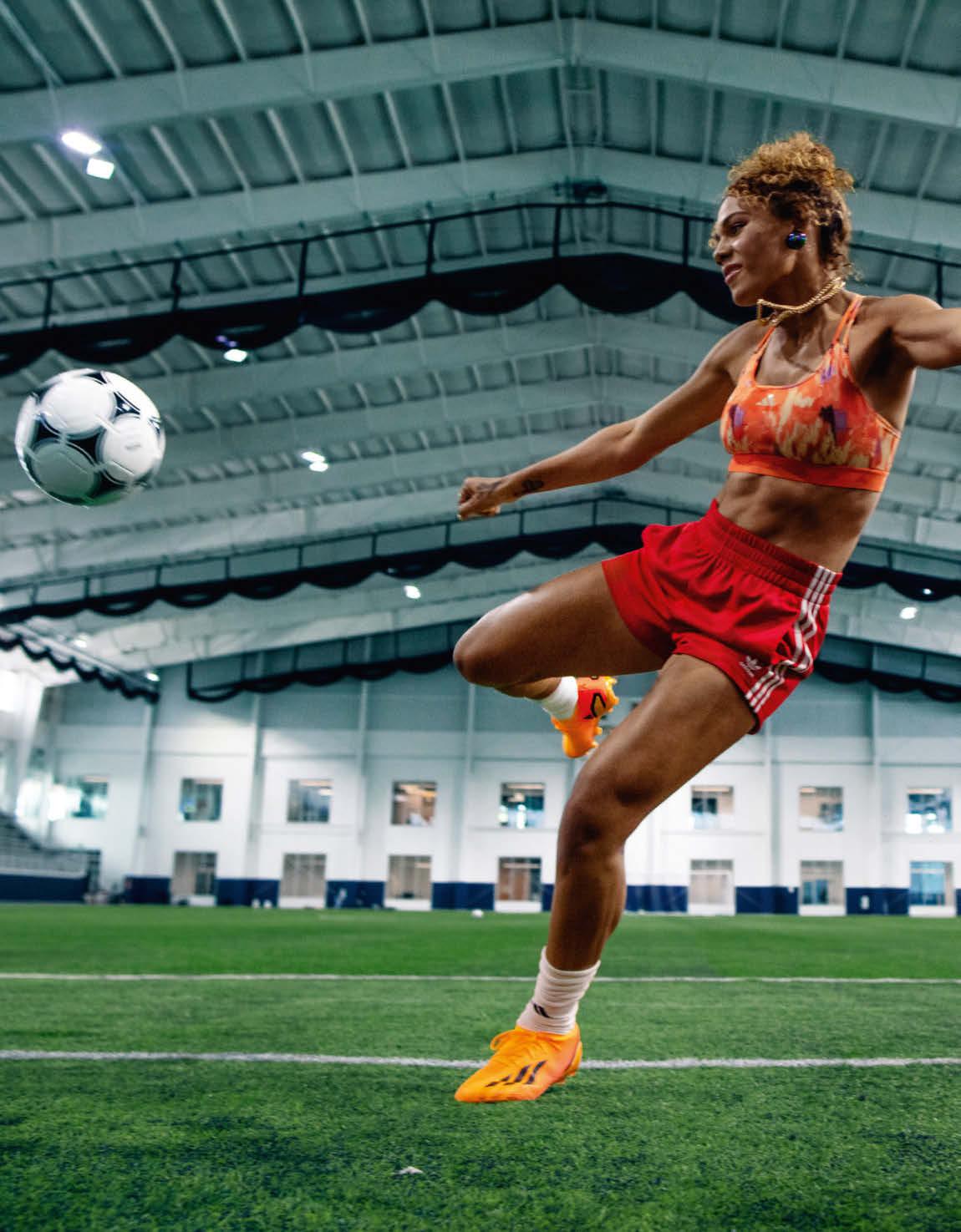
or all but the victors, a FIFA World Cup ends in bitter disappointment. This was especially true this year for the US Women’s National Team (USWNT), four-time World Cup winners and defending champions who left the competition in the round of 16, in what was the USWNT’s worst-ever finish.
But with the sting of defeat dulled a little by time, it becomes possible to see the positives. For a side with the weight of expectation heavy on their shoulders, blighted by injury, and with 14 players in the squad making their World Cup debut, there were bright shoots of promise from a new generation finding their way on unfamiliar turf. And some of the brightest came courtesy of Trinity Rodman.
Rodman was far from a certainty to make it to the tournament in Australia. But not only did she end up starting three out of the USNWT’s four World Cup matches, she was also a constant thorn in the side of the opposition. Even in defeat, Rodman’s star power was clear. The ability to make something out of nothing. To lift fans out of their seats.
Though still only 21, Rodman is the object of outsize expectations when she steps onto the pitch. She’s been in the spotlight for a relatively long time – at first for being a precocious talent with a famous last name, and then for being a prolific talent busy making her own name.
Rodman’s inexperience as part of the USNWT belies a playing record that few other young players could hope to match. She reached the professional National Women’s Soccer League (NWSL) without playing a single game
Fin college and wrapped up her debut season with the Washington Spirit as the league’s Rookie of the Year. She provided the assist for an NWSL Championshipclinching goal. Last year, Rodman signed a seven-figure contract extension with the Spirit that reportedly makes her the highest-paid player in NWSL history. And, in only her third season, she made it to her first World Cup.
On a wet and miserable evening at Audi Field in Washington, DC, back in April, Washington Spirit and the Houston Dash play in driving rain. Rodman is all over the pitch, trying to make something happen. In the first 25 minutes, she sets up two corners and pulls off a skilful pass to give a teammate a solid shot on goal. She’s clearly the fastest player on the pitch and she’s pressing hard, even in defence, like she can’t bear to stand still.
There’s an old chestnut that we’re all products of our environment; that we’re shaped by the things that happen to us. This is true, of course, but it’s also true that we are not simply actors in the drama of our lives; we’re the screenwriters, too. Consider Trinity Rodman careening around the waterlogged confines of Audi Field. She’s not such an imposing force by some glorious cosmic accident. This kind of effort takes something beyond talent. It takes thousands of hours of work. It takes a hunger. When you watch Rodman in action, all her strengths – her world-class speed and skill, but also the tenacity, creativity and joy that she brings to her game – are on full display. “I think my personality comes through in the way that I play,” says Rodman. “I feel so much freedom when I’m playing.”
Two days after that soggy match, Rodman is hustling around a cavernous indoor training facility in suburban Virginia, juggling as a videographer captures 360° footage with an airborne camera, and dribbling around cones with disarming fluidity as another content creator huffs by her side. Meanwhile, her mother Michelle sits in a quiet corner, showing a reporter old Facebook videos foreshadowing Trinity’s greatness.
In one, uploaded in August 2011 –meaning the girl with the ponytail was nine – Rodman is off, dribbling past several defenders. Someone is shouting at her to shoot with her left foot, but instead she uses her right to slot the ball

cleanly into the bottom corner of the net. “She started playing soccer when she was four,” Michelle recalls. “She had this clarity about it even then. She would come off the field on the verge of tears and ask, ‘Mom, why isn’t everyone else trying to win? We need a goal.’”
Michelle believes that this focus to dominate on the pitch is a response to chaos off it. People who have followed Rodman’s career know that her father is NBA legend Dennis Rodman. Trinity isn’t keen to discuss the past, present or future of that relationship – she’s focused on establishing her own legacy and on the people who have been by her side the whole way, namely her mother, her brother DJ and older sister Teyana.
Michelle says that Trinity experienced plenty of obstacles growing up. Often, other girls were cruel to her, and as she developed as an athlete, people assumed she was advantaged by a life of privilege, heading from training to a mansion. But the reality was entirely different: Michelle was raising these kids as a single mum, struggling financially, sliding from one rental to another around Newport Beach, California.
At one point, home was a motel, where the family shared a room and heated frozen burritos in the microwave for dinner. Michelle tried to frame the situation around the positives: the way Trinity and DJ could make waffles at the Comfort Inn’s free breakfast every morning, or take a dip in the small pool before school, or bounce on the beds
after dinner. “My goal was always to keep them busy,” Michelle says. “I tried to keep their minds focused on goals.”
So is it any surprise that the football pitch became a refuge for Trinity? “Growing up, people didn’t really know what my family and I were going through,” she says. “They didn’t know what we had or didn’t have. But when I was on the pitch, everything was equal – there was no talk about finances or living situations or family stuff. It was just soccer – the ball and the pitch and me. I was always happy on the field. And I still feel the same way.”
From an early age, Trinity and DJ – separated by only a year – were intensely competitive. “I’m a lifelong basketball player and she’s definitely more competitive than any teammate I’ve ever had,” says DJ, who has NBA aspirations and recently transferred to the University of Southern California to play his final year of college basketball.
“To say it bluntly, she always wants to win. She really doesn’t like to lose.”
DJ says he knew his sister was something special when she was in
second grade, and he goaded her to play in a basketball league – a sport she didn’t like or have experience playing. But she ended up playing against fifth graders and more than holding her own. “That’s when you know someone is a truly great athlete,” he says. “When they’re that good at every sport.”
Still, football was always her first love. And when Trinity was 10, her trajectory in the sport changed when her mum took her for a trial at the Southern California Blues, a youth club that’s a force in the Greater Los Angeles region – the unparalleled hotbed of football talent in the US. Rodman’s raw athleticism and obvious drive impressed the coaches and she made the squad, playing with the club until she was drafted.
The simplest way to summarise Rodman’s youth progression as a football player is that she kicked ass. She helped propel her club team to a national championship, and two different highschool squads to glory. She was first invited to play with the national team when she was 13, going on to represent the under-16s, under-17s and under-20s. In the 2020 CONCACAF Under-20 Championship, which includes teams from North America, Central America and the Caribbean, Rodman scored nine goals in seven games to help lead the US squad to an undefeated run through the tournament.
After her high-school career was over, Rodman enrolled to play and study at Washington State. But before she could play her first collegiate game, the season was cancelled due to the pandemic. NWSL rules prohibit high-schoolers from entering the draft, but now Rodman had cleared that hurdle. On January 13, 2021, the Washington Spirit selected Rodman as the number two pick, making her the youngest player ever drafted in the league’s history. She was 18.
This was the first of many firsts for Rodman. A few months later, minutes after entering her debut professional game, Rodman neatly controlled a long pass before executing a powerful finish, making her the NWSL’s youngest-ever scorer. She was in the starting line-up in the following game and ended up leading the league for assists that year.
“Honestly, my rookie year was my easiest so far,” she admits. “Nobody knew what I could bring to the table. There basically was no pressure on me.”
 Always a threat: Rodman in action for the USNWT against the Republic of Ireland in an international friendly match in St Louis, Missouri, this April. The US team came out on top with a narrow 1-0 win
Always a threat: Rodman in action for the USNWT against the Republic of Ireland in an international friendly match in St Louis, Missouri, this April. The US team came out on top with a narrow 1-0 win
“The best way to deal with pressure is to just ignore it”
Loving life: Rodman has a fun, accessible social media presence. “I want people to see that I’m a regular person and not just a famous soccer player,” she says

Burning ambition:
“To put it bluntly, she doesn’t like to lose,” says her brother DJ
slams it into the top of the net. The two teammates exchange an absurdly formal handshake, like they’re sealing a business deal. The Spirit win the match 3-1, and Rodman, who is two weeks shy of her 21st birthday, ends the afternoon as the youngest player in NWSL history to notch up 10 career goals and 10 career assists.
But this isn’t the only way Rodman is impacting the women’s game. You can see it when you walk around Audi Field during a Spirit match. There, hordes of adolescent girls, many wearing official shirts with Rodman’s name and number on the back, jump to their feet and shout every time their favourite player charges down the wing.
These girls, who later crowd the edge of the field for an autograph or a selfie, love the dynamic way Rodman plays, and also the youthful, human side she shows when she posts dances on TikTok, or asks her followers for colour suggestions as she does her nails live on Instagram. “I want people to see that I’m a regular person and not just a famous soccer player,” she says.
It’s a Saturday afternoon in early May, and the sun is out in Washington, DC. The San Diego Wave – led by the striker Alex Morgan, co-captain of the USNWT – are visiting Audi Field. With both teams sitting near the top of the NWSL standings and more than 12,000 fans in attendance, it’s a big game. Though Washington controlled the first half, the score is even until the 55th minute when Spirit midfielder Ashley Sanchez gets the ball in open space and delivers a sharp pass behind the defence. Rodman and a defender race at full speed for the ball. In desperation, the defender lunges to deflect the pass, but she can’t quite reach it. Yet Rodman, running full pace at a different angle, tracks it down and hits a shot that sails into the goal, inches below the left hand of the keeper.
The stadium erupts and Rodman flaps her hands over her head in jubilation. Fifteen minutes later, she ignites another round of celebration. Rodman receives the ball outside the box and accelerates from a jog to a sprint, running diagonally at goal. As she nears the box, at least four defenders are on her. Just at the moment when it looks like she might try a spectacular chance shot, she crosses with her left foot to Sanchez, who’s streaking into open space. Sanchez

Perhaps no one can better appreciate the combination of talents that Rodman brings to the pitch than her team’s head coach, Mark Parsons. “I think she has the quality to be something that this planet hasn’t seen in women’s soccer,” he says, itemising the strengths that his young star brings to the table. Her world-class athleticism. Her competitive mentality. Her technical skills. Her decision-making instincts. Her work ethic. “It’s rare that you find a player with all these qualities, and she’s only 21.”
Parsons describes the intense challenge that opposing defenders face when trying to cover Rodman. “She can of course run behind you,” he says. “But she also can dribble at your left or your right. She can shoot with both feet. She can pass across and combine with her teammates. You have to be greedy as a striker, but she understands that she wants to feed easy opportunities, too.”
All professional players have a high level of commitment, but Parsons says Rodman possesses something extra. “When we don’t have the ball, Trinity chases, hunts and presses like her life depends on it,” he says. And this diligence isn’t something that only plays out in the physical realm. Parsons, recalling the flight back to Washington after a recent game in Orlando, says
“I think my personality comes through in the way that I play”
that Rodman spent her time in the air watching a replay of the game they’d just finished. Twice.
There’s a YouTube video, unironically titled Trinity Rodman Soccer Highlights That Will Blow Your Mind!, that showcases the flair Rodman integrates into her play. She runs down balls that shouldn’t be reachable. She nutmegs hapless defenders. And perhaps most of all, she makes gorgeous crosses to teammates, as if she has intuited all the angles before she even receives the ball.
“I definitely don’t practise that kind of stuff that I do in games,” Rodman says when asked where this on-field creativity comes from. “It just kind of happens. But as soon as a game begins, my feet just start moving.”
Talking to any 21-year-old, even a high-profile professional athlete, about the future is always strange. They’re too busy wrestling with the present and absorbing the recent past to have much bandwidth or interest to peer into the future. Rodman is committed to having a good time. Being serious about performance, she insists, does not require a moratorium on fun.
This perspective comes through loud and clear in Rodman’s social media presence. On Instagram and especially TikTok, Rodman is accessible and funloving. “You’re never going to shut me up,” she laughs. “I’m always dancing. I’m always singing around the [practice] facility and the locker room. I’m always telling jokes and messing with people.”
This approach even impacts Rodman’s preparation for big games, where she’s more likely to record a dance clip for TikTok than meditate in silence. “I know a lot of athletes like to spend those moments with headphones on, locked in,” she says. “But I’m the opposite of that. I need to be carefree and listening to music – I play my best when I’m not overthinking or feeling isolated from the world. I want to feel connected with everybody.”
Parsons has zero issues with his star’s easy-going demeanour: “I know some coaches who would think she doesn’t care because she’s laughing so much. I care about the player being ready to perform. Trin is very loose, full of joy, and you can see in critical moments how she’s full of passion. You can see her bring joy to the biggest moments.”

Unsurprisingly, Rodman doesn’t have a simplistic answer when asked how she manages pressure. She holds herself to a very high standard, which influences her approach to preparation – whether it’s in the weights room or during drills or studying replays. But beyond that, she tries to filter out external pressures. “The best way to deal with pressure is to just ignore it,” she says. “Everyone has opinions, but I have a sense that I got here for a reason, and outside pressures do nothing but set your own expectations too high and start impacting on every little detail of your game.”
This sounds tricky, holding herself to a very high standard while tuning out things that would raise her own expectations. “I think the best way to become the best player is to fail all the time,” she explains. “And allowing myself to make mistakes has helped my game and my mental wellbeing.”
The 2023 World Cup may not have been a triumph for the USNWT, but the experience will prove to be an essential stop on the journey to Trinity Rodman becoming the best player she can be. And beyond the black-and-white scoresheet of wins and losses, it’s a scene in the screenplay of her life.
“Outside of team principles, every single player on the pitch has the ability to do essentially whatever they want,” she says. “Every player has the ability to be as creative as they want to be, to do dangerous things, to put on a show. There’s something so entertaining about that. I don’t think soccer is just a sport.”
Instagram: @trinity_rodman
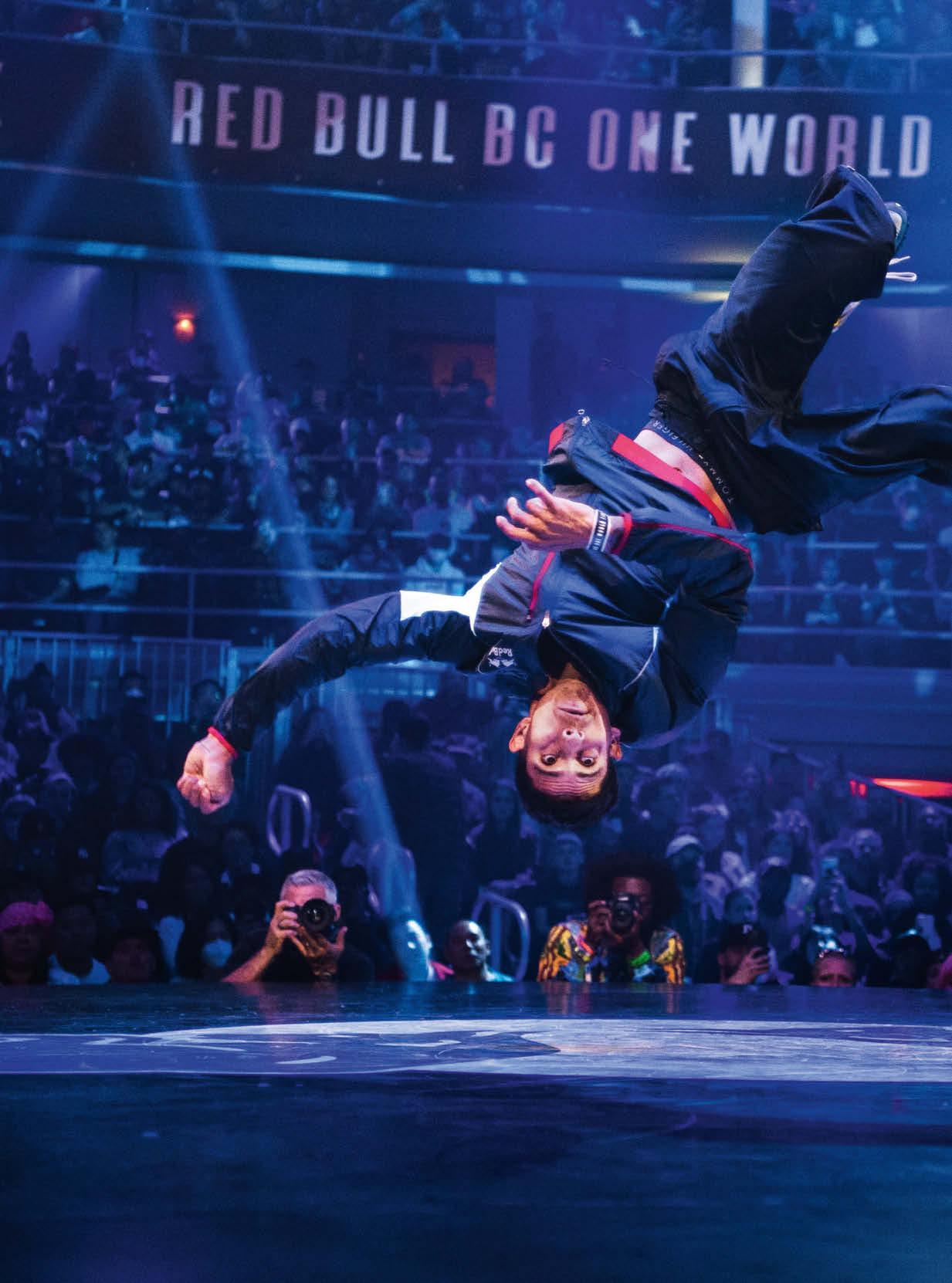 All hail the Victor: B-boy Victor brought his A-game to the Red Bull BC One World Final in New York last November and took home the title – his second
All hail the Victor: B-boy Victor brought his A-game to the Red Bull BC One World Final in New York last November and took home the title – his second
Since 2004, breaking competition RED BULL BC ONE has seen the best B-boys and B-girls from every corner of the globe do battle for the ultimate prize: victory at the World Final. Ahead of this year’s pinnacle event in Paris, five iconic breakers reveal what it takes to win Words PH CAMY and

The 29-year-old Angeleno has won Red Bull BC One twice (Rome, 2015; New York, 2022). The defending champion is confdent of a third win, then victory at the Olympics next year

Did winning Red Bull BC One in New York last year change people’s perception of you?
victor: It changed a little, like people saying, “Wow, you’re the BC One world champion.” It’s like a high that doesn’t stay too long – everyone sees you as one of the best for that year. But it’s an amazing feeling to be on top of the world for [even] a little moment.
How did your training change in the lead-up to that win?
I took things more seriously as I wanted to give myself the chance to win a second time. I’d reached a point where I didn’t want to break any more; I fell out of love with it. I didn’t want to practise. But BC One brought back the love for me. Why did you lose your passion for breaking?
It felt like the same cycle: you win, you lose… It wasn’t fun any more, and nothing new was coming – until the Olympics. Finally, there was a new goal. It’s outside the breaking scene – we’re a sport now. It’s also exciting because of endorsement opportunities, sponsorship…
What’s the LA breaking scene like in 2023?
The US might get mad at me, but honestly the breaking scene here is dying. I feel like right now California is the only place it’s thriving, where there’s still a bunch of competitions and a lot of breakers. There’s also a new generation of dancers coming up in California, which is pretty exciting. But it’s not as big as it used to be. With the Olympics coming up, what’s your mindset? Definitely to dance more.
I stopped for a while – I was only practising before a big event – but now I’m more like I was as a child, wanting to create new moves. I’ve refound my love of breaking. The Olympics is my new goal. Do you think you can win Red Bull BC One again?
Yes, absolutely, because my best quality is my style, which is sporadic and energetic. And also the way I dance, and my ability to adapt in the moment. If I run out of moves, I can just use my character. It can be anyone’s day, to be honest. But sure, I have another chance to win.
If you win the Olympics, what’s next? Do you think you might get bored again without that goal?
To be honest, lose or win, I just want to have a family after the Olympics. And I’m planning to start a business – I want to build a calisthenics park next to my house so that breaking becomes my second or third income. I want to be able to enjoy the dance again. With breaking, you have so much travel and so many competitions during the year, and I don’t want to have to rely on winning them to pay my bills. After the Olympics, I want to slow down on breaking for a year so that I don’t burn myself out.
Instagram: @supamontalvo
Algerian-French B-boy Lilou won Red Bull BC One for the frst time in 2005 and never returned the belt, so now they make a new one every year. This tough but friendly icon of world breaking embodies the spirit of the battle
Who was B-boy Lilou before winning Red Bull BC One in Berlin in 2005?

lilou: I was a group dancer. I never imagined I’d become an international solo dancer. What helped you win?
I won because I wasn’t focused. [Laughs.] I’d actually injured my fingers at the hotel two days before the final, and I showed up with nothing to lose and no pressure. The pressure was on the other dancers. I danced with a smile on my face.
“If you’re not ready mentally, too, you won’t do your best”
Winning Red Bull BC One in Berlin propelled me into the elite of international dancing. It made me a great dancer. From that point onwards, I was a big name in breaking. I’d thought it was just another international battle, but over the next few months, when I saw the impact of my win, I came to understand that Red Bull BC One and its incredible line-up of the 16 best B-boys

on the planet had become the unofficial breaking world championships. And you won again in 2009
– this time in New York, the birthplace of breaking…
That was my greatest victory –for two reasons. First, because it happened in the country, the city, where the whole thing was invented, in front of the trailblazers. It was [the equivalent of] winning the FIFA World Cup in Brazil. It also allowed me to honour my
second nationality, which is Algerian. The victory in Berlin was for France, and the one in New York was for Algeria. That was amazing. What will it take to win in this year’s final in Paris?
A good state of mind. You may be ready physically, but if you’re not ready mentally, too, you won’t do your best. Every dancer has their own personal journey, and those who can show character are more likely to do well.
Who should we keep an eye out for in October?
Out of the guys, I’d say Dany. He may be 35, but he’s the stand-out French dancer on the international stage today and he’ll be motivated. On the women’s side, watch out for Kimie and Syssy. They’re young, but they’re already at a really high level. There’s been real equality in breaking ever since Red Bull BC One opened up to women in 2018. Instagram: @lilou_offciel
When Red Bull BC One opened up to women in 2018, Japanese dancer Ami made history and paved the way for B-girls worldwide

How did you win Red Bull BC One in Zurich in 2018?
ami: I practised so hard for that day, so my effort was one of the reasons, for sure. But on the other hand, there’s always luck in the battle. I guess I must have been lucky that day.
You were the first woman to win the title. Were you aware at the time of what that meant for B-girls around the world?
Yes. But it wasn’t just me – all 16 of the B-girls who were there made history together. I’m glad if I’ve helped to inspire a generation of dancers.
You were just 19 when you won. Did it change you?
No, I’m still the same. But I got so much more experience after winning. I’m so thankful for that. Now, me and my sister Ayu are working towards securing a spot at the Olympics.
How do you feel about the prospect of competing at next year’s Olympics, when breaking makes its debut?
I’m still not sure if I’ll be able to stand on that stage. But if I do get the chance, I just want to represent my style there. I do my stuff whether I’m on a sports stage or a culture stage.
Has winning Red Bull BC
One made you a stronger contender for the Games?
It’s process and experience that make us strong, not results.
What do you remember most about competing at Red Bull BC One?
For me, there’s already so much meaning just standing on the BC One stage, regardless of whether you win, because it has already witnessed so much history.
Instagram : @gfc_ami
“It’s process and experience that make us strong, not results”JASON HALAYKO/RED BULL CONTENT POOL


With two wins at Red Bull BC One, making her the most successful B-girl to date, Kastet has proved she has a lot more than luck on her side. Here, the 25-year-old looks back on her unique experiences in the competition

Who were you when you won Red Bull BC One for the first time in Mumbai in 2019?
kastet: To be honest, I didn’t know myself well before this victory. I was only 21 years old. I was a child without any internal crises. I just danced without really expecting anything from myself. What do you think helped you win the competition?
I think my freedom and the fact I didn’t care much. No one knew me and I didn’t expect anything from myself. And feeling creative – the most beautiful things happen in this state of mind. What do you remember about the experience?
For me, the whole trip was strange. Before I flew to Mumbai, I stood outside the house and cried. I told my husband that I didn’t know why I was going [to compete], and that I didn’t know how to dance. Then, on the day of the selections, I crossed my fingers and hoped I would pass that stage at least.
You won again in Salzburg the following year. What kept you at the top? The second victory was also strange. Coronavirus happened, and I almost didn’t train – I stayed at home and watched cartoons.
After the first victory, some people said I was just lucky, which annoyed me, even though sometimes I thought they were right and that it was just luck. I wanted to prove to myself that wasn’t the case, so after about two months I started training seriously again. Nothing really kept me on the top; I just remained myself in [both] my inconstancy and my creative impulses.
At the 2020 final, there was no audience because of COVID restrictions. Was that unsettling?
No, it was absolutely fine. I adapted. Sometimes I can create such a celebration and such an audience in my inner world that I don’t need anyone else.
How important is the audience during a battle? The audience is important. It gives [the dancers] energy, but sometimes it also exerts pressure. The best audience is the one that understands dancing. Which B-girl do you think will win Red Bull BC One this year in Paris?
I believe that everyone has an equal chance of winning. Each [dancer] is unique; each person has their own day. It will happen as it should happen.
Instagram : @kastet316
“Feeling creative is key – the most beautiful things happen in this state of mind”LITTLE SHAO/RED BULL CONTENT POOL
With two Red Bull BC One victories to his name, won years apart, the 38-year-old Korean is persistent. After more than 20 years as a B-boy, he knows how to fnd success regardless of the fnal result
You won Red Bull BC One in São Paulo in 2006, making you the competition’s first Korean champion. What was the breaking scene like in your country at that time?
hong 10: When I won the BC One title in 2006, the Korean breaking scene was in its golden era. Breaking was everywhere, from concerts to TV commercials. However, my win during the 2006 BC One World Final wasn’t highlighted too much. Of course I was happy to become the world champion, but the local scene didn’t really view it as something special, as there were so many events that Koreans excelled in.
Who were you as a breakdancer at the time of that first Red Bull BC One victory?
I started my career as a breakdancer back in 2001,
and already in 2002 I was quite well-known on the breaking scene worldwide. I participated in numerous solo battles, but until I won that BC One title in 2006 I would always finish in second place. I didn’t give up, though. I was a constant competitor who was never afraid of a challenge.
You won BC One again years later, on home soil, in 2013. What happened during those years in between?
I tried multiple times to bring back the title, but every time I tried I couldn’t make it. I felt that maybe I was getting too old – I was already 30 and I still had to do military service. In the end, I still found time to practise. My military service was very much like a regular job – I was working at a public train station. Whenever I got back home, I cut down my
sleep time and continued practising every single day. My life was all based on work and practice. Thanks to this, I was ready for the final [in Seoul] in 2013.
What skills will the B-boys and B-girls have to display to win in Paris this year?

In other competitions, there would be only four to five competitors who have the potential to win. But in BC One you never know what’s going to happen. My plan would be to be myself. I always like to be the original me, a unique character. I want to show who Hong 10 is. And I truly believe this is what other dancers should do. They need to show their own original flavour. There’s always going to be that one winner, but if you show originality, losing is not that big of a deal.
Instagram : @bboyhongten
Let’s parquet: Hong 10 takes to the floor at the Red Bull BC One Cypher in Almaty, Kazakhstan, in June last year“Every dancer must show their own original favour”
Hip hop was born out of a disastrous socio-economic context. Mass unemployment and gang warfare went hand in hand in the projects of the Bronx, New York, in the 1970s, consuming an entire generation that was left to fend for itself. In hip hop, those who felt ignored by the system found a voice of protest and a means of self-expression. Hip hop and its fve disciplines (breakdancing, MC-ing, DJ-ing, graffti and beatboxing) became a way – and a celebration – of life.
But while the desire to be the best is in hip hop’s DNA, and competition has always been a part of breaking, fnding a uniform way to judge what is essentially a subjective art is no simple matter. Breaking was born on the streets and nights out. In clubs and at block parties, dancers would get on the foor and perform their best moves in the ‘break’ in the song being played by the DJ. Over the course of an evening, the dancers would end up forming a circle, with the prowess of each assessed by their peers’ response. Breaking continued to develop largely along those lines from the ’70s to the early ’90s; battles were either random meetings or organised in clubs, the result based on the crowd’s approval.
Hip hop arrived in Europe in the early ’80s and developed in much the same way as the US. But 10 years later, as the interest in breaking began to wane Stateside, Europe kept this form of self-expression alive. Offcial competitions with judges appeared, one of the frst being the Battle of the Year in Germany in 1992. The event was innovative both in terms of format and method, and it would inspire all future breaking competitions. For the frst time ever, judges were invited along to decide the winner, formalising breaking competition and creating a new framework for the art form.
Even if breaking was never meant to be judged, making it competitive in no way undervalued its original form as performed on nights out and during jams. Instead, the scene received a boost. Dancers largely got on board with the idea that their art could be scored and compared with that of other dancers. And, for the frst time ever, crew members had a chance to fnd out where they ranked.
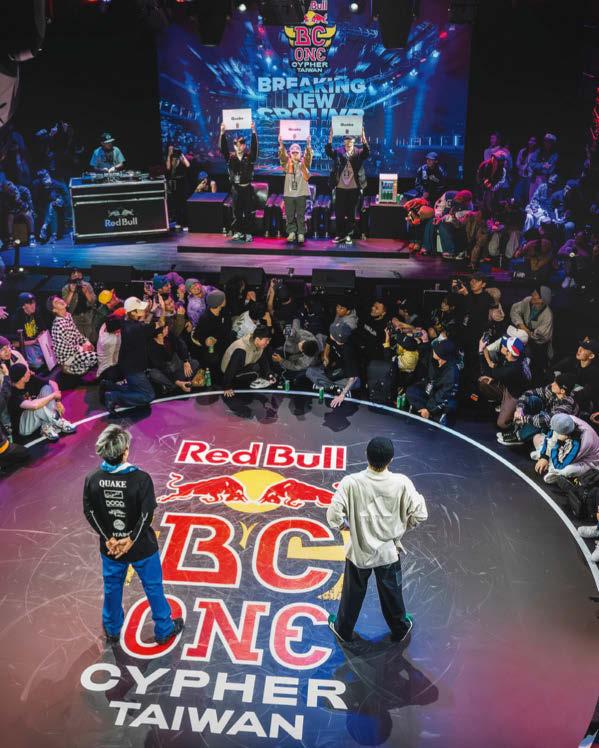
Breaking wasn’t invented as a sport. But with B-boys and B-girls set to officially become athletes at next year’s Paris Olympics, one question looms large: how do you judge an art form?
Words TOM CHAIX
The scoring system was haphazard, however, with each judge pointing at whoever they considered best. It created as many questions as it answered: who were these judges? On what criteria were they basing their judgement? And, as each and every B-boy or B-girl must have asked themselves, why should they accept this person passing judgment on the way they danced?
As a rule, judges are chosen for their expertise, their background and their understanding of the art form. They’re proven dancers who have contributed something to the culture. Each judge must make an impartial judgement based on criteria specifc to them, though this makes it inherently subjective. Is their focus on technique or musicality? Do they favour some aspects of dance over others?
Without being able to answer these questions, another new rule emerged: as soon as a breaker enters a battle, they must accept the judgement passed by the judges watching them. This scoring method is still in use, including at large competitions such as Red Bull BC One. And it usually works in practice, with a few notable exceptions – like in the Space City Classic battle in Houston, Texas, in 2021 when B-boy Jeffro wasn’t happy with the judges’ decisions and called them out on it.
But as global interest in breaking continued to rise, along with the infux of capital – and the national interests of the countries involved – it became clear that some competitions, such as the Olympics, would require numbered scoring. For this reason, scoring methods based on quantifable criteria have been invented to lend theory, statistics and justifcation to the judges’ opinions. Multiple comparable methods are currently being tried and tested at Olympic qualifying events.
One of these, the Trivium Value System, developed by Niels ‘Storm’ Robitzky (Berlin) and Kevin ‘Renegade’ Gopie (London), decodes the logic behind these scoring systems. It works as follows: each judge has a tablet with cross-faders for different criteria. They indicate the best dancer in each of the criteria, and the computer produces a fnal average score to determine the winner. This helps avoid a biased score and provides a better overall representation of their decision.
But dig deeper and it’s more complex. The Trivium method has broken down all aspects of the discipline to try to produce a complete system of scoring that evaluates each dimension of dance equally. It’s based on three main criteria (see diagram):
Body: assessing physical qualities. An evaluation of technique (endurance, balance, space management, agility etc) and the range of moves.
Mind: assessing artistic qualities. An evaluation of creativity and personality (aura, stage presence, character).
Soul: assessing interpretative qualities. An evaluation of performance (the composition and narrative of the performance, how invested the artist is in their character, authenticity) and musicality (staying in sync with the music, impact, timing – the visual impact on the off-beats, the texture).
It seems simple to judge ‘Body’ based on technique and the variety of moves, but what about ‘Soul’, which is obviously more abstract? “How can

1. The first question: how did it make you feel? Which dancers triggered an emotional response? Rely on your instinct in its purest form: who did you prefer?
2. Next, consider the musical aspect. Who was most in tune with the music and the beat? To go even deeper, was there a dancer whose moves helped you hear sounds you wouldn’t have heard otherwise?
3. It’s fairly easy to identify the main acrobatic technical moves (or power moves) used in breaking. Work out how each of the dancers
has incorporated these moves into their performance.
4. Every dancer has his or her own personality and style. Pay attention to the power of their personality, their characteristics, the way they move and communicate with their opponent. Ask yourself if they seem committed to their character; if they seem authentic and original.
5. Putting on a show is part of the competition. Is the dancer generous in the way they dance? Are they open? Are they inviting you to get involved in their story?
you judge the creative process of someone dancing if you have never done it yourself?” asks Admir Mirena, head coach for Flemish breakdancing federation Breaking Vlaanderen. “That applies in all areas. But in scoring it goes beyond that. It’s a job that requires an understanding of the artist in their entirety, of what he or she is bringing to the table, and what he or she is aiming at.”
Valentine Nagata-Ramos, a WDSF (World DanceSport Federation) judge, adds, “Sometimes judges can only express themselves in certain areas. That’s why there are nine judges for each WDSF competition, whereas usually there are three. That stops any individual having too much infuence, and aims for greater unanimity.”
The choice of judges and their expertise in what they do will be major issues in the months ahead. “In the past,” says Mirena, “scoring had never been as important a part of breaking culture as it is now.” And, as NagataRamos affrms, the stakes have been signifcantly raised. “From a physical point of view, these competitions require a consistency and training that goes far beyond anything the culture has known till now. What’s the difference between judging an ordinary battle and a WDSF competition? For decades, judging has been subjective, and it still is – except now we have statistics, and competitors have sponsors, an image, and [experience] political pressure due to performing under a fag and being supported by a government. Even though mistakes have always existed, they can now carry greater weight.”
Such a complex and complete art form being propelled into the world of sport, with little time to prepare, means this has all had to be created and learnt from scratch. Time will tell if the breaking athletes who make it to Paris are able to fnd their feet in this fresh competitive format. And, regardless of how competitors are scored, the success of breaking as an Olympic sport will ultimately be judged by the millions watching around the world.
The Red Bull BC One World Final takes place at the Stade Roland-Garros in Paris on October 21. Watch the livestream on Red Bull TV; redbull.com
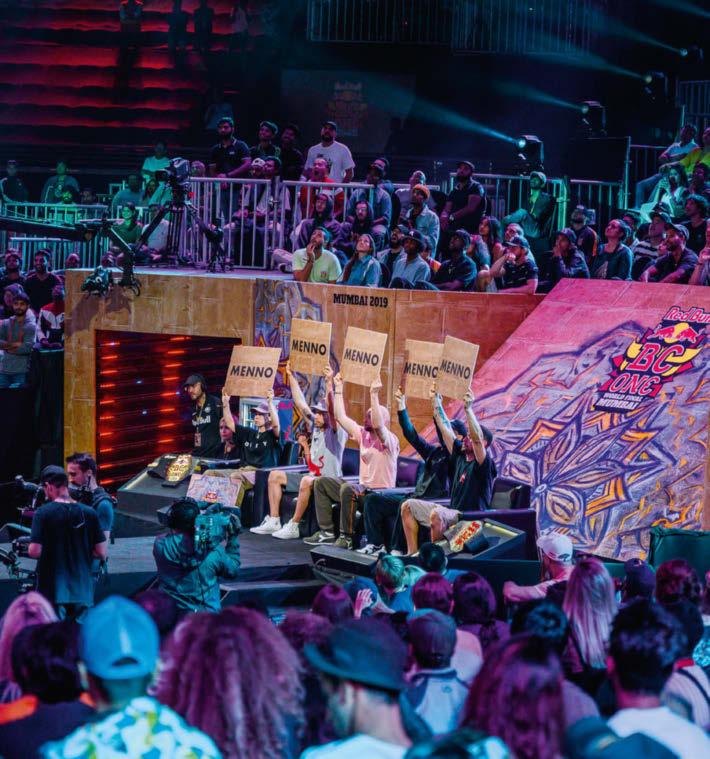
































































































































































Gravel biking from Florence to Rome, Italy

My tyres struggle for grip on the white road’s loose, lunar-like surface and, as its gradient tips into double figures, my heart pounds in my ears. A lingering cloud of dust has turned my throat into sandpaper, making every breath painful.
The terracotta-coloured viaduct that signals the halfway point of the 7km-long climb comes into view. Passing beneath it, I’m given a brief respite from the baking midday sun on this glorious May day in Italy. Pausing for a sip of water on the outskirts of San Quirico d’Orcia, a small

town 45km southeast of Siena, it’s as though I’ve stumbled onto the film set of a stereotypical Tuscan scene: Piaggio Ape vans deliver fresh produce; Italian nonnas hang laundry on their balconies; luminous lunchtime cocktails are served al fresco.
There’s no time to drink it all in, though; I still have more than 100m of elevation on this ascent alone, as well as 60km of relentless cycling along the rough paths of the Via Francigena, before I reach the hilltop Castello di Proceno – my accommodation for the night, and the halfway point on my journey from Florence to Rome.
A medieval pilgrimage route around 2,000km in length, the Via Francigena – in English, “the road from France” –runs from Canterbury in the UK to Rome via France and Switzerland and was first recorded in the year 725 AD. For centuries, travellers have embarked on the mammoth journey to the Holy See (modern-day Vatican City) on foot or horseback. Although overshadowed by better-known paths such as the Camino de Santiago, the Via Francigena is still walked by hardy souls, who follow its distinctive route markers – a red-andwhite flag with the symbol of a pilgrim in black – all the way to St Peter’s Square.
Instead of tackling the Via Francigena in its entirety, I’m sampling the final 400km over four days as it makes its way through the rolling Tuscan hills and down into the arable plains of Lazio. And rather than hiking boots or horseback, I’ve saddled up on a different kind of steed: a gravel bike. As a keen cyclist who has ticked off a number of ancient long-distance paths in the UK, including the 575km Old Chalk Way from Dorset to Norfolk, I find myself drawn to traversing storied ground, riding along byways and bridleways that have ferried everyone from paupers to princes.
My journey won’t stick rigidly to the Via Francigena, but that’s no bad thing. Painstakingly plotted over the course of three years by tour company Rolling Dreamers, the route begins in Florence, which makes the start more accessible and means I can sample the olive groveand vineyard-lined roads immortalised by the vintage cycling race L’Eroica. Also, sections of the foot-and-hoof-centric path deemed unrideable by Rolling Dreamers’ founder Matteo Venzi have been swapped out for asphalt. “I’d rather people were riding their bike than pushing it,” explains the former pro triathlete.
This doesn’t mean the route is a walk in the park, though. Roughly 70 per cent off-road, the terrain pushes me to my limits as it throws up everything on the ‘gravel’ spectrum, from the iconic hardpacked strade bianche (white roads) to huge, uneven slabs of basalt the size of dustbin lids, which were laid by Roman legionaries more than 2,000 years ago. While the climb through San Quirico d’Orcia on the second day strains every sinew of my calf muscles, the knifeedge, 10km-long gravel descent from Radicofani to Ponte a Rigo 35km later leaves me with my heart in my mouth, time slowing down as my front tyre understeers before correcting itself on
“Time slows as my front wheel understeers then corrects itself on a set of hairpin bends where overshooting could be fatal”
Charlie Allenby, adventure writer
Retracing history: Allenby takes a rest in a Tuscan village; (below) millennia-old basalt paving; on the Via Francigena; (opposite) the gruelling climb to San Quirico d’Orcia

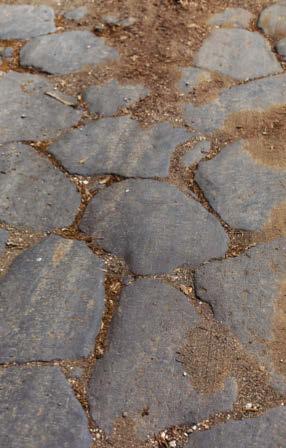
You can book a direct flight from London to Florence or Rome. A high-speed train connects the two Italian cities – the journey time is one and a half hours.

a gut-wrenching set of hairpin bends where overshooting a turn could be fatal.
Each day takes on a formulaic pattern of riding interspersed with stops for Italian delicacies – espresso, cured meats, gelato – but it’s far from predictable. Sheer natural beauty appears around unsuspecting corners as I follow the white squiggle up and over undulating duvet folds southward to the horizon. Cypress tree-dotted peaks and troughs are replaced with meadows full of wildflowers as I cross into the region of Lazio and skirt Lake Bolsena, Europe’s largest volcanic lake. Trailside blooms of wisteria and irises provide purple flashes in my peripheral vision.
Hikers raise a hand as I whizz past, their snail-like pace on foot much harder on the body than the cushioning provided by high-volume tyres. But my mode of pilgrimage is not without personal suffering. By the final day, my palms burn from persistent vibrations, every pothole sends a shock of pain through my right foot, and an unfamiliar saddle has left its mark in the way that
The 3T Exploro RaceMax: an all-road touring essential

The carbon-fibre frame combines lightweight construction with rock-solid strength to handle anything you throw at it
The wide-ranging SRAM Rival 12-speed gearing is fast on the flat while leaving enough in reserve for super-steep climbs
Chunky 2.1in mountain bike tyres are paired with smaller 650b wheels, allowing you to tackle any terrain Hydraulic disc brakes ensure you stay in control from the first kilometre to the last
unfamiliar saddles do after more than 300km of rough terrain.
As I enter the outskirts of the Italian capital, the picture-postcard wilderness I’ve found myself in since leaving Florence’s 14th-century city walls takes on an industrial hue and the prehistoric path rubs shoulders with 21st-century
urban sprawl, flanked by factories instead of endless fields.
I join a raised cycle path that follows the River Tiber all the way to St Peter’s Square, the pan-flat parcours providing time for reflection. Finding myself back amid the blare of car horns, I have the sudden urge to turn around and retrace my steps, returning to the hinterlands where the only sound was the crunch of gravel beneath rubber.
Pilgrimage complete, I glance at Google Maps and zoom out to see just how far I’ve come under my own steam. The various blobs of green and twisting yellow lines don’t tell the full story, but the jaw-dropping scenery and, at times, gruelling terrain that lies beneath the rudimentary illustrations will certainly live long in my memory.
Charlie Allenby is a London-based running, cycling and adventure writer; Instagram: @charlie.allenby. Rolling Dreamers hosts fully supported and self-guided bike tours across Europe, with more Via Francigena tours this year and next; rollingdreamers.com


Where adrenaline and history are joined together, and 4000-year-old cities set the scene for the future of technology. Here, the combination of ancient and modern is harmoniously blended.
fnd us at goisrael.com
Trail or fell, road or indoor, these tech-loaded shoes were engineered to make light work of any run


 SALOMON Thundercross, developed in the French Alps, with deep 5mm lugs for exceptional grip, salomon.com; MERRELL Agility Peak 5, with 100-per-cent recycled laces, webbing, mesh lining and footbed cover and a 50-per-cent recycled EVA foam footbed, merrell.com
SALOMON Thundercross, developed in the French Alps, with deep 5mm lugs for exceptional grip, salomon.com; MERRELL Agility Peak 5, with 100-per-cent recycled laces, webbing, mesh lining and footbed cover and a 50-per-cent recycled EVA foam footbed, merrell.com
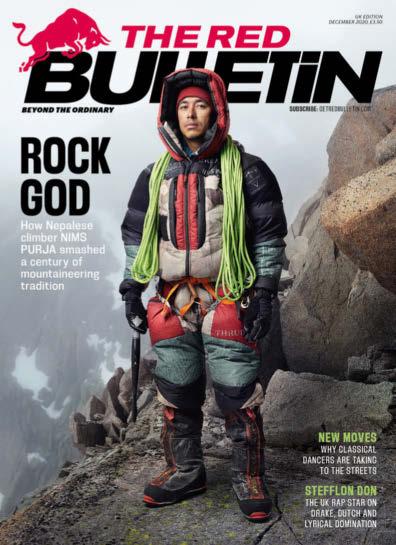

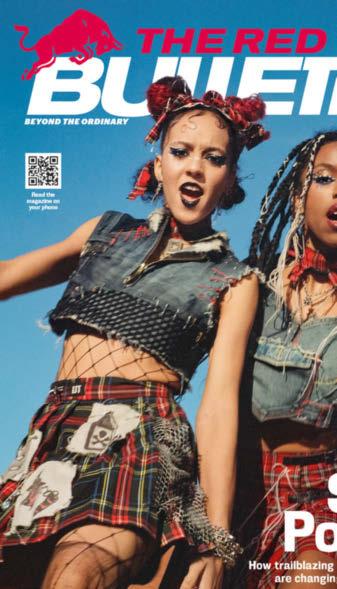

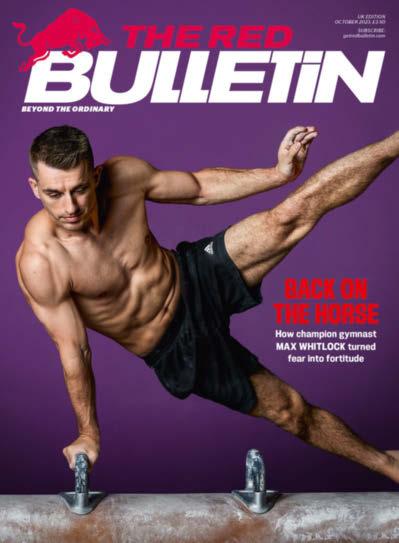


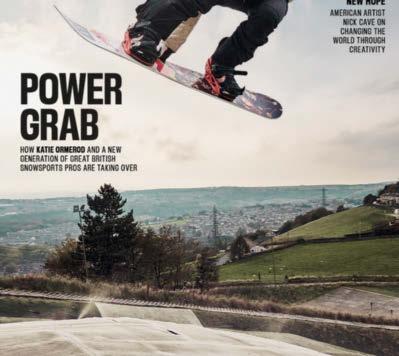

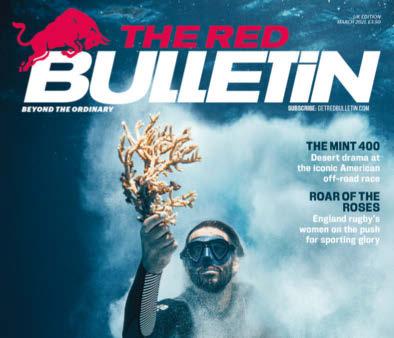
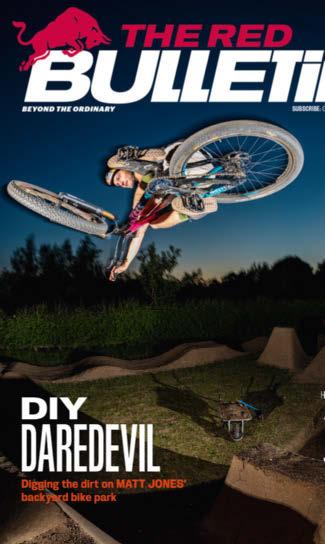
The next issue is out on Tuesday 14 November with London Evening Standard. Also available across the UK at airports, universities, and selected supermarkets and retail stores. Read more at theredbulletin.com
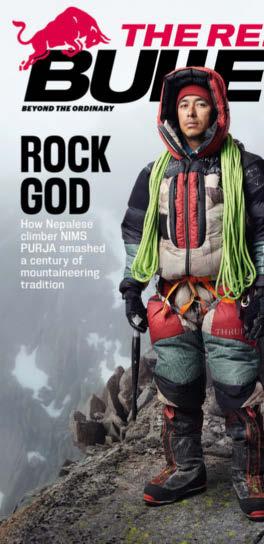
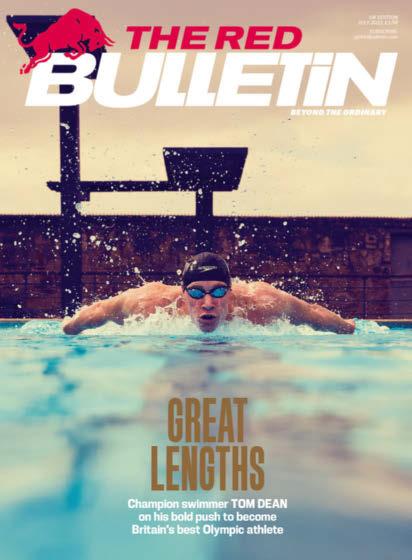
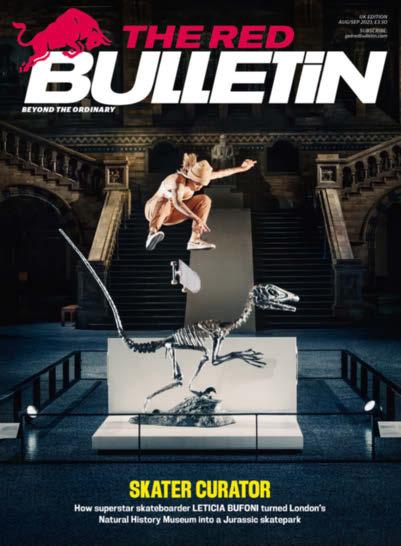
Hundredths of a second can make all the difference in the America’s Cup. So when Alinghi Red Bull Racing sought an official timepiece, it called for a watchmaker that ticked like the team
It’s the pinnacle of yacht racing, drawing the world’s greatest sailing teams. But beneath all the glitz, drama, action and emotion, the America’s Cup is actually something far simpler.
“It’s an innovation race,” says Adolfo Carrau, design coordinator at Alinghi Red Bull Racing, one of the teams entering next year’s 37th America’s Cup in Barcelona. “In a sense, the fastest boat always wins.”
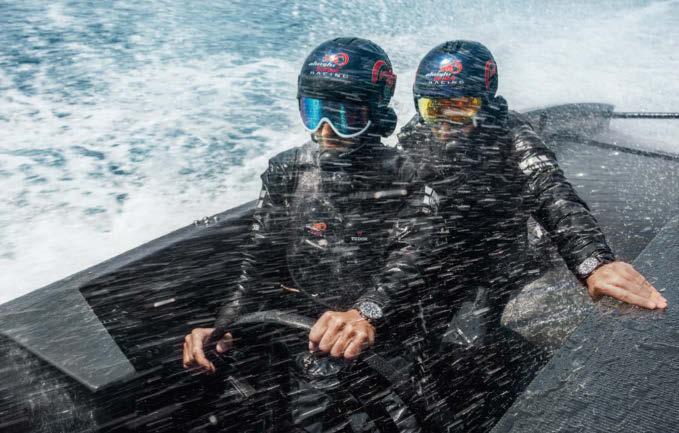
Every team races an AC75 foiling monohull – a 22.8m-long sailing boat that can, thanks to hydrofoils mounted beneath the hull, literally fly above the water. Some requirements are the same for all teams – the height of the mast, size of the sails, foils and blades – but beyond that, anything goes.
“We’re constantly pushing the envelope,” says Carrau. “We design and engineer 90 per cent of what goes on board.” Carbon-fibre and composite pieces are custom 3D-printed; stainless steel and titanium feature, too. “Apart from paint and some hardware, few things are commercially available.”
Any partner to the team needs to bring that same high standard to the table. So when it came to an official watch for Alinghi Red Bull Racing, there was only one name: Tudor. The Swiss watchmaker has a rich history in diving watches, and its Pelagos FXD – originally
made for specialist units of the French Navy – is a benchmark in this field.

With 200m water resistance, Pelagos FXD watches feature square hour markers and Tudor’s signature ‘Snowflake’ hands, with large luminescent surfaces for maximum legibility. The ‘FXD’ refers to the fixed strap bars built into the case lugs, meaning there’s zero chance of the watch strap becoming unexpectedly detached. This proved the perfect starting template for the Tudor Pelagos FXD ‘Alinghi Red Bull Racing Edition’.
Released in two designs, ‘Time-Only’ and ‘Chrono’, the latter is the first time Tudor has used a chronograph –a stopwatch in the main dial – for one of its fixed strap-bar watches. The bi-directional
bezel is titanium, the caseback stainless steel, and the case itself is built from a proprietary carbon composite made from carbon fibres and elements the watchmaker is “keeping secret”. These same three materials are used extensively in the AC75 itself.
“In this sport, victory comes by fusing daring human spirit with cutting-edge technology,” Tudor explains. “By combining a high-tech carbon composite with titanium and stainless steel, which is another first for Tudor, the watches celebrate a partnership born out of this philosophy.”
This symbiosis between team and timepiece runs deep. The 22mm-wide, single-piece fabric strap, woven from jacquard ribbon on 19thcentury French looms, comes in Alinghi Red Bull Racing ‘Team Blue’ with red accents.
“In a sense, the fastest boat always wins”
Adolfo Carrau, design coordinatorTHE BOAT
Those team colours are matched on the dial, which also features a subtle ‘Alinghi Red Bull Racing’ motif above the face between 10 and two.
Next year, as the minutes count down to the race start – that critical time when the boats jostle at low speeds, preparing to hurtle up to the 40 knots required to, literally, take off – you can be sure those final seconds will be ticking on Tudor Pelagos FXD ‘Alinghi Red Bull Racing Edition’ watches strapped to the wrists of some of the world’s greatest sailors. tudorwatch.com
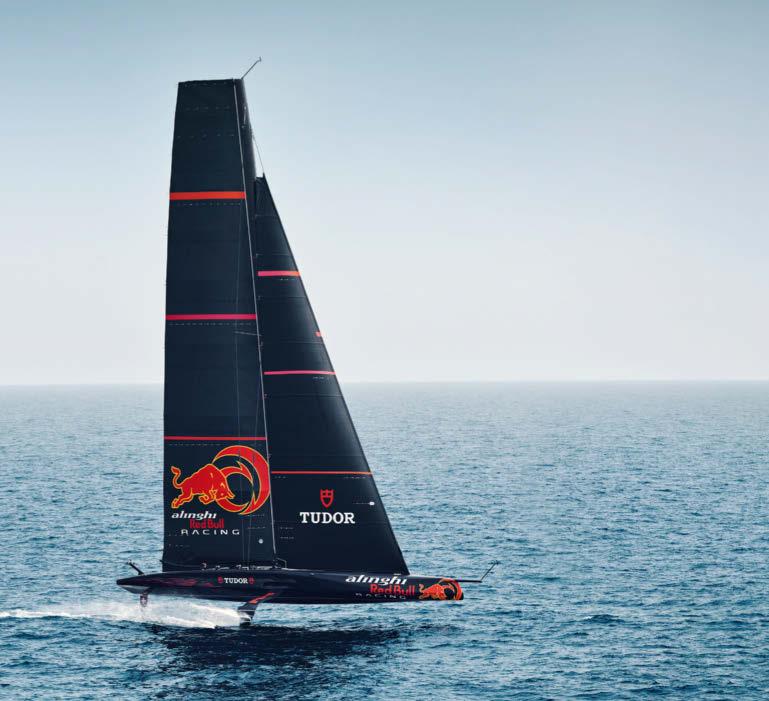
The mast and hull of the AC75 are made of carbon fibre. The watch case is made from a carbon composite material
This is what the back of the watch case is made from –the same as the hydrofoil blade and fixtures on the AC75 deck
The material used for the bezel of the watch as well as the hydrofoil wings of the boat
THE WATCH
Tudor’s Pelagos FXD ‘Alinghi Red Bull Racing Edition’ comes in a chronograph (pictured) and a ‘Time-Only’ design
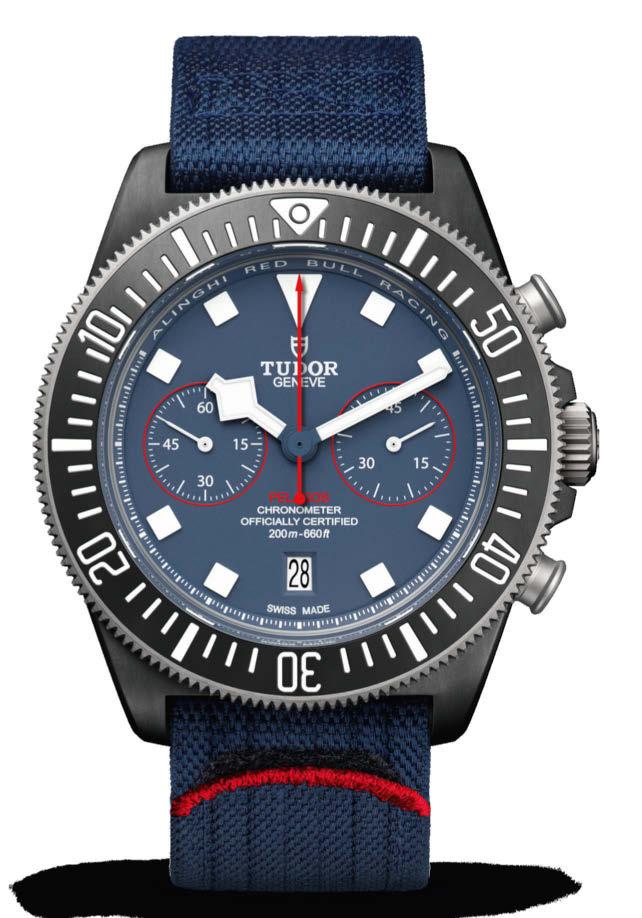
“The watch is a partnership of shared philosophy”
Tudor
The new kid on the racket-sports block is exploding in popularity. Here’s why you should take to the court…
What do you get if you cross squash and tennis? The answer is padel – pronounced ‘paddle’ – a rapidly growing racket sport that could be a sociable substitute for a solo gym session in terms of physical gain.
The concept of the sport, invented in Mexico in the late 1960s, is simple. Padel is predominately played two versus two and its gameplay and scoring system are similar to tennis, with matches settled by the best of three sets. What differs from its more established sibling, however, is that the ball – just slightly smaller than the one used in tennis – is allowed to hit the glass or mesh walls enclosing the court (as in squash) and players use stringless, Swingball-style rackets.
For years, this Central American invention largely remained the preserve of the Spanish-speaking world, but its explosion in popularity in Spain over the past decade
– there are now more than 14,000 courts in the country and it’s the second mostplayed sport behind football – has seen the 20m x 10m cages spring up across Europe. Today, there are around 250 in the UK.
“It’s a challenging, fun and competitive game,” says Sandy Farquharson, founder of London’s The Padel School. The 39-year-old discovered the sport 14 years ago while coaching tennis in Dubai and enjoyed his first match so much he switched overnight; he hasn’t looked back.
But padel is more than just a niche spin-off sport for those already gripped by the OG racket sports. In fact, Farquharson says, in terms of physical and mental benefits it can even rival more mainstream forms of exercise.
One of padel’s biggest selling points is its accessibility. “I can take you and three friends
who’ve never played before and within 15 minutes you’ll be playing a game and loving it,” says Farquharson. This is because, technically speaking, padel is relatively easy to play. Thanks to the enclosed nature of the court, you’re not forever having to bend down and pick up the ball, and each point starts with an underarm serve rather than a fiendishly difficult overarm one. “People start playing padel and they think they’re a natural because they’re rallying straight away.”
A match of padel is a lot like a high-intensity interval workout: points are fast and furious affairs where “rallies can comprise 60 to 70 shots” and players move in short, sharp sprints. Despite this, a scientific review in 2022 found that a padel player’s heart rate is unlikely to pound like a runaway train during a game, but instead remain at a bpm rate similar to that of a gentle jog. And despite the compact size of the court, longer rallies mean “you’ll travel further in terms of distance and step count [than tennis]” too; a study in 2021 reported that players average between 2.5 and 3.5km per match.
While research suggests that pro-level padel players have rock-solid lower back strength, the sport engages a whole host of muscles, providing a workout that could rival a session in the weights room. “The combination of twisting and turning and hitting the ball lower to the ground means that you require mobility in your hips as well as using your glutes,” says Farquharson. Its benefits aren’t limited to your body’s bottom half, either. “There’s also a wide variety of overhead shots in padel, meaning you’ll hit more smashes, resulting in more shoulder strength.”
The sport impacts your grey matter, too. “Every aspect of padel boosts coordination as well as cognitive ability, because you’re having to read patterns of play and anticipate shots,” Farquharson explains. “You get benefits from the multidirectional changes the court provides. You’re doing a lot of backward movements, or having to turn around in a corner, so your brain is working hard to calculate the angles of every rebound.”
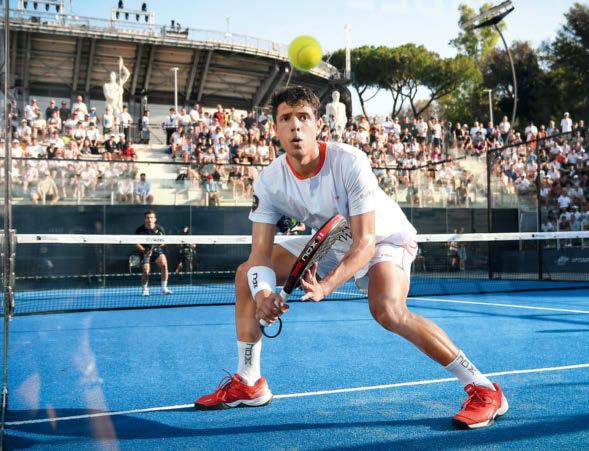
For more information, go to: thepadelschool.com

“Within 15 minutes you’ll be playing a game and loving it”
Sandy Farquharson, padel coach
Go with the flow: pulling on the SBX’s T-shaped handle activates its batterypowered pump
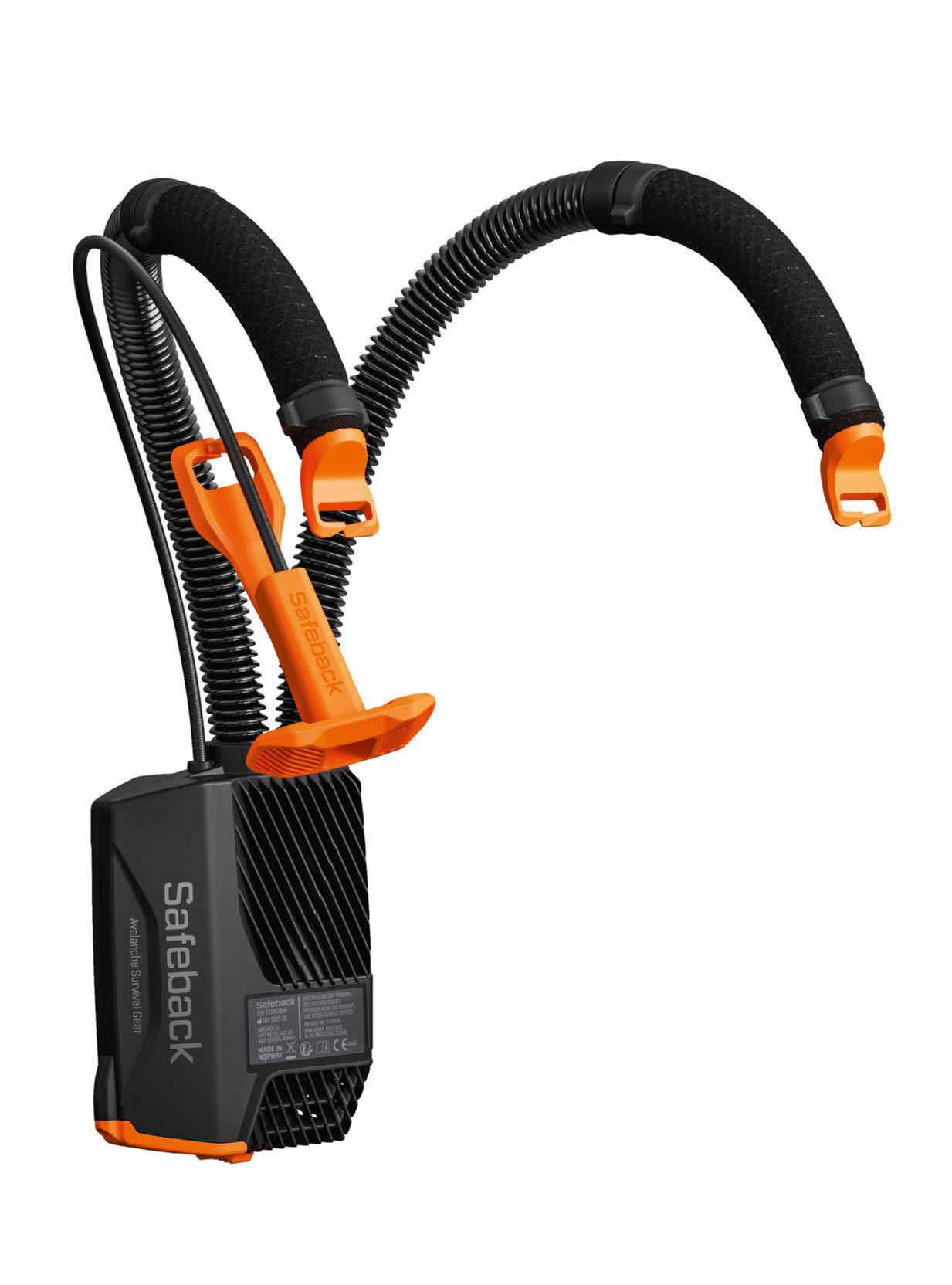
Some avalanche safety gear is useless when you’re buried beneath tonnes of snow. But this device could save your life
Fifteen minutes. The time that some spend scrolling through their phone before sleep is also the survival window of a person buried by an avalanche. If dug out within that time, they have a 93-per-cent chance of survival. Beyond this, rates plummet – by 45 minutes, it’s just 20 to 30 per cent.
The major cause of death isn’t hypothermia but asphyxiation – as the victim breathes, CO2 builds up in their air pocket; they’re
literally poisoning themselves with every exhalation.
Norwegian firm Safeback has an innovative solution. Its battery-powered, backpackmounted SBX avalanche airflow system pumps oxygen from the surrounding snow to the breathing area of its wearer, extending the survival window to 90 minutes. Ideal when you’re off-piste, where avalanches are more common and help is further away. safeback.no
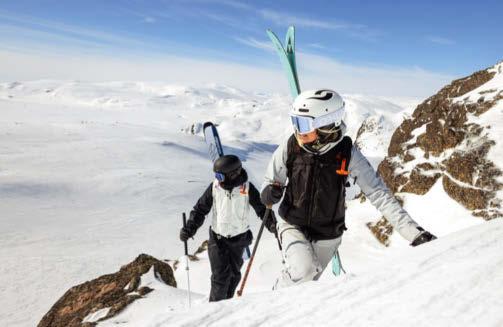
In mid-April, Tim Shaddock set sail from the Mexican port of La Paz aboard his 9m catamaran with his dog Bella. His destination: Nuku Hiva, an island in French Polynesia, almost 5,000km away across the Pacific Ocean.
The 54-year-old Australian had sailed since he was a kid, but this was the biggest journey of his life. The previous summer he’d crossed the Sea of Cortez over three days in preparation, and he anticipated his first solo offshore expedition would take roughly six weeks.
But a few weeks in, a storm hit, severely damaging his sails and equipment. Shaddock’s once-in-a-lifetime adventure had become a story of survival. Although adamant he was never lost – “I had GPS coordinates and was sending Garmin inReach messages [to my sister] and receiving small weather updates” – things looked dire as he floated adrift on the world’s biggest ocean.
Three long months after Shaddock set sail, a helicopter surveilling for a tuna trawler 2,000km from the nearest coastline flew overhead. Its pilot notified the ship, which sent out a rescue party for the sunburnt, dehydrated sailor and his dog. Salvation arrived just in time, with Hurricane Calvin looming. “I was probably a lot more optimistic about my situation [than I should have been],” he says. “Sometimes ignorance is bliss. [The ’copter] showed up just as I realised that I probably wouldn’t be able to fix my boat sufficiently to outrun the hurricane.”
Here, he shares some of the tricks that kept him alive…
When it comes to calorie intake, says Shaddock, be prepared to improvise. Armed with a speargun and a fishing line, he hooked small tuna and even a shark, but there were also fish he’d never seen before. “There are ways to figure out if they’re poisonous or not,” he says, adding that spikes, spots and
Tim Shaddock knows a thing or two about survival –when his boat was hit by a storm during a solo Pacific crossing, the Australian was left adrift for three months
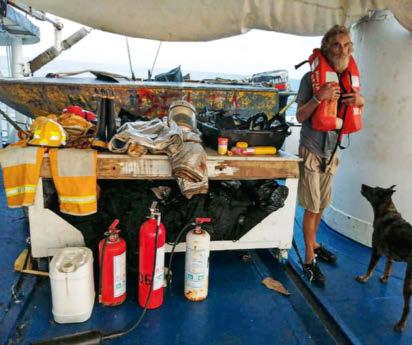

bright colours are best avoided: “A pufferfish, for instance, has a distinctive colouring and markings.” After losing his cooking equipment, he and Bella ate the fish raw. When his speargun broke, he was forced to grab any form of protein he could. “These sea
ducks were landing right next to me. I was always shooing them because they’d poo on my solar panel, but when my speargun broke I just grabbed one by the neck and found myself killing it to eat. There’s not a lot of meat on them, but they source some of the best fish, so they’re very nutritious.”
Fresh water is the difference between life and death at sea. Shaddock had an emergency manual watermaker to remove
salt and other contaminants from seawater, but his onboard water supplies were running low. “You don’t want to rely on [the watermaker] – you have to pump slowly for 20 minutes to make one cup of water.” He knew every drop of rain water would be precious. “There was none until I got to the equatorial regions, but thankfully there was quite a lot after that. I had a gaff rig sail and positioned it to catch the rainwater. I was sometimes collecting 20 litres from the sail and the buckets [on deck] in one dump.”
With food scarce, Shaddock says, fight the urge to work too quickly and exhaust yourself. The rigging urgently needed mending before the hurricane struck, but Shaddock took things slowly. “I had to climb the mast a few times to sort the problem if I was going to get the boat fully operational, but I realised I was losing a lot of weight, just not recovering as well.” Repairs that would usually take a morning were spread across days. “I paced myself, seeing how well I could climb the mast. My recovery the next day was important. I needed to keep something in reserve, just in case.”
The mental toll of being adrift can be as severe as any physical issue. Just a needle in an ocean-sized haystack, Shaddock knew his chances of survival were slim. “You have to constantly be vigilant about what the mind can do,” he says. An experienced freediver, he found that one-two breathing – the technique where you exhale for twice as long as you inhale, used to lower the heart rate before a dive – helped to quieten his mind at sea. “Do a bit of breathing before you go to sleep at night, when you wake up in the morning, and also when things get a bit hectic, you’re fatigued or you’re feeling stressed,” Shaddock says. “It’s very effective.”
“I was probably too optimistic about my situation”
Tim Shaddock, ocean survivor

The Legend of Zelda: Tears of the Kingdom (pictured) was released for the Nintendo Switch in May this year, it received critical acclaim. One new feature in particular proved a sensation with fans of the four-decadespanning Zelda series: the ‘Ascend’ power, which allows players to float upwards, even through ceilings, to easily explore new areas. But what’s most surprising is that this feature was never intended to be in the game at all.
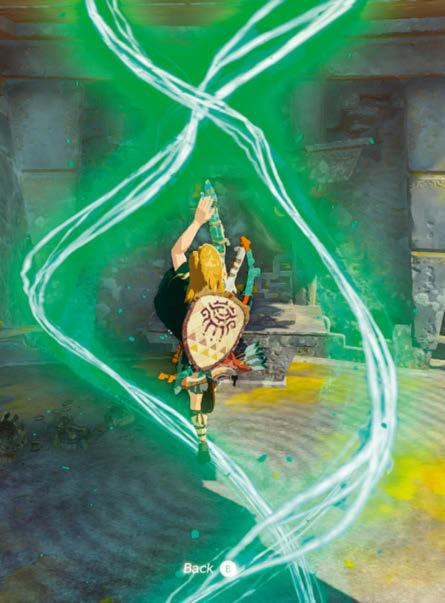
During its five years of production, the developers of Tears of the Kingdom built in a debug mode – a cheat that allowed coders to zip around the huge world while testing it. They loved it so much, they wanted players to enjoy it, too. “It’s become my favourite ability in the game,” says Jack Yarwood, staff writer for retro and classic video-games website Time Extension. “The fact it doesn’t feel like a cheat, and that it works flawlessly, is impressive.”

The history of gaming is peppered with evolutionary leaps like this – exploits that players have discovered, unintentional quirks in the code, even total screw-ups. Here, Yarwood revisits some accidental upgrades so essential to gaming that it’s hard to imagine they weren’t intentional…
Combos – rapid strings of attacks that an opponent can’t recover from – are a core feature of modern fighting games, and yet their origin was a design accident. When Street Fighter II was released in 1991, savvy players discovered that the animation frames of certain moves loaded faster when they followed certain other frames, so they quickly exploited this. “Combos have become a defining feature of not just Street Fighter but
Your favourite video-game features might just be mistakes
fighting games in general,” says Yarwood. “It’s now a gimmick for a game not to feature them. For example, there’s the game One Strike where you hit a character once and they die. It has a sequel: Two Strikes.”
Fire a rocket launcher at the floor in real life and it’ll be the last thing you do. But in first-person shooting games it’ll propel you to higher ground. A staple of deathmatch pros and ‘speedrunners’ who race to complete levels in record time, this technique first found fame in 1996’s Quake, being a byproduct of the game’s realistic physics
delivering kickback from an explosion. “Tim Willits [one of the game’s designers] claims it’s by chance that someone found it,” says Yarwood, “But Doom [a 1993 precursor to Quake] featured a moment where you had to shoot a wall
to get knocked back into a secret exit. Whether it’s a forgotten feature or was discovered organically is hotly contested. But today you can’t imagine Quake without rocket jumping.”
The Need for Speed racing series famously features wild police pursuits, but we’d never have them if it weren’t for a programming error. “During the making of Need for Speed II [1997], a producer encountered a situation where the enemy cars began attacking his Lamborghini,” says Yarwood. “He reported the bug, and it turned out the AI engineer had set the wrong parameters for car aggression.” The team liked it so much, they included it as an unlockable cheat and it became the focus in the following year’s Need for Speed III: Hot Pursuit. “Being hunted down by the police with super-aggressive AI is something you now expect from Need for Speed, and it came out of everything going wrong and someone saying, ‘This is fun!’”
Space Invaders, the grandaddy of video games, released in 1978, features waves of aliens accelerating down the screen as you pick them off, until the final enemy zigzags at lightning pace towards your gun turret. This increase in speed and difficulty would become standard in high-score video games, and yet it was just a result of the era’s limited computer technology. “As there were fewer things on the screen, the processor was able to render the alien sprites faster,” says Yarwood. “But this change is what makes it so playable even today. A lot of retro games don’t hold up, but Space Invaders is still a classic.”
The Legend of Zelda: Tears of the Kingdom is out now on Nintendo Switch; nintendo.com
“It’s now a gimmick for a game not to have combos”
Jack Yarwood, games writer
Want to be blown away by the gaming experience?
Meet the OWO…
Whether it’s driving a souped-up supercar at speeds of 300kph, being locked in lightsaber combat with a stormtrooper, or building huge structures using 3D blocks, video games have always sold themselves on being immersive experiences.
But with the senses engaged limited to sight and sound, absorption in a game has always required
The Assassin’s Creed Mirage edition enables you to experience every jump and vault as you parkour through the city a degree of buy-in from the player. Even with the advent of VR headsets and vibration-based haptic feedback on controllers, gamers haven’t been able to fully embody their avatar.
The OWO haptic gaming vest aims to solve this. Fitted with 20 electrode pads, this T-shirt-styled wireless wearable sends signals direct to your muscles, stimulating

contractions of varying intensity to simulate 30 different sensations, from a gentle breeze to a gunshot with exit wound.
It’s possible to tweak each feeling and even turn off those that you find too uncomfortable, allowing you to immerse yourself in the game without a side of slugs. But as the saying goes, no pain, no gain… owogame.com
From warm-up and recovery to muscle-boosting abilities, the
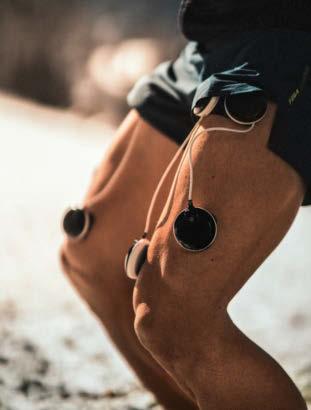
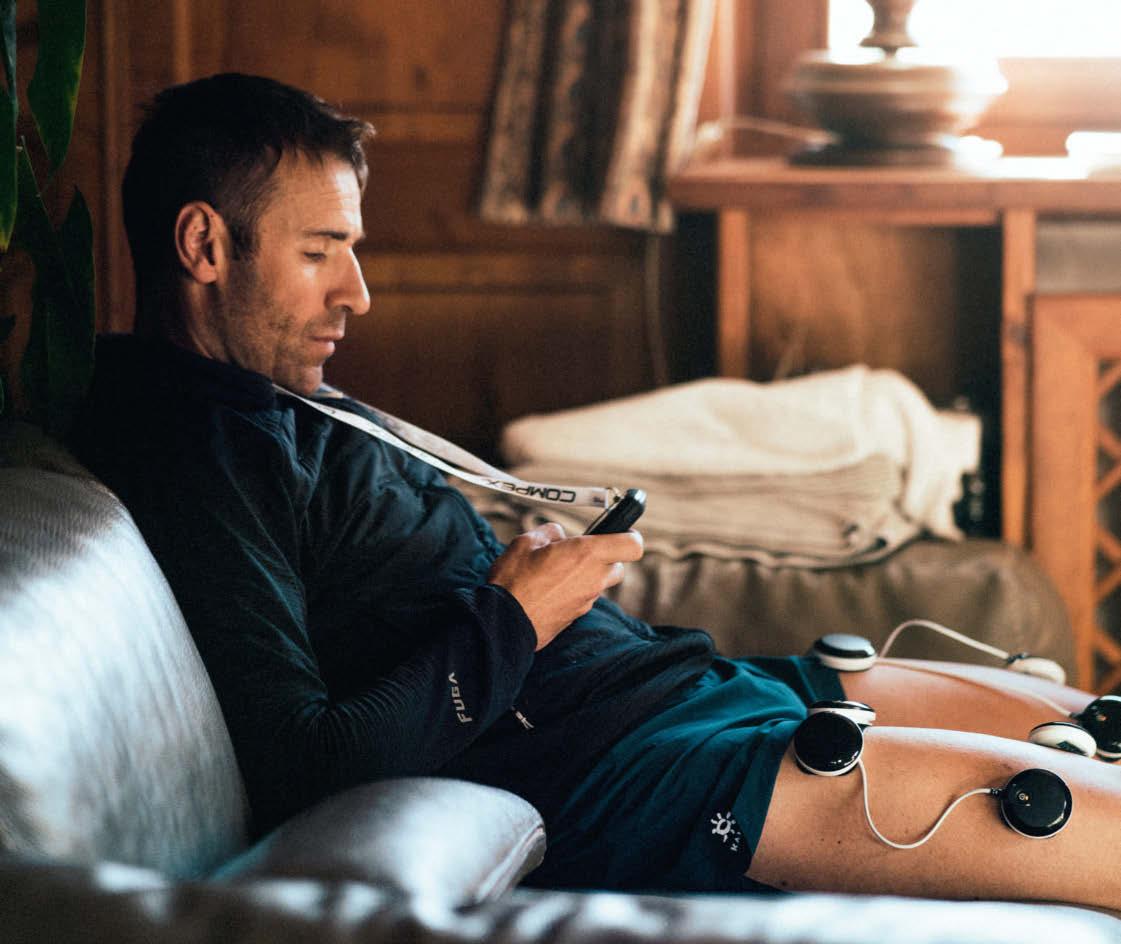 Compex SP 8.0 is a game-changer for all trail runners
Compex SP 8.0 is a game-changer for all trail runners
Trail running is rightly regarded as one of the most enjoyable ways to stay fit and healthy. Less impactful on your body than traditional road running, more about being in the moment than constantly checking your pace, and great for your mind and wellness thanks to its nature-rich routes, it’s easy to see why it’s growing in popularity among both experienced runners and those who are lacing up for the first time.
But trail running is not without its risks. While its off-road terrain is easier on your joints, there’s often added technical difficulty in the form of tree roots, rocks and ridges, which requires muscles to be fully warmed up before attempting a run. It also engages your muscles in different ways to standard road running, adding a stabilising workout to proceedings and increasing the likelihood of the dreaded delayed onset muscle soreness (DOMS).
Fortunately, there’s a solution to help minimise these issues, whatever your trail-running abilities – the Compex SP 8.0. An all-in-one tool that can help during every stage of your training, it enables you to optimise your strength and endurance and helps you recover faster, while treating pain and reducing the chance of injury.
The gadget works by using electrotherapy-based muscle stimulation – a scientifically backed medical treatment method common

in rehabilitation, pain treatment and cross-training. The idea is simple. Small electrodes are placed onto specific muscles and emit lowlevel electronic impulses, sending signals to the motor nerve that cause it to contract. As your muscle isn’t able to distinguish between a contraction triggered by your brain and one triggered by muscle stimulation, this means you can truly target specific muscles with specific frequencies, getting specific results in the process.
Ahead of your run, the Compex SP 8.0 allows you to warm up the required muscle groups, bringing extra blood flow and oxygenation to the likes of your quads, calves and glutes before they’re put through their paces, and making your form more efficient from your first stride.
On your return, the same tool has a range of recovery and massage programmes to reduce DOMS through increased blood flow, guaranteeing tomorrow’s training session is a goer. Plus, with Compex’s new MI-Autorange technology – which automatically determines the optimal level of stimulation – you can get impulses tailored to your specific needs without even having to think about it.
But the Compex SP 8.0 is about much more than warming up and cooling down. The four included modules are able to transform crosstraining, boosting every strength session, increasing muscle density and even improving your VO2 Max –your aerobic limit before efforts tip into the thigh-burning, lactic-aciddominant anaerobic energy system.
Its adaptability means you can get specific with your strength gains, too. Its ankle-twist prevention programme, for example, increases the effectiveness when training the peroneal muscles – three lateral muscles in your calf that are essential for the stability of the foot – helping to protect them when straining across varied terrains.
Portable, connectable and complete with a stiff protective box for taking with you wherever you train or race, the Compex SP 8.0 is the smartest way to boost your trail-running performance.


What is Eric Cantona’s greatest achievement? Being one of France’s and Manchester United’s greatestever footballers is surely up there. His infamous ‘kung-fu kick’ at a spectator in 1995, which earned him an eightmonth ban and lost him the French national team captaincy, less so. Maybe it’s his acting, which saw him cast alongside Cate Blanchett in the BAFTA-winning 1998 film Elizabeth, or his penchant for appearing in ads for the likes of Nike and Renault. Now, the 57-year-old can add singing to his CV as he goes on tour. “Next year, I’ll be playing with a band,” he says, “but I’m starting with a modest piano playing alongside me.” Manchester, London and Dublin; cantonasingseric.club
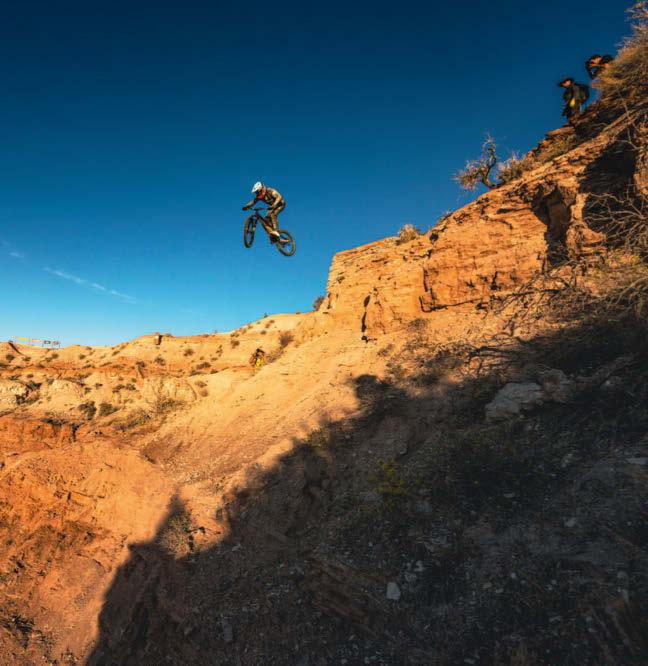
Many mountain biking events claim to be the world’s toughest, but this freeride contest would likely win the vote. Returning to the unforgiving Martian landscape near Virgin, Utah, USA, for its 22nd year, it’s a strictly invite-only competition, contested by none but the most fearless riders. The rules are simple: get to the bottom of the dry sandstone mountain in the most spectacular way possible (competitors spend four days in advance carving out a route by hand). The one to beat this year is Canadian Brett Rheeder, winner in 2018 and 2022. Catch the action on Red Bull TV. redbull.com
Didn’t make it to Munich’s famous beer festival this year? Hang onto your lederhosen – there are still opportunities to wear them closer to home. Wunderbar at London’s Pergola Paddington is keeping the Bavarian spirit alive until November 3, with a ‘Day of the Dachshund’ on October 22 offering bottomless bones for all sausage-dog owners. Also, on October 14 and 21, Between the Bridges on the capital’s Southbank is hosting Pink Octoberfest – an LGBTQI+ celebration mixing elite drag acts and oompah bands. Dress code: pink lederhosen. London; pergolapaddington.com; betweenthebridges.co.uk

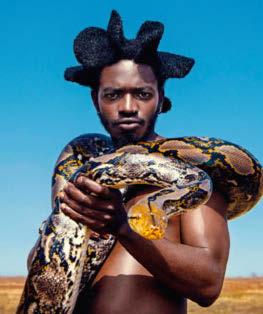

When Sam Smith attended this year’s BRIT Awards in an inflatable latex bodysuit, his attire split the internet, sparking debates on body image and gender identity. This was what the singer – the focus of much negativity on such topics – and the outfit’s designer, Harri, wanted. See the suit (which Harri made in just four days) up-close at this exhibition of fashion’s great non-conformists, alongside Björk’s 2001 Oscars ‘swan dress’, the Steven Stokey-Daly garments from Harry Styles’ Golden video, and more. Design Museum, London; designmuseum.org
Last year saw the debut of this revolutionary climbing competition, which pits pairs of elite climbers head-to head on multi-pitch (ie, longer than one rope-length) artificial routes. This year, it returns to the same location – Switzerland’s breathtaking, 220mhigh Verzasca Dam (most famous as the dam Pierce Brosnan’s James Bond bungeejumps off in the opening scene of 1995 film GoldenEye) – and sees 24 climbing legends take part, including 2022’s winning duo, Spain’s Alberto Ginés López and Slovenia’s Luka Potocar. There are limited spaces along the dam for spectators, but, for the rest of us, Red Bull TV will be streaming all the action live. redbull.com

Part of Leeds’ Year of Culture, this citywide festival gathers more than 100 international artists. In Icelandic choreographer Ásrún Magnúsdóttir’s Secrets, dancers enact the unspoken concerns of the youth of Leeds and Reykjavík; queer South African rapper Desire Marea (pictured) delivers a multisensory opera; and Darkmatter is a time-dilating hip-hop journey into black holes. Across Leeds; transformfestival.org
A train rolls past a frozen alpine lake, and the 3,000m mountains that flank it are reflected back on its surface. A snowboarder strolls through a bustling city, past a 15th-century palace, on their way to a cable car. A family wake up in a tranquil ski town, open their door, and clip in for another day on the slopes. A group of touring skiers pack away their skins and look out at the jagged peaks, which pierce the skyline as far as the eye can see, just as the sunrise hits their hard-earned downhill. Mouthwatering Käsespätzle – the Alps’ indulgent answer to mac and cheese – and fluffy Kaiserschmarrn pancakes await in cosy mountain huts that embody Austrian gemütlichkeit – the cosiness, camaraderie and joy that’s alive in abundance in the mountains. This is winter… the Austrian way.
Innsbruck is Austria’s mountain city, where history and art meet rivers and mountains. Grab breakfast in a coffeehouse, then stroll through the old town to the central cable car, which will whisk you up to 2,000m in 20 minutes. Once the lifts shut, explore the Christmas markets, or the 300 light sculptures in the Imperial Gardens. The Ski plus CITY Pass includes 13 ski resorts, from the Nordkette to Stubai Glacier. An après Aperol in Marktplatz is always a good idea.
Lifts: 111
Pistes: 340km
Nearest airports: Innsbruck (5km); Memmingen (180km); Munich (190km)
Elevation: 820-3,212m
Highest mountain:
Hafelekar Summit, 2,334m
The Arlberg is home to five idyllic villages –St Anton, St Christoph, Stuben, Zürs and Lech – sitting pretty between Tirol and Vorarlberg. This is the cradle of alpine skiing, where the sport was pioneered. Today, it’s a freeriding haven and the largest contiguous ski area in

Austria, with state-ofthe-art lifts to boot. Quality comes first here, from the hotels to the mountain huts. If you’re dreaming of a stunning ski tour with a spot of fine dining afterwards, the Arlberg is the place to be.

Lifts: 87
Pistes: more than 300km
Nearest airports: Innsbruck (120km), Memmingen (180km), Zürich (200km)
Elevation: 1,300-2,811m
Highest mountain: Valluga, 2,811m
Winter wonderland: freeriders at the Nordkette, the Jewel of the Alps, just north of InnsbruckSkiing in Ischgl means entertainment on and off the snow. The resort is snow-sure from late November to early May. Ischgl connects to Samnaun in Switzerland, which means a huge 239km of pistes to explore across the two countries. The area is renowned for its après and Top of the Mountain concerts, which have welcomed Sir Elton John, Kylie Minogue, Tina Turner and many more in the past, but it’s also the perfect place to bed down and relax. Ischgl has a very high density of four- and fivestar hotels and Toqueawarded restaurants, and after a hard day on the slopes there’s nowhere better to relax than in the panoramic pool or saunas of the Silvretta Therme spa.
Lifts: 45
Pistes: 239km

Nearest airports: Innsbruck (100km), Munich (229km), Zürich (235km)
Elevation: 1,377-2,872m
Highest mountain: Greitspitze, 2,872m
Hidden in silent beauty beneath an array of snow-covered 3,000m mountain peaks is the stylish ski-in, ski-out town of Obergurgl-Hochgurgl. There are 112km of slopes here, many of which are wide, open and ideal for those still perfecting their turns. There’s also a lot more piste to discover on the Ötztal Super Skipass, which boasts 363km of pistes between six resorts including Gurgl as well as Sölden, Hochoetz-Kühtai and Vent. The winter season kicks off on November 18 with the men’s slalom – part of the FIS Alpine Ski World Cup. Away from all the on-piste action, visit the Top Mountain Star, a panoramic 360° restaurant offering views out over the Alps and Dolomites from 3,080m.
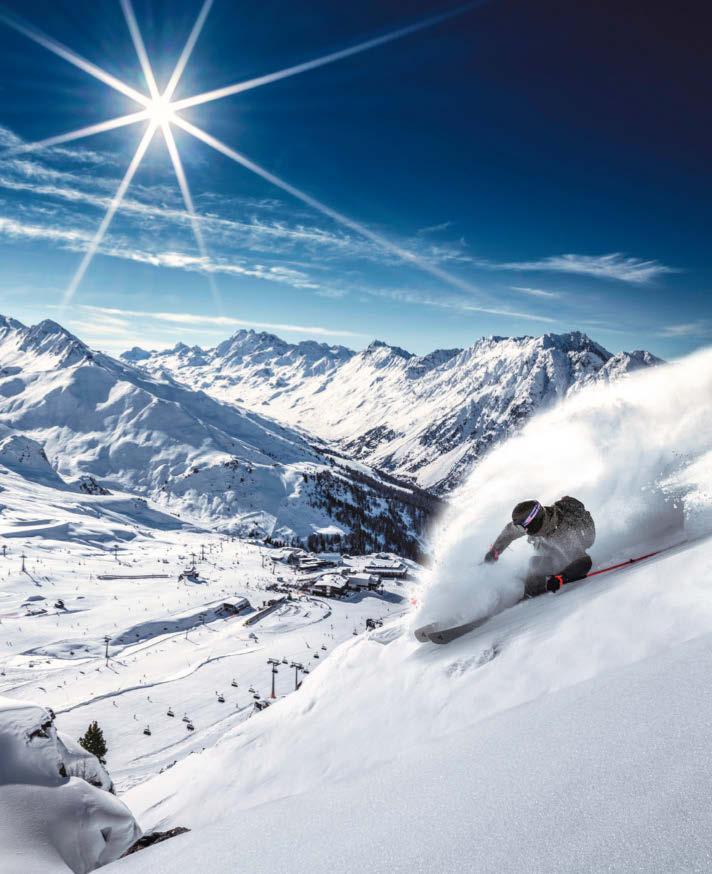

Lifts: 25
Pistes: 112km

Nearest airports: Innsbruck (83km), Bolzano (206km), Munich (231km)
Elevation: 1,800-3,080m
Highest mountain: Wurmkogel, 3,082m
For more information, go to: austria.info/en/winter
Editor Andreas Kornhofer
Editor-in-Chief
Andreas Rottenschlager
Editor-in-Chief DACH
David Mayer
Creative Directors
Erik Turek (manager), Kasimir Reimann
Copy Chief David Pesendorfer
Art Directors
Marion Bernert-Thomann, Miles English, Tara Thompson
Designers
Martina de Carvalho - Hutter, Kevin Faustmann-Goll, Carita Najewitz
Photo Editors
Eva Kerschbaum (manager), Marion Batty (deputy), Susie Forman, Tahira Mirza, Rudi Übelhör
Global Content
Tom Guise (manager), Lou Boyd
The Red Bulletin is published in six countries. This is the cover of our US edition for November, featuring 21-year-old Caroline Marks, who recently became the 2023 World Surf League champion.
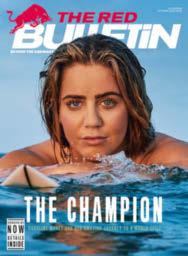
For more stories beyond the ordinary, go to: redbulletin.com
Head of Audio
Florian Obkircher
Managing Editors
Ulrich Corazza, Marion Lukas -Wildmann
Publishing Management

Sara Car-Varming (manager), Ivona Glibusic, Melissa Stutz (Innovator)
Head of Media Sales & Partnerships
Lukas Scharmbacher
Executive Creative Director
Markus Kietreiber
Senior Manager Creative
Elisabeth Kopanz
Art Direction Commercial
Peter Knehtl (manager), Lisa Jeschko, Araksya Manukjan, Julia Schinzel, Florian Solly
Head of Publishing Operations
Sigurd Abele
Direct to Consumer Business
Peter Schiffer (manager), Marija Althajm, Victoria Schwärzler, Yoldaş Yarar
Retail & Special Projects Manager
Klaus Pleninger
Advertising
Manuela Brandstätter, Monika Spitaler
Production
Veronika Felder (manager), Martin Brandhofer, Walter O. Sádaba, Sabine Wessig
Repro
Clemens Ragotzky (manager), Claudia Heis, Nenad Isailović, Sandra Maiko Krutz, Josef Mühlbacher
Finance
Mariia Gerutska
Assistant to General Management
Sandra Stolzer
CEO Red Bull Media House Publishing
Stefan Ebner
Editorial office
Am Grünen Prater 3, A-1020 Vienna
Phone +43 1 90221 - 0 Web redbulletin.com
Published by Red Bull Media House GmbH, Oberst-Lepperdinger-Straße 11–15, A-5071 Wals bei Salzburg, FN 297115i, Landesgericht Salzburg, ATU63611700
Executive Directors
Dietmar Otti, Christopher Reindl, Marcus Weber
THE RED BULLETIN United Kingdom, ISSN 2308-5894
Editor Ruth McLeod
Chief Sub-Editor Davydd Chong
Country Project Management
Ollie Stretton
Advertising Sales
Mark Bishop, mark.bishop@redbull.com
Printed by Quad/Graphics Europe Sp. z o.o., Pułtuska 120, 07-200 Wyszków, Poland
UK Office
Seven Dials Warehouse, 42-56 Earlham Street, London WC2H 9LA Tel: +44 (0) 20 3117 2000
Subscribe getredbulletin.com
Enquiries or orders to: subs@uk.redbulletin.com. Back issues available to purchase at: getredbulletin.com
Basic subscription rate is £20.00 per year. International rates are available. The Red Bulletin is published 10 times a year. Please allow a maximum of four weeks for delivery of the first issue
Customer Service +44 (0)1227 277248, subs@uk.redbulletin.com
THE RED BULLETIN Germany, ISSN 2079-4258
Editor
David Mayer
Proofreaders
Hans Fleißner (manager), Petra Hannert, Monika Hasleder, Billy Kirnbauer-Walek
Country Project Management
Natascha Djodat
Media Sales & Partnerships
Thomas Hutterer (manager), Michael Baidinger, Franz Fellner, Ines Gruber, Moritz Philipp Haaf, Wolfgang Kröll, Gabriele MatijevicBeisteiner, Yvonne Mensik, Alfred Minassian, Nicole Okasek-Lang, Britta Pucher, Nicole Umsait, Johannes Wahrmann-Schär, Ellen Wittmann-Sochor, Ute Wolker, Christian Wörndle, Sabine Zölß
THE RED BULLETIN Switzerland, ISSN 2308-5886
Editor
Anna Mayumi Kerber
Proofreaders
Hans Fleißner (manager), Petra Hannert, Monika Hasleder, Billy Kirnbauer-Walek
Country Project Management
Meike Koch
Media Sales & Brand Partnerships
Christian Bürgi (team leader), christian.buergi@redbull.com
Marcel Bannwart, marcel.bannwart@redbull.com
THE RED BULLETIN
Austria, ISSN 1995-8838
Editors
Nina Kaltenböck (manager), Lisa Hechenberger
Proofreaders
Hans Fleißner (manager), Petra Hannert, Monika Hasleder, Billy Kirnbauer-Walek
Country Project Management
Julian Vater
Media Sales & Partnerships
Thomas Hutterer (manager), Michael Baidinger, Franz Fellner, Ines Gruber, Moritz Philipp Haaf, Wolfgang Kröll, Gabriele MatijevicBeisteiner, Yvonne Mensik, Alfred Minassian, Nicole Okasek-Lang, Britta Pucher, Nicole Umsait, Johannes Wahrmann-Schär, Ellen Wittmann-Sochor, Ute Wolker, Christian Wörndle, Sabine Zölß
Michael Wipraechtiger, michael.wipraechtiger@redbull.com
Goldbach Publishing
Marco Nicoli, marco.nicoli@goldbach.com
THE RED BULLETIN USA, ISSN 2308-586X
Editors
Peter Flax (manager), Melissa Gordon, Nora O’Donnell
Copy Chief
David Caplan
Country Project Management
Branden Peters
Advertising Sales
Marissa Bobkowski, marissa.bobkowski@redbull.com
Tanya Foster, tanya.foster@redbull.com
Todd Peters, todd.peters@redbull.com
THE RED BULLETIN
France, ISSN 2225-4722
Editors
Pierre-Henri Camy (manager), Marie-Maxime Dricot, Christine Vitel
Country Project Management
Marin Heitzler
Media Sales & Partnerships
Yoann Aubry, yoann.aubry@redbull.com
Dave Szych, dave.szych@redbull.com
Back in 1839, if you wanted to get anywhere, you had two options: by foot or by horse. Not content with this pedestrian pace, Kirkpatrick Macmillan came up with a solution. The Dumfries and Galloway-based blacksmith had seen the rise of the velocipede – imagine an adult-sized balance bike – and knew there was a better, faster alternative. Using parts of his blacksmith machinery, he created the world’s first pedal bike. Like any cyclist on new bike day, the inventor also took it out for a spin, saddling up for a 100km trip from Thornhill to Glasgow and simultaneously completing the first pedal-powered bike ride.
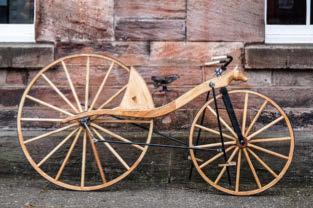

To mark this often-overlooked contribution, and cycling’s return to its roots at the 2023 UCI World Championships in Glasgow and venues across the country, Scottish clothing and accessories brand Endura set about authentically rebuilding Macmillan’s creation, complete with wooden frame and wheels. Modern tweaks were made to aid rideability – a necessary and important consideration given that, on August 10 this year, a group of riders recreated Macmillan’s historic journey.
The bike was brought to life in partnership with boat builder Tim Loftus – an expert in woodwork craftsmanship at the Johnson & Loftus boatyard in Ullapool – and experienced Falkirk-based bicycle manufacturer Steven Shand, while its riders included a handful of
Endura athletes, along with Scottish sporting legends Ally McCoist and Kenny Logan.
“It was an exciting day for a proud Scottish brand like Endura to remind the world of cycling’s very Scottish roots,” said Endura’s brand director, Noah Bernard. “Introducing cycling to the world is a part of the country’s heritage that needs to be celebrated, and that’s what today was all about. We’re delighted to have seen some of our leading athletes and legendary faces from the world of Scottish sport leading the way!”
Find out more at endurasport.com/ enduraland.list
“My friend Lee taught me pretty much everything I know about mountaineering: how to walk in crampons, how to self-arrest with an ice axe, how to pace yourself, how to place protection, how to climb ice, how to build anchors, and much more. One of the most important lessons, though, was the first time we ever did anything together in the outdoors. We put on our packs at the trailhead, locked the car and were just about to start hiking to our objective when Lee said, ‘Hold on… I just have to put a rock in my shoe before we get started here. You know, because I’m a mountaineer – I love to suffer at all times.’”
The next issue of THE RED BULLETIN is out on November 14

